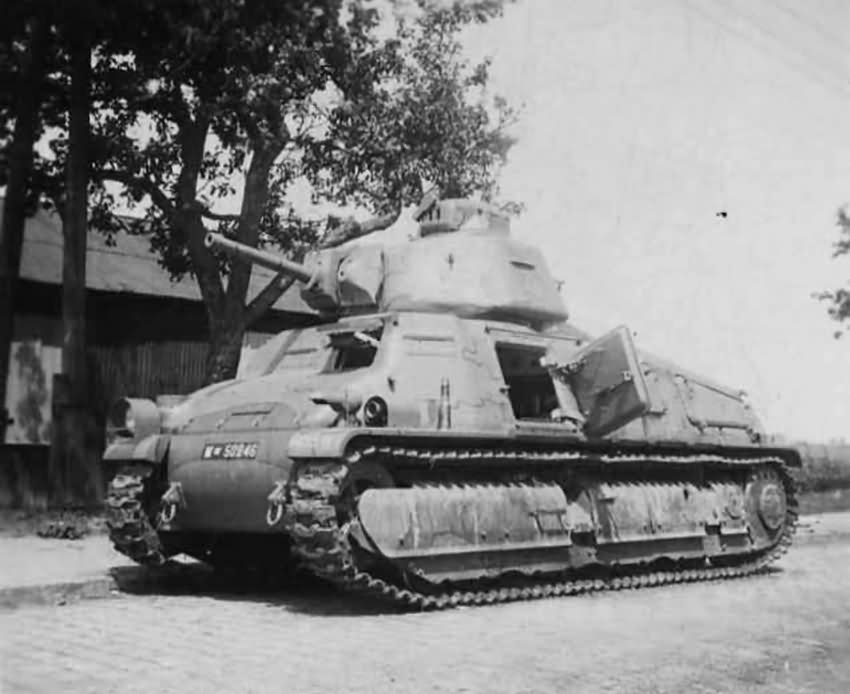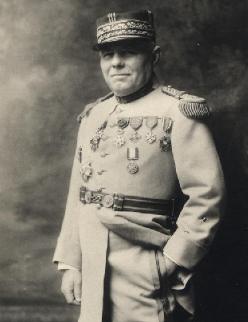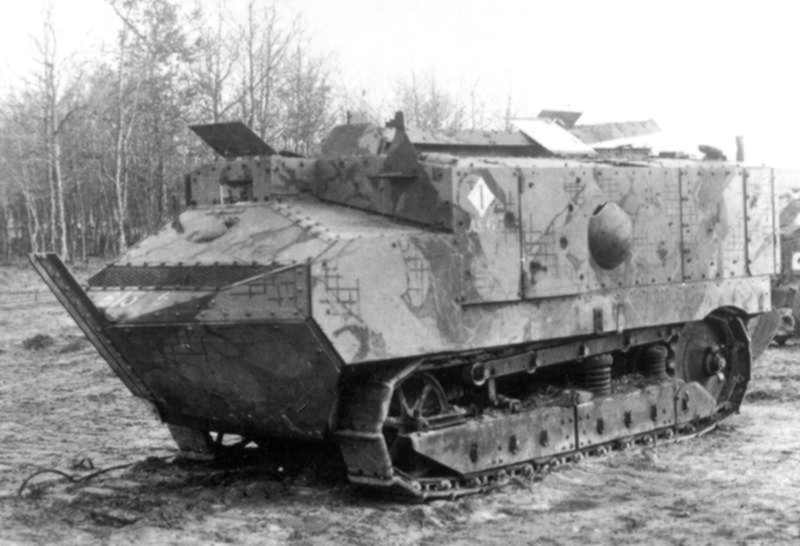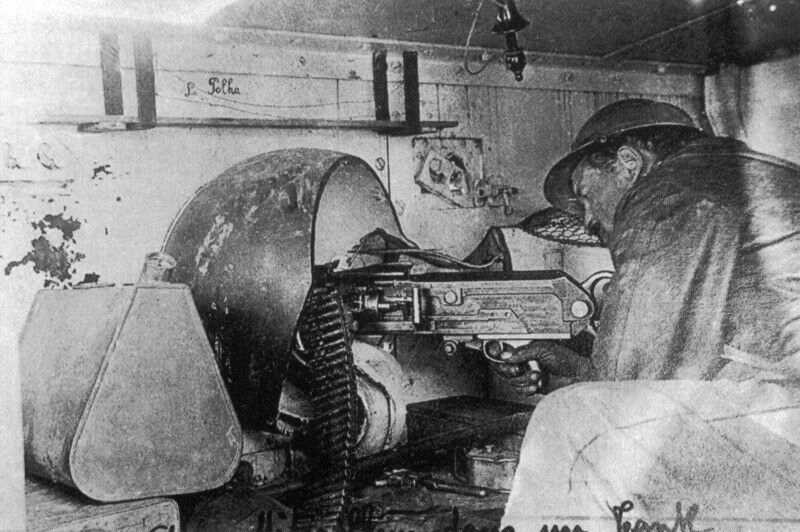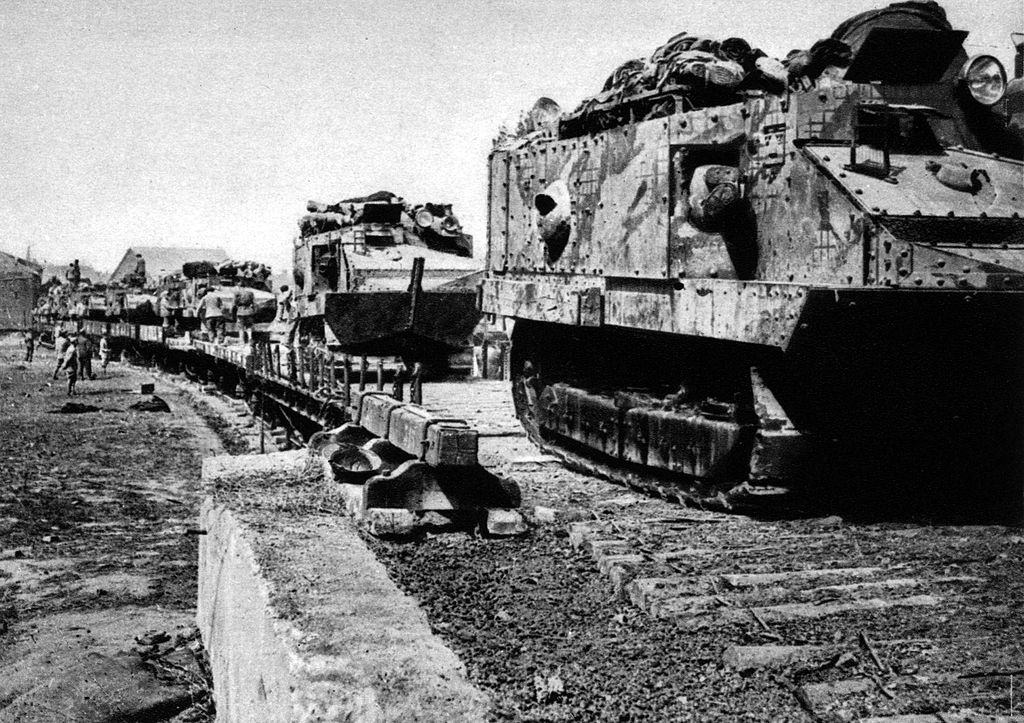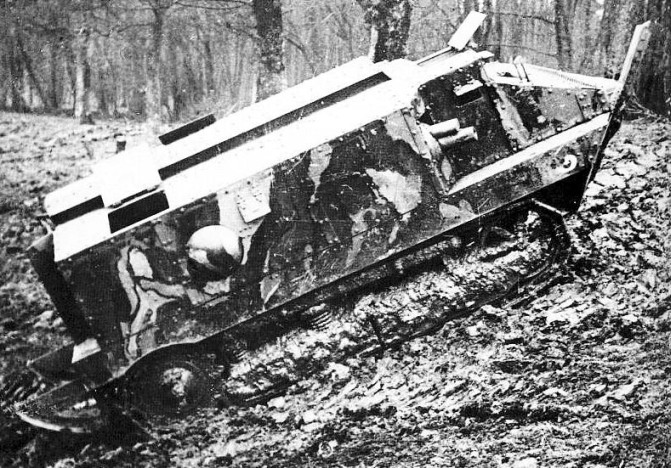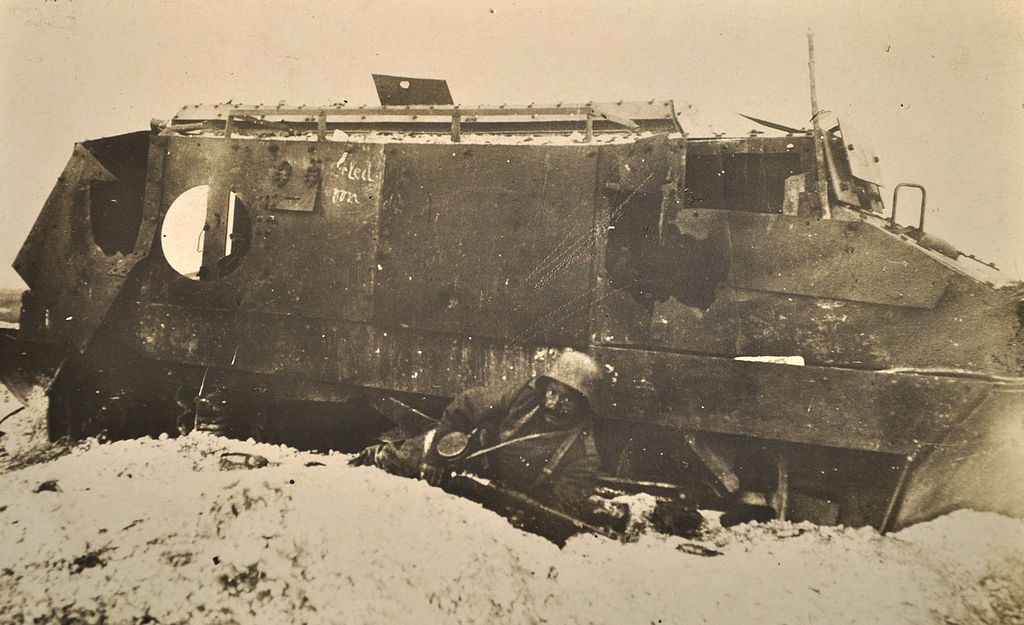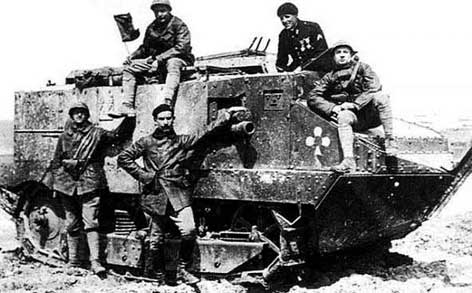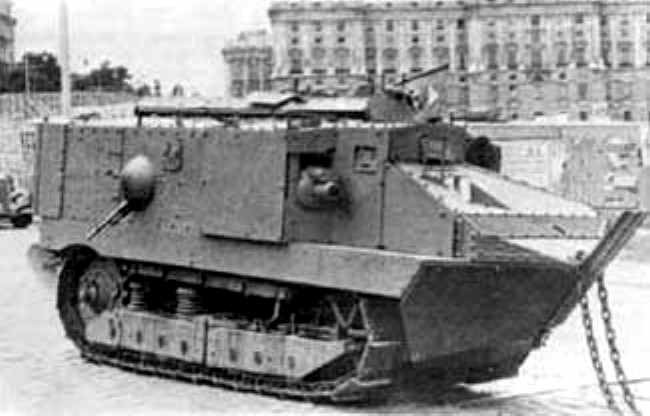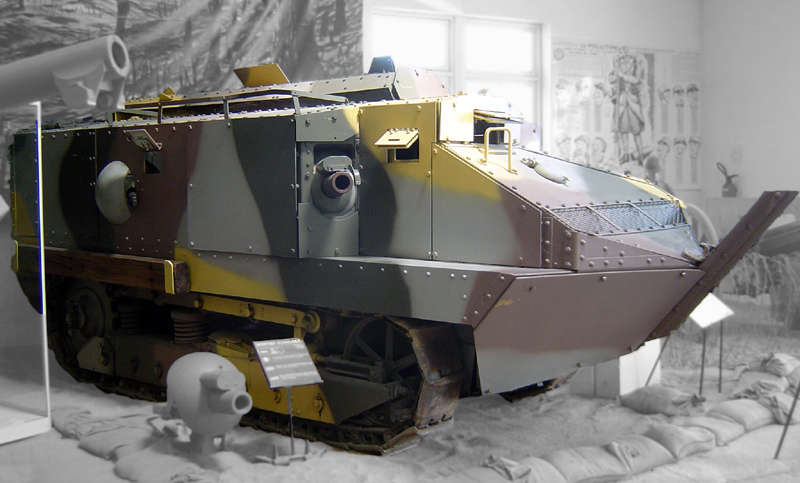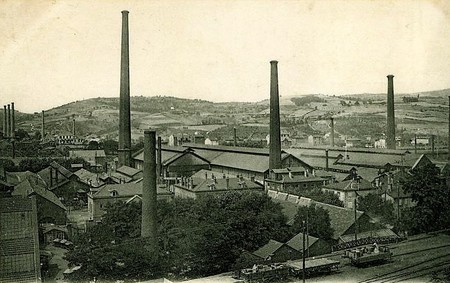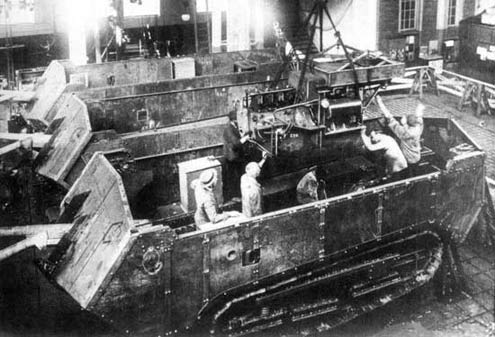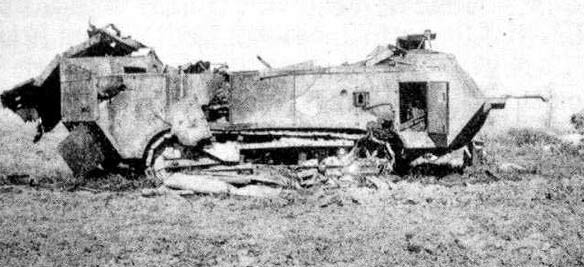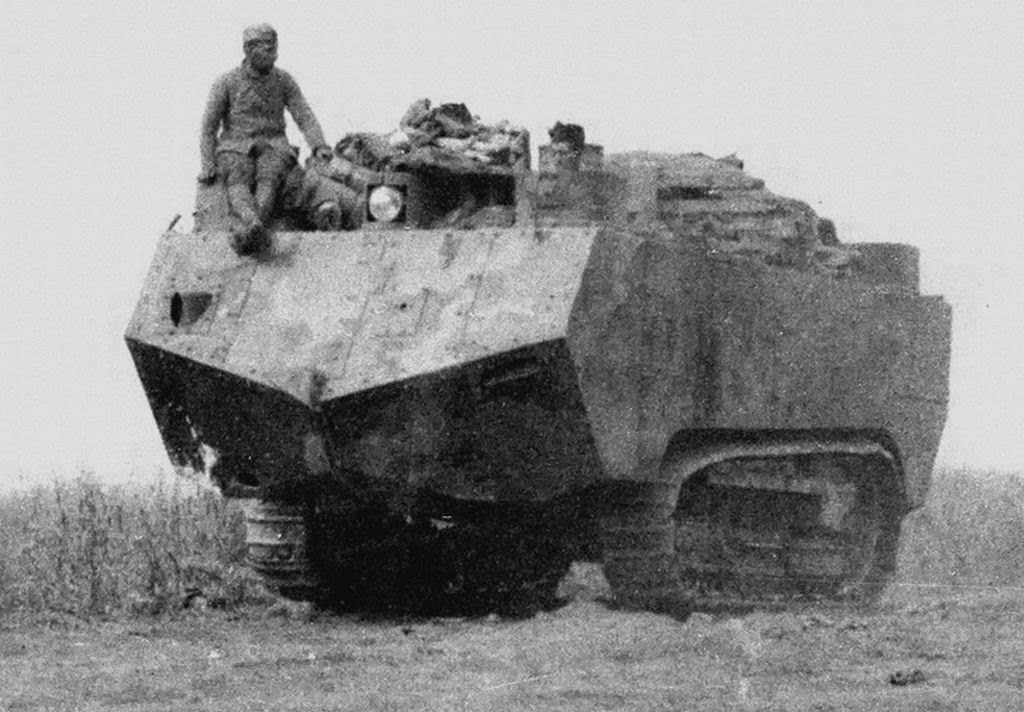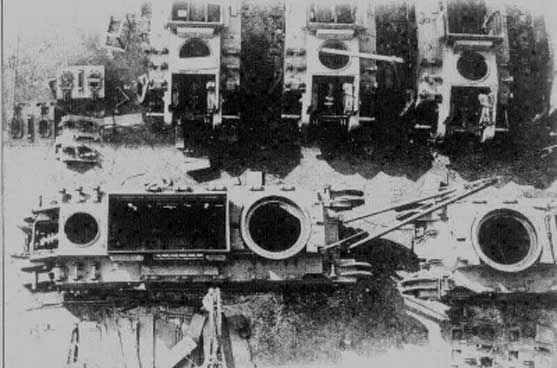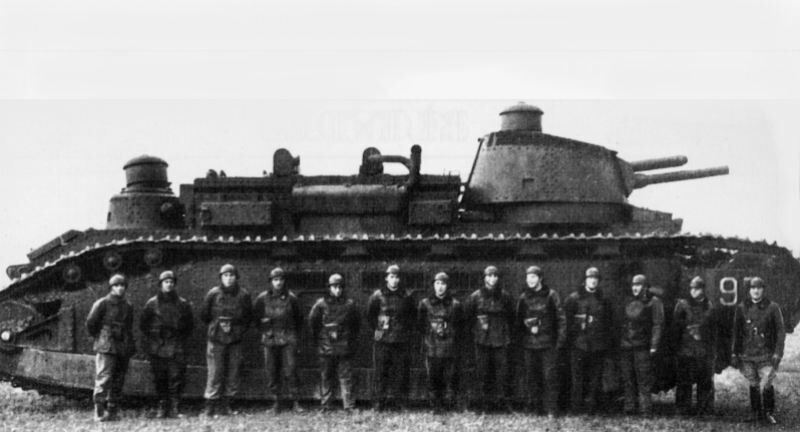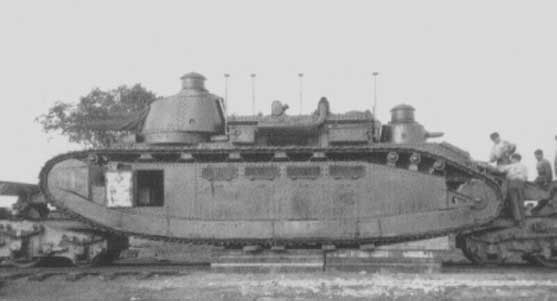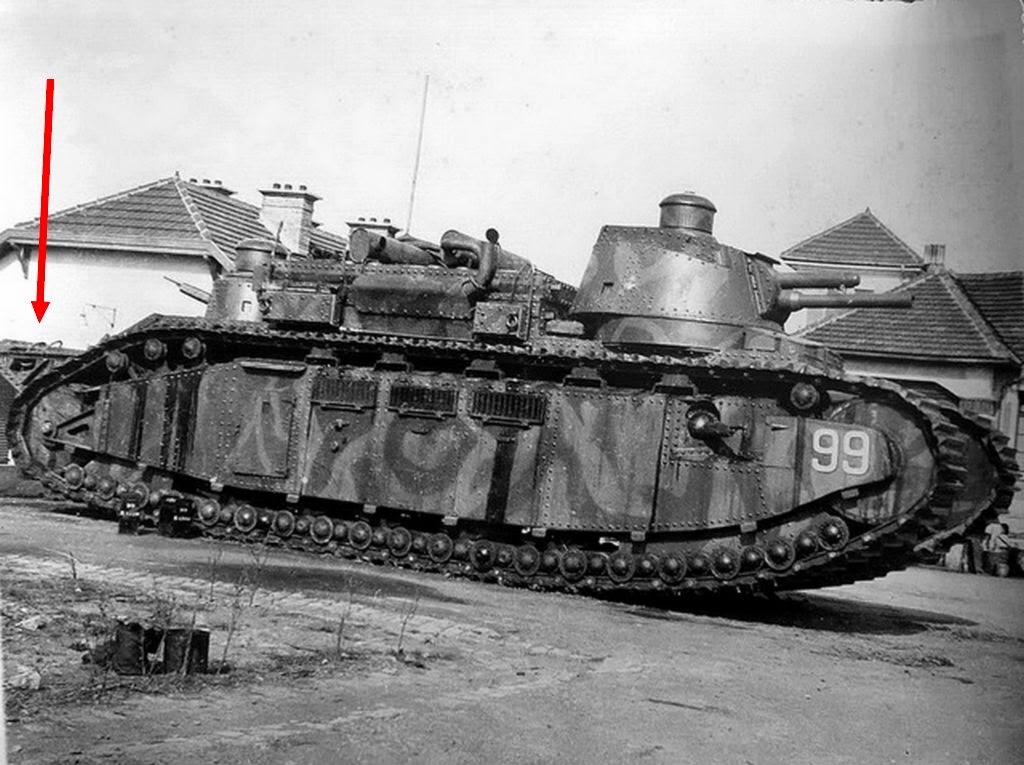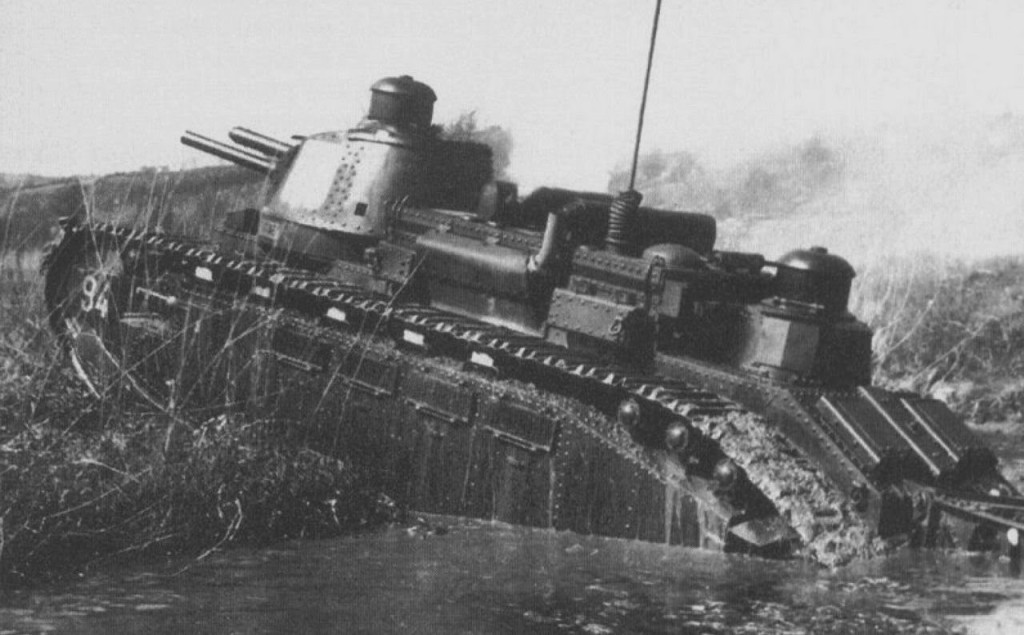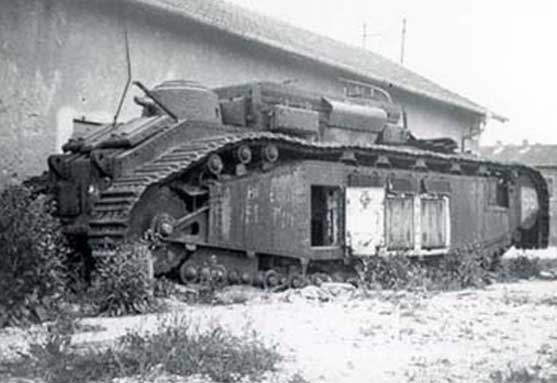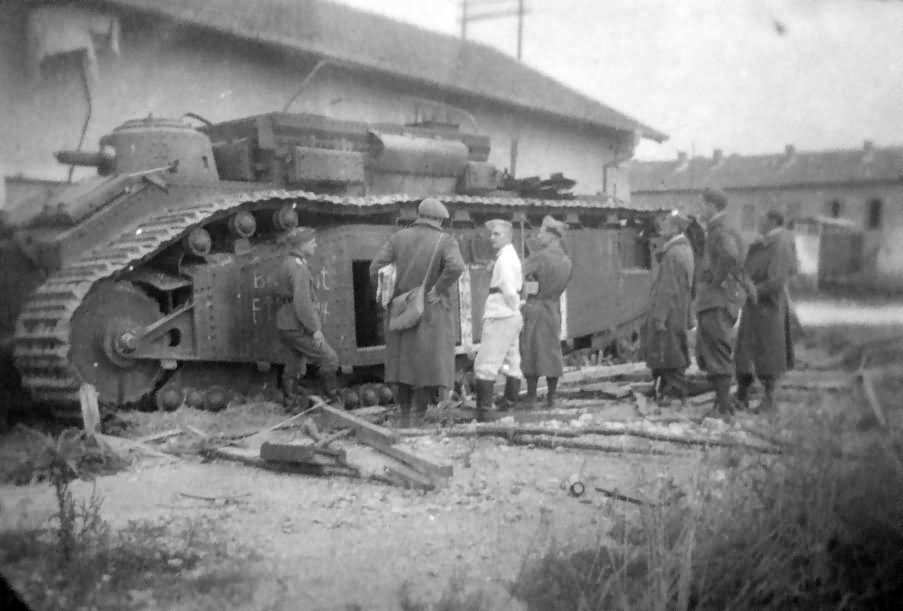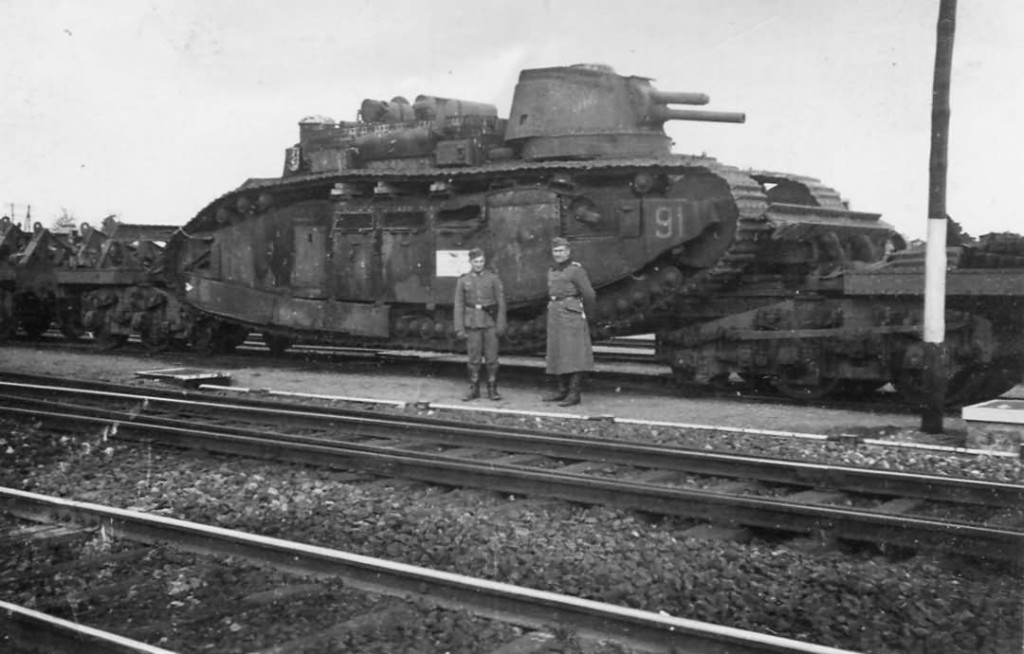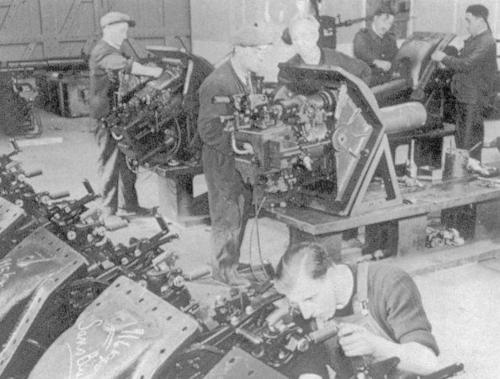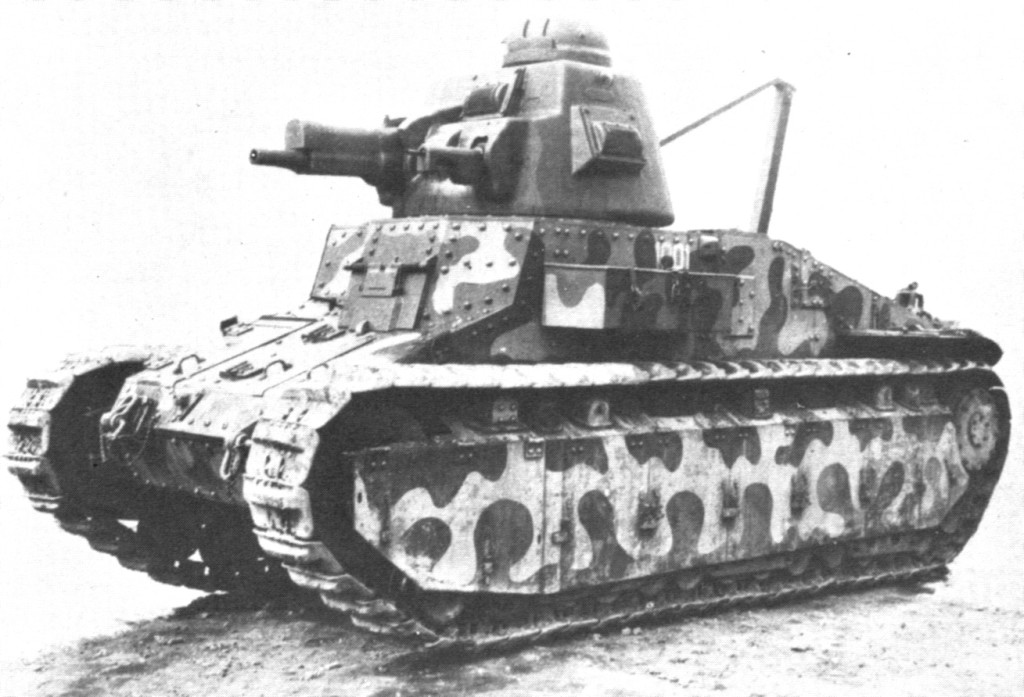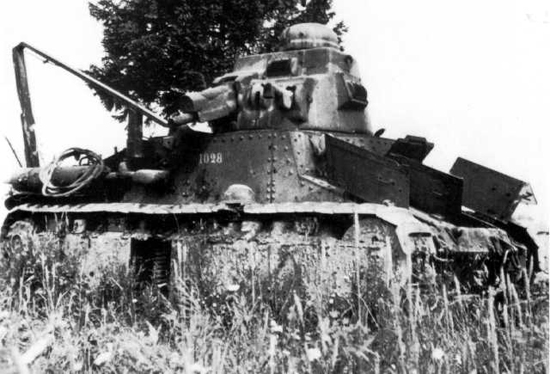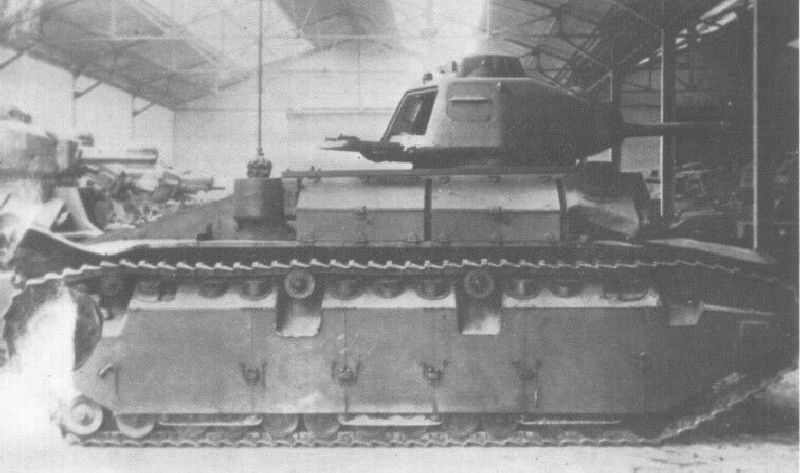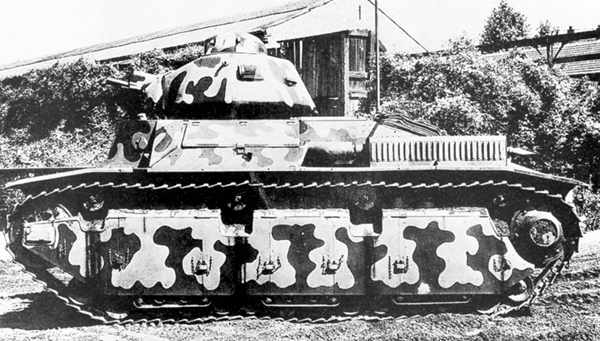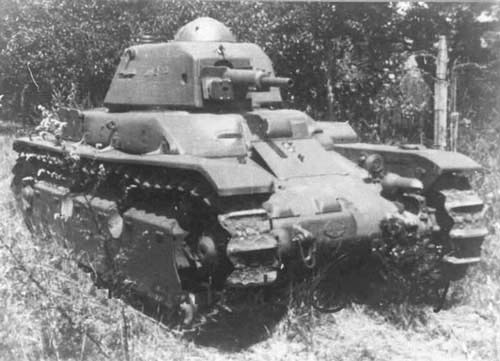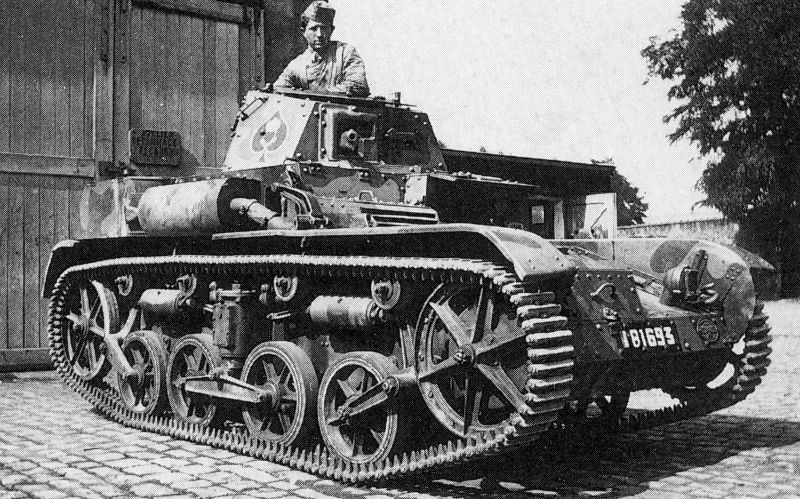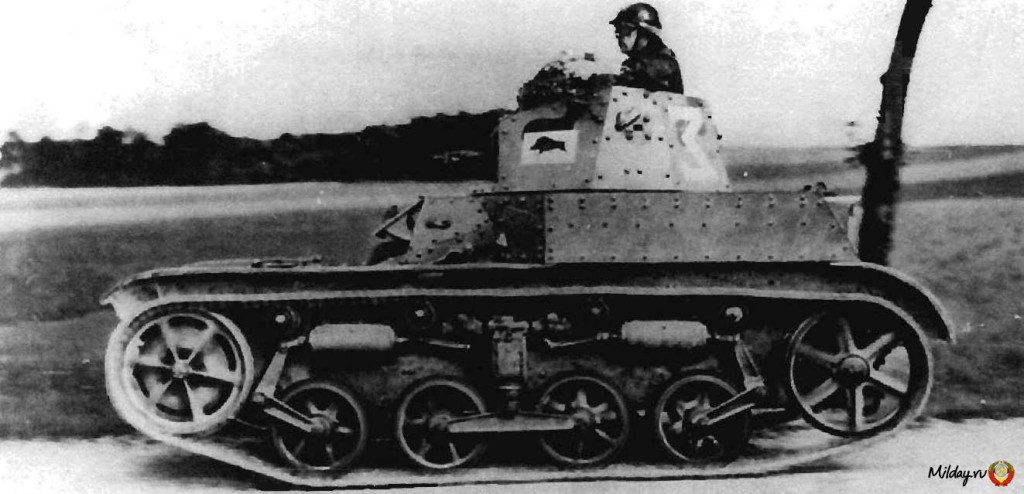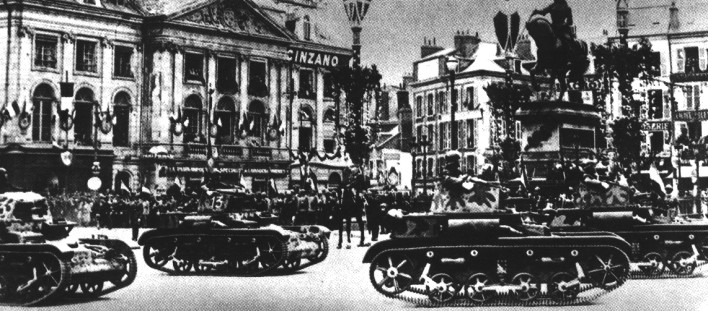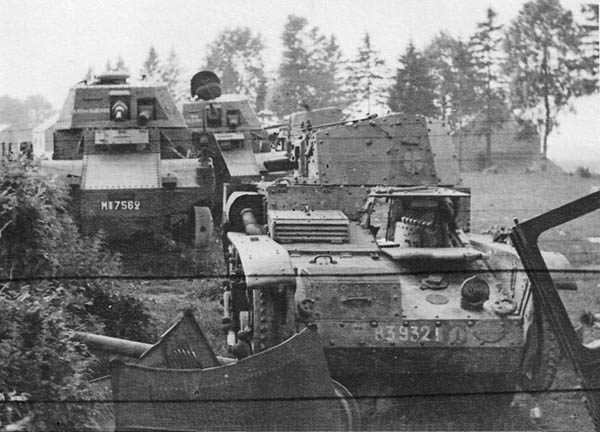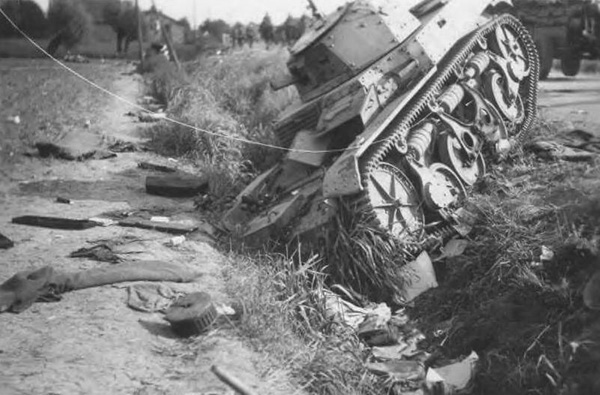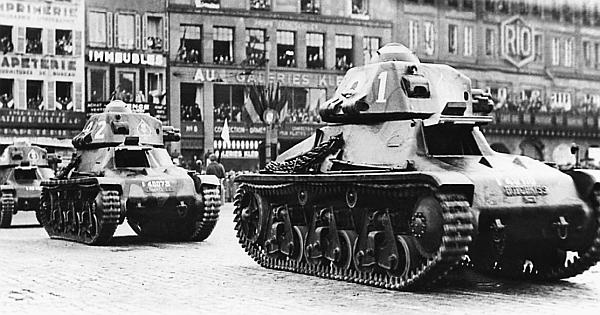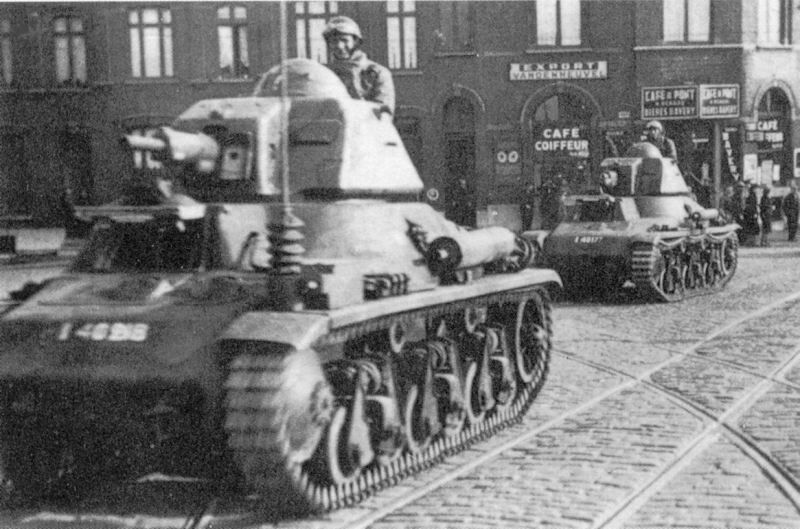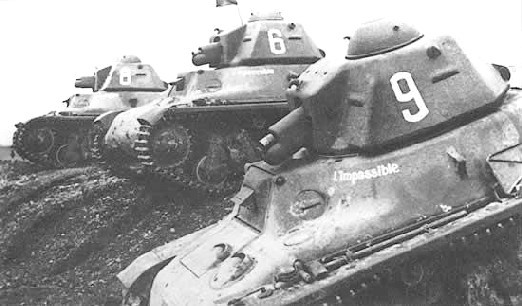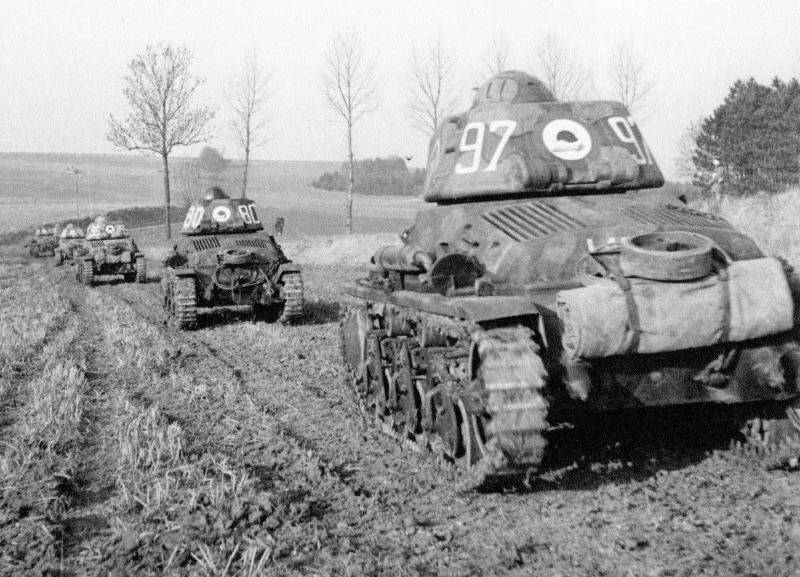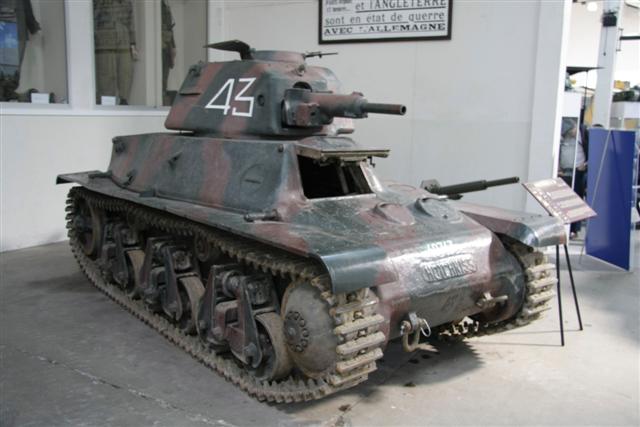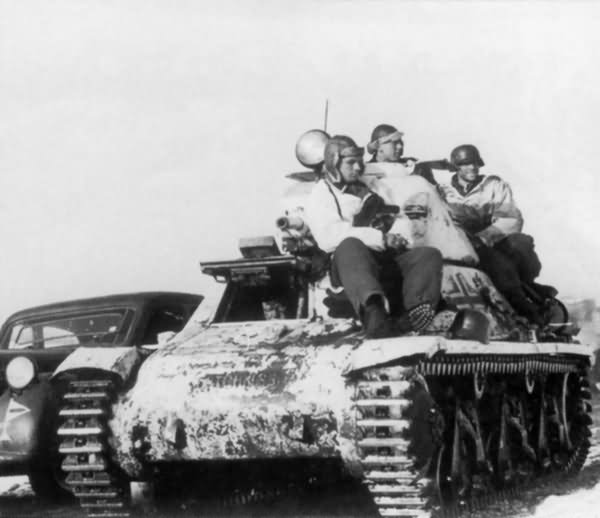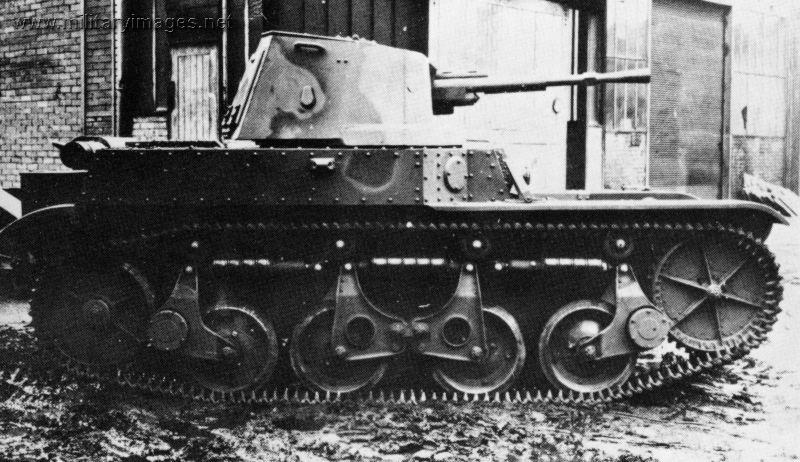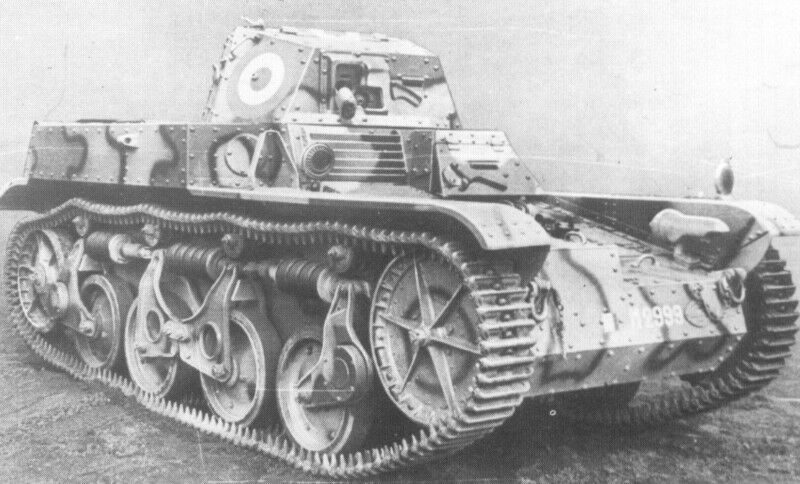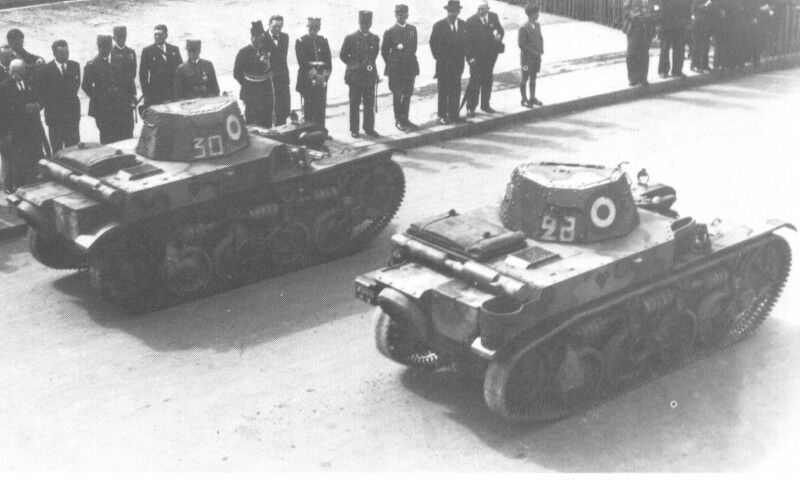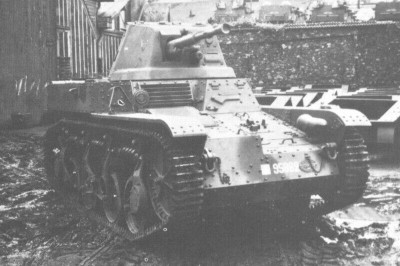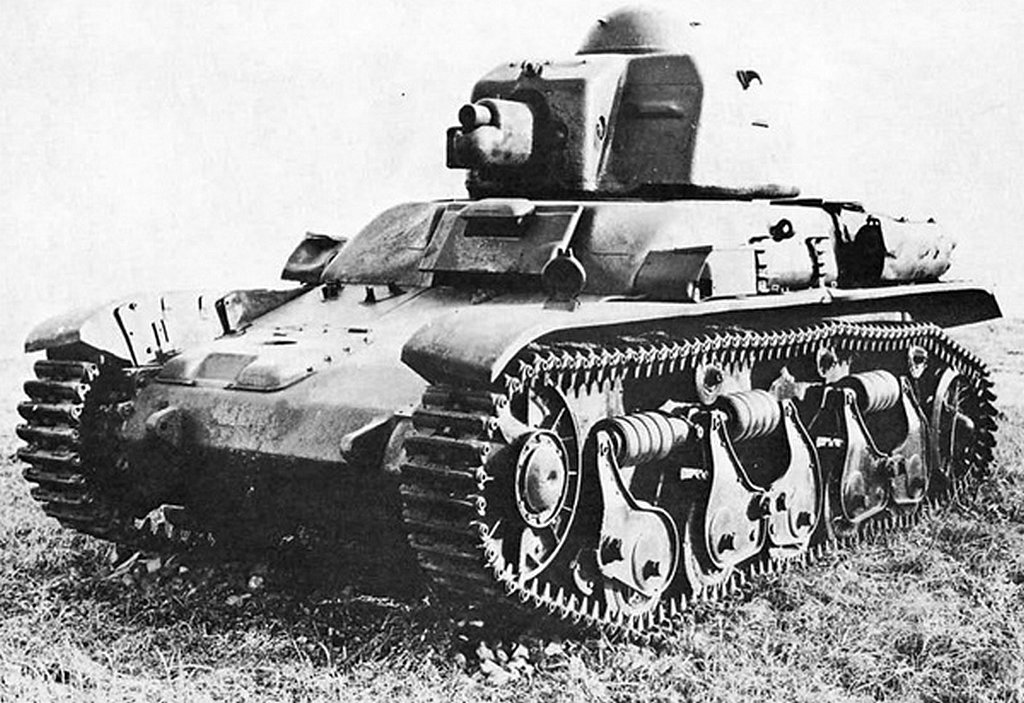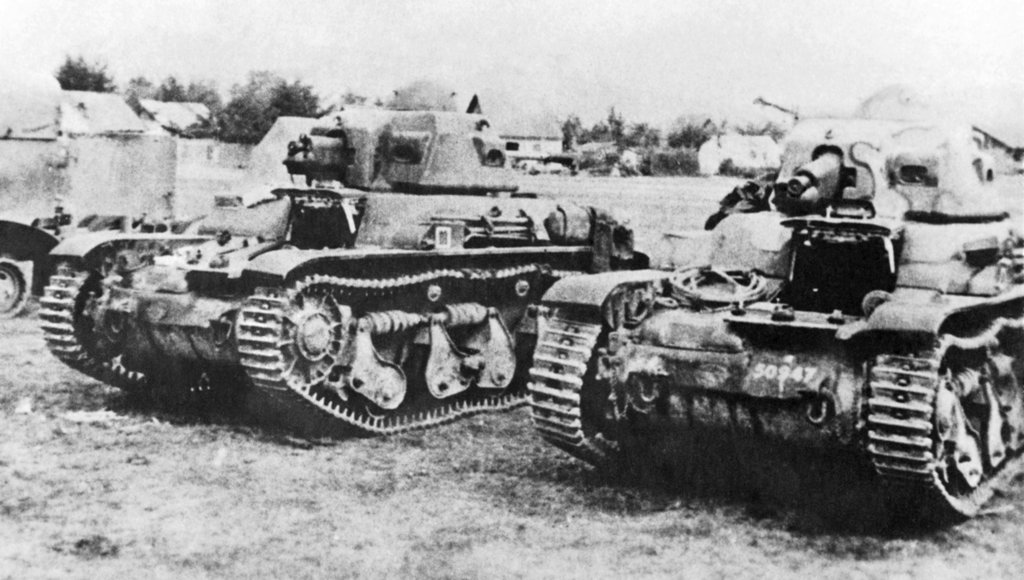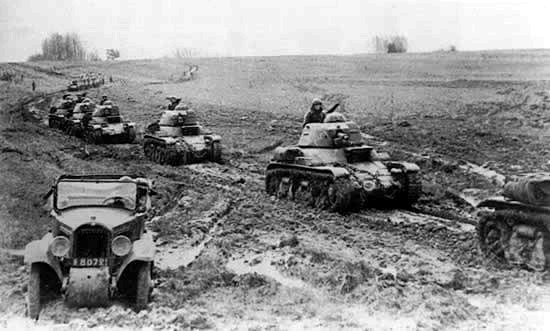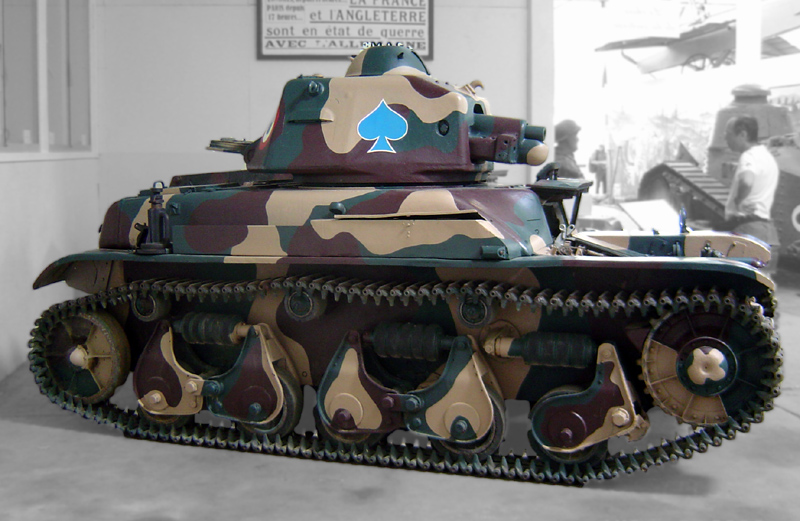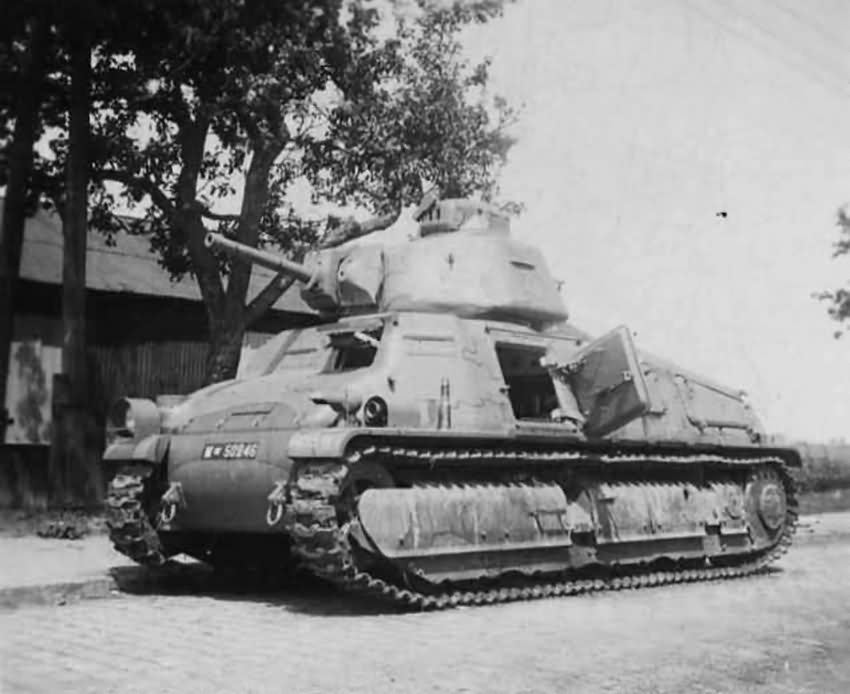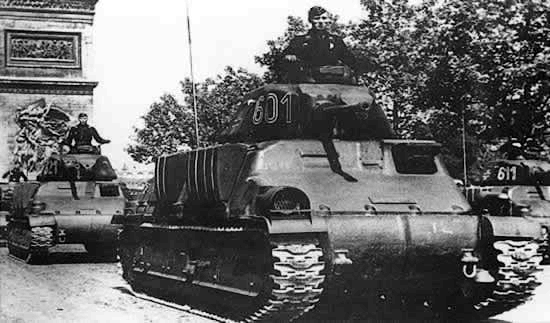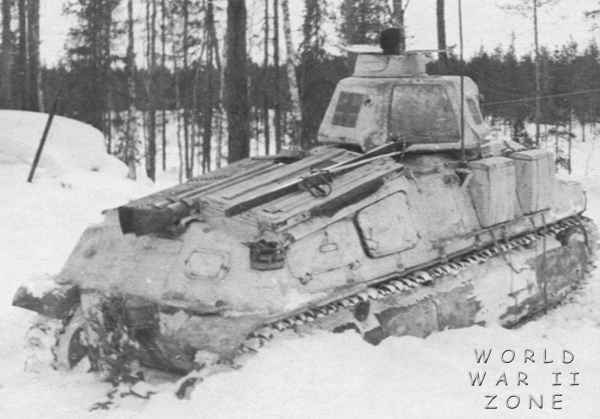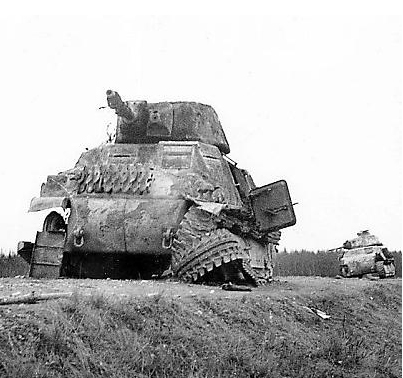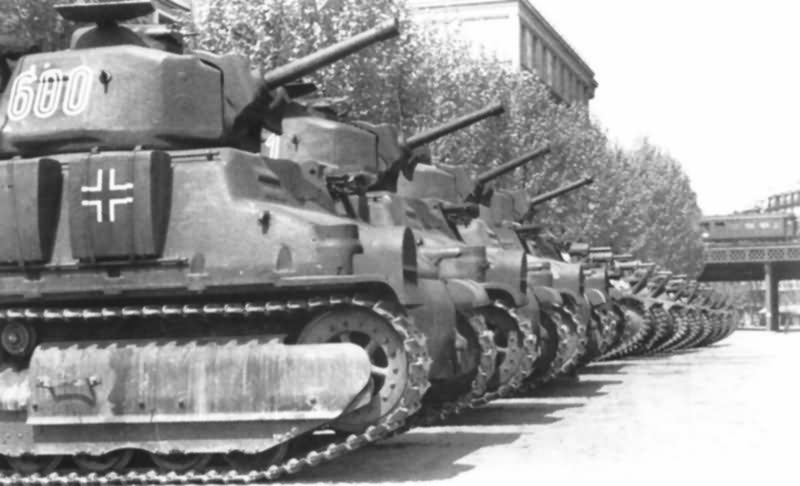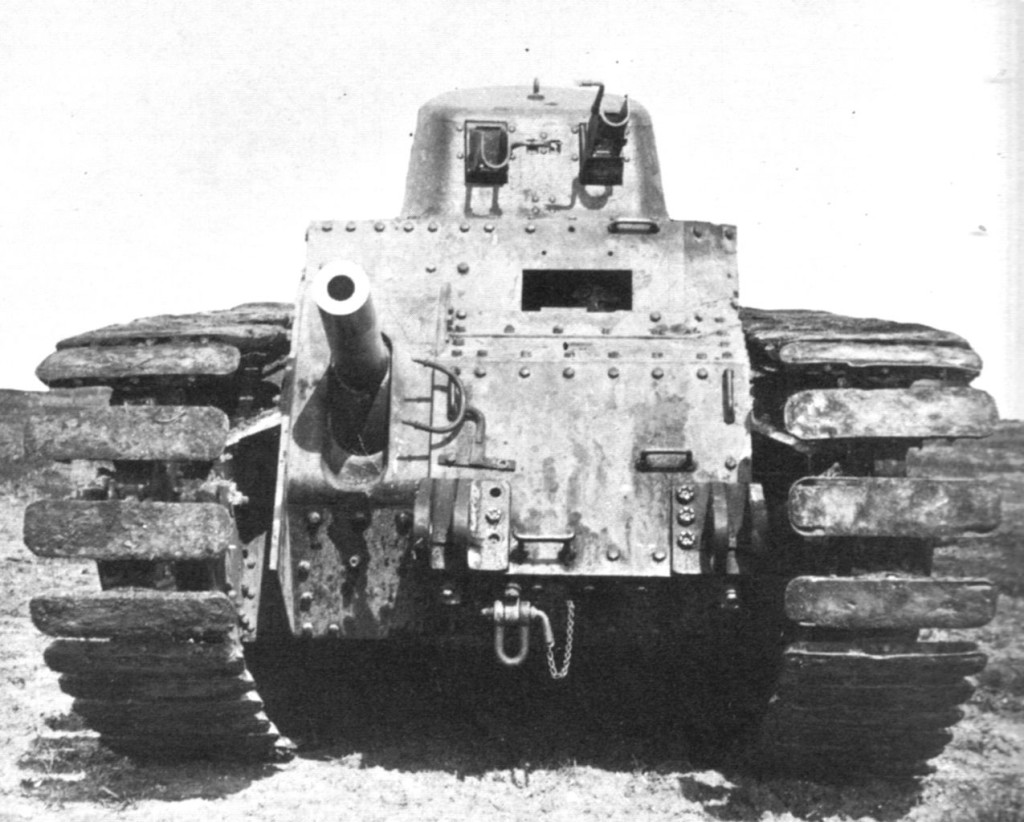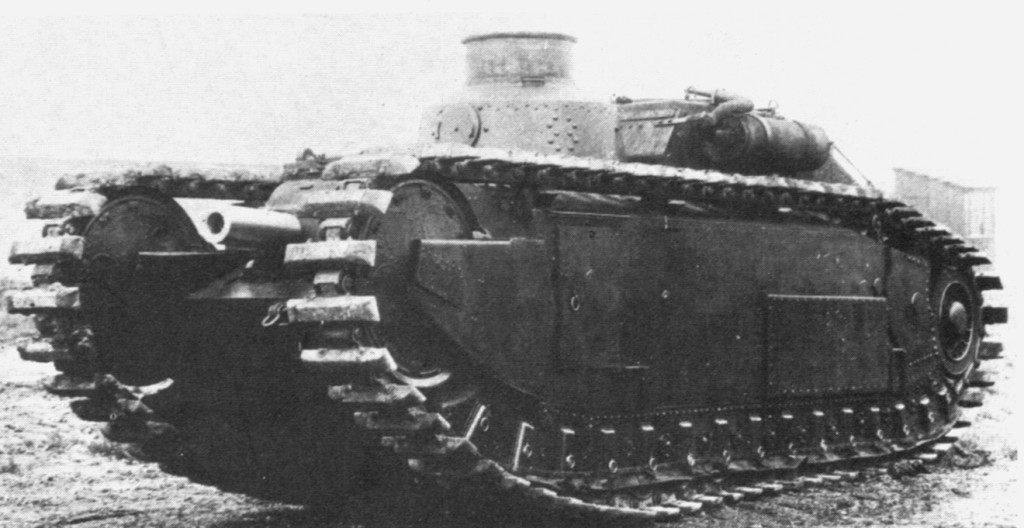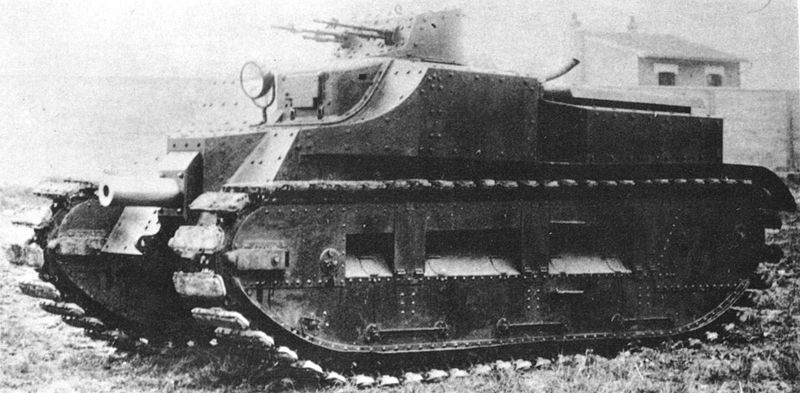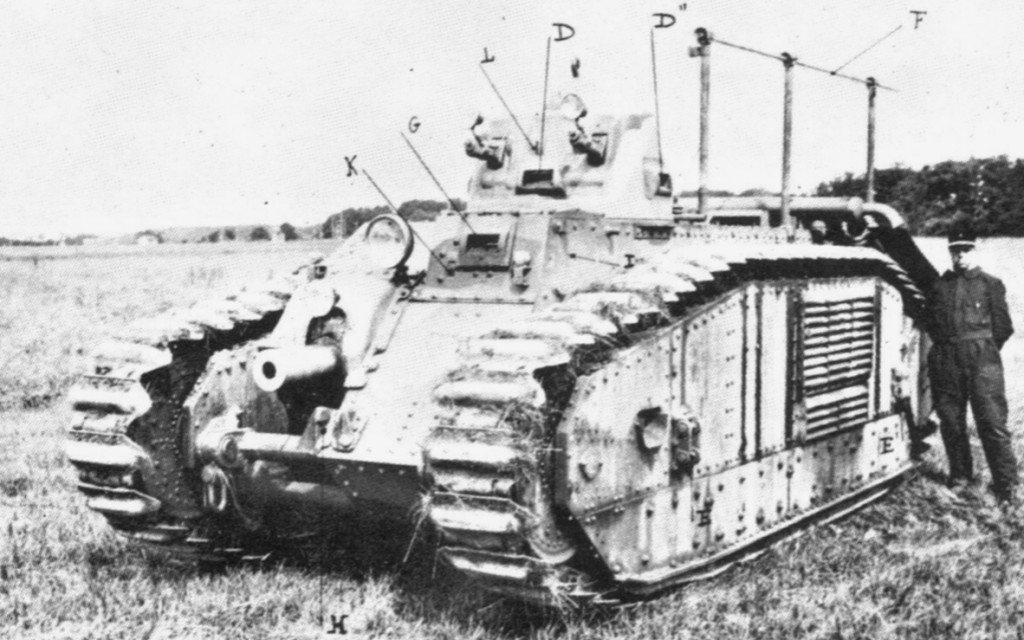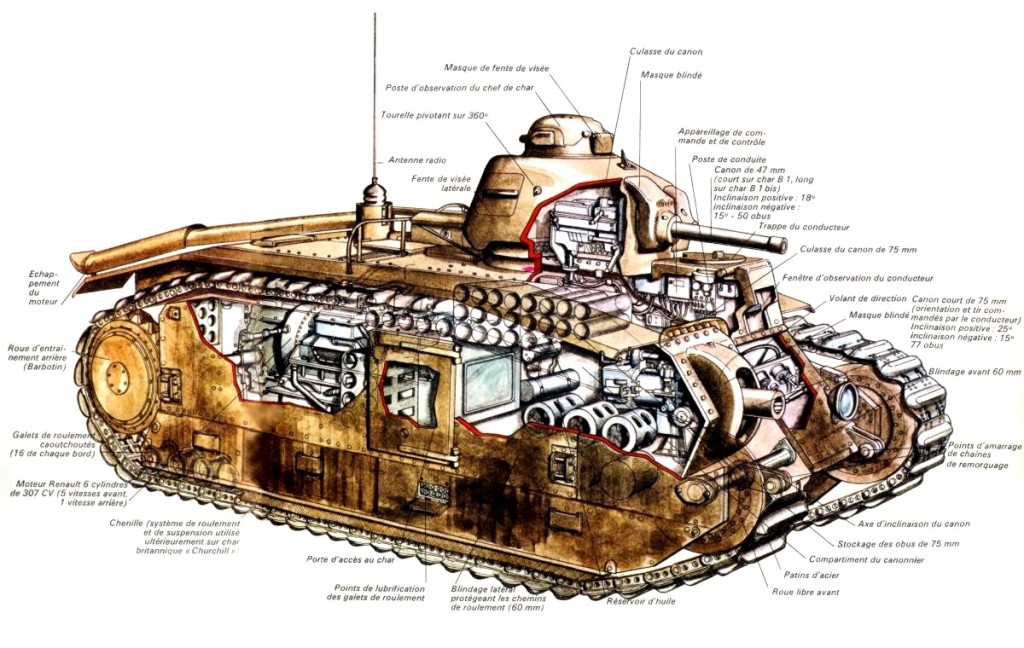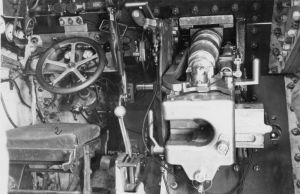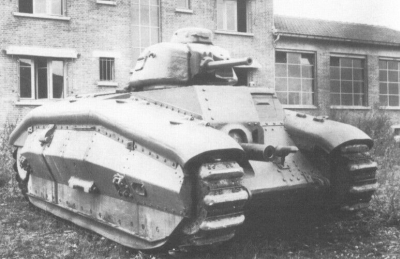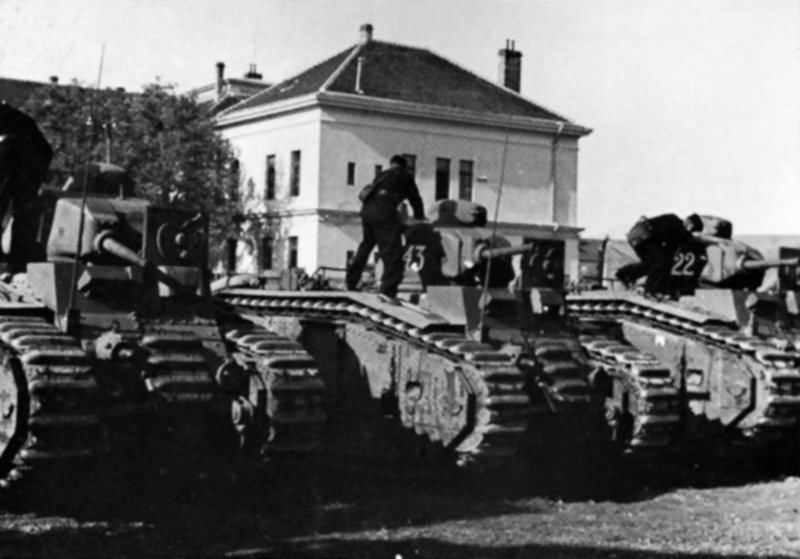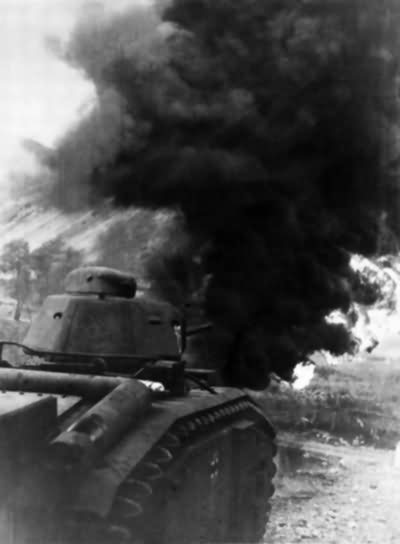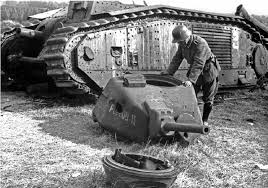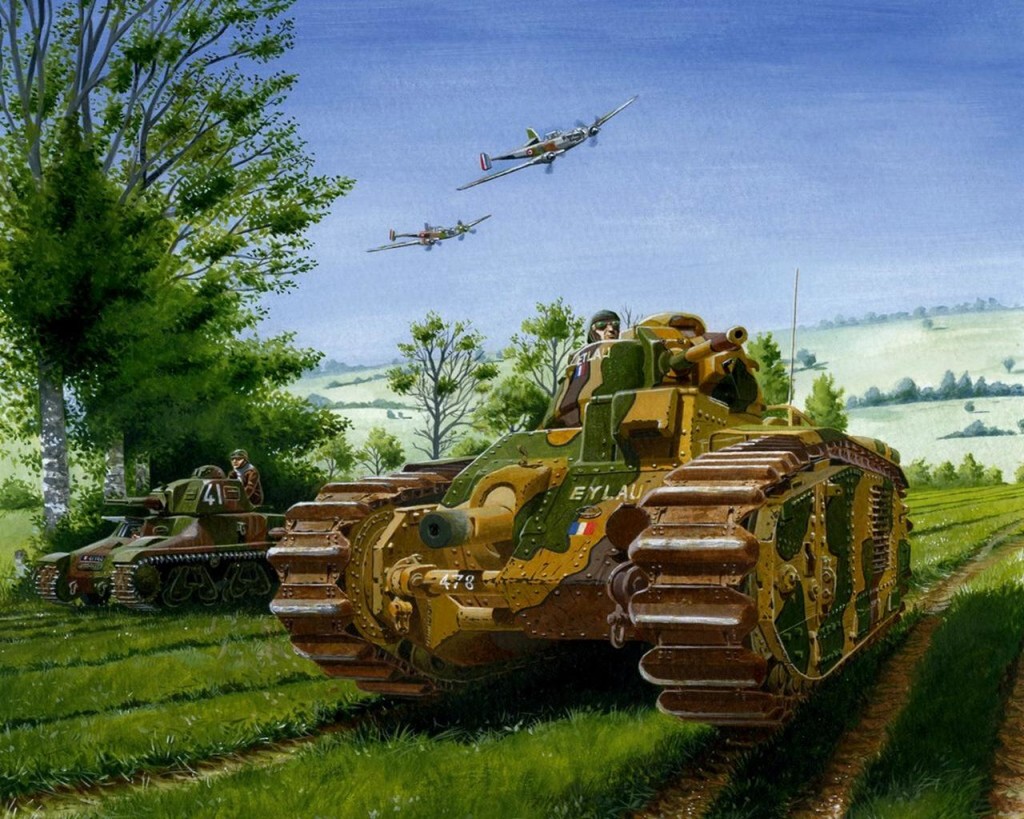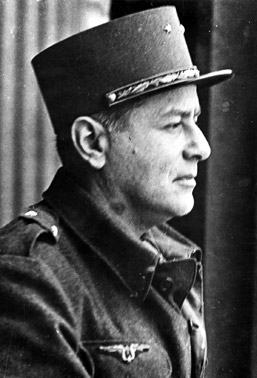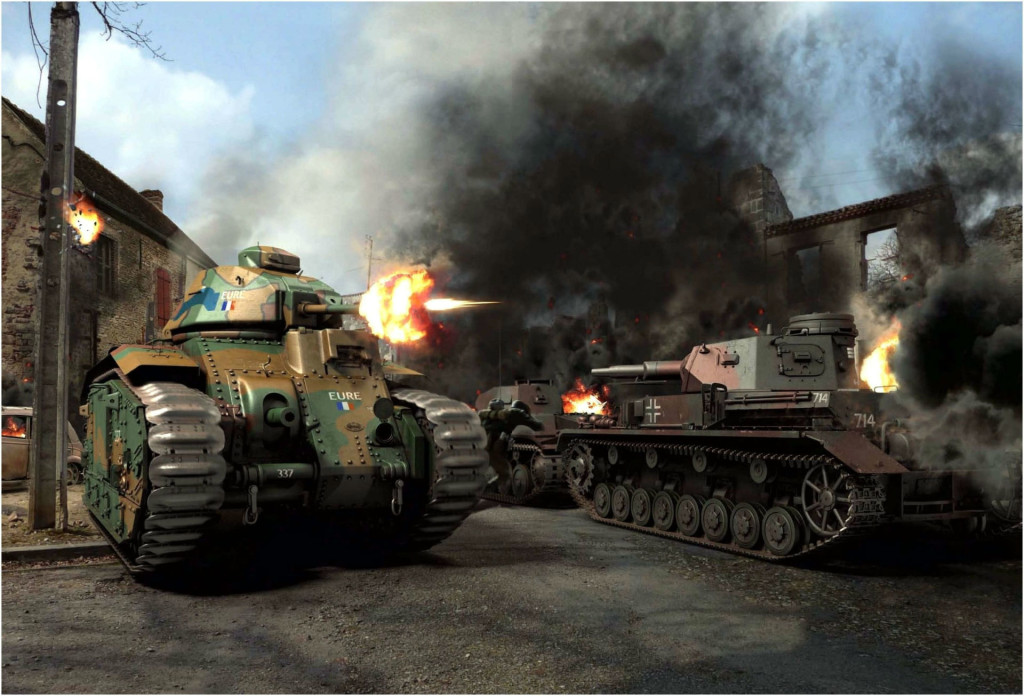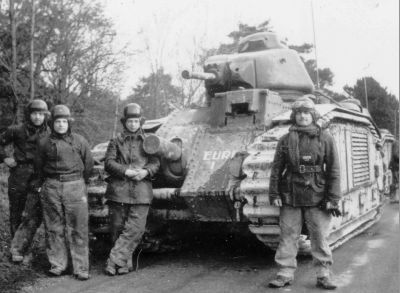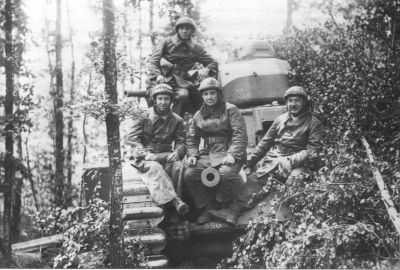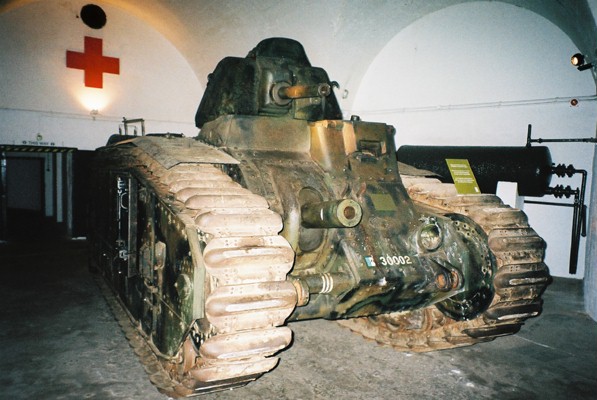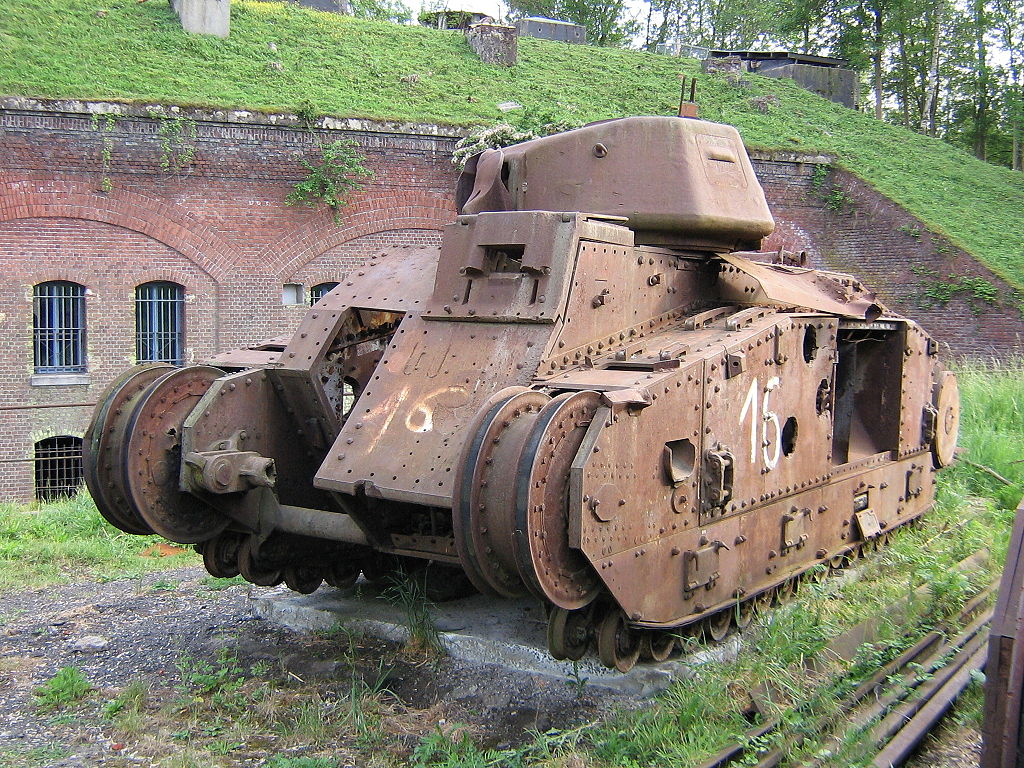As with Britian, French tank design entered a period of hiatus through the 1920’s. Nevertheless, the French Tanks of the Interwar Decades were as good as any designed and built elsewhere in the world, and one in particular, the Souma S35, was perhaps the best tank available anywhere in 1939. In this Post, we’ll walk through French Tanks as of the end of World War One, and then take a look at the French Tanks of the Interwar Decades.
Please note: here and there within this post are snippets of alternative history related to Finland. Any mention of French tanks in use in Finland is fictional, although the remainder of the content is historically accurate. Also, I’ve left out French tank models that were only produced in small numbers or as prototypes.
The French Tanks of World War One
During World War One, France too developed its own tracked Armoured Fighting Vehicles at about the same time as Britain, but the situation there was rather different to Britain’s. In Britain a single committee had coordinated design, and had to overcome the initial resistance of the Army, while the major industries remained passive. Almost all production effort was thus concentrated into the Mark I and its direct successors, all very similar in shape. In France, on the other hand, there were multiple and conflicting lines of development which resulted in three quite disparate production types. The two original French tank designs, the St-Chamond and the Schneider-CA, proved to be flawed. The last of the three, the Renault-FT, pioneered the classic tank configuration which has remained the basis of tank design up to today.
The Renault FT-17 was the first tank to incorporate a top-mounted turret with full 360º traverse capability and was designed with a layout that has been followed by almost all designs ever since: driver at the front; main armament in a fully rotating turret on top; engine at the rear. Previous tank models had been “box tanks”; a single crowded space combining the engine room, fighting compartment, ammunition stock and driver’s cabin. The FT would have the largest production run of any tank of WW1, with over 3,700 built, more numerous than all British tanks combined.
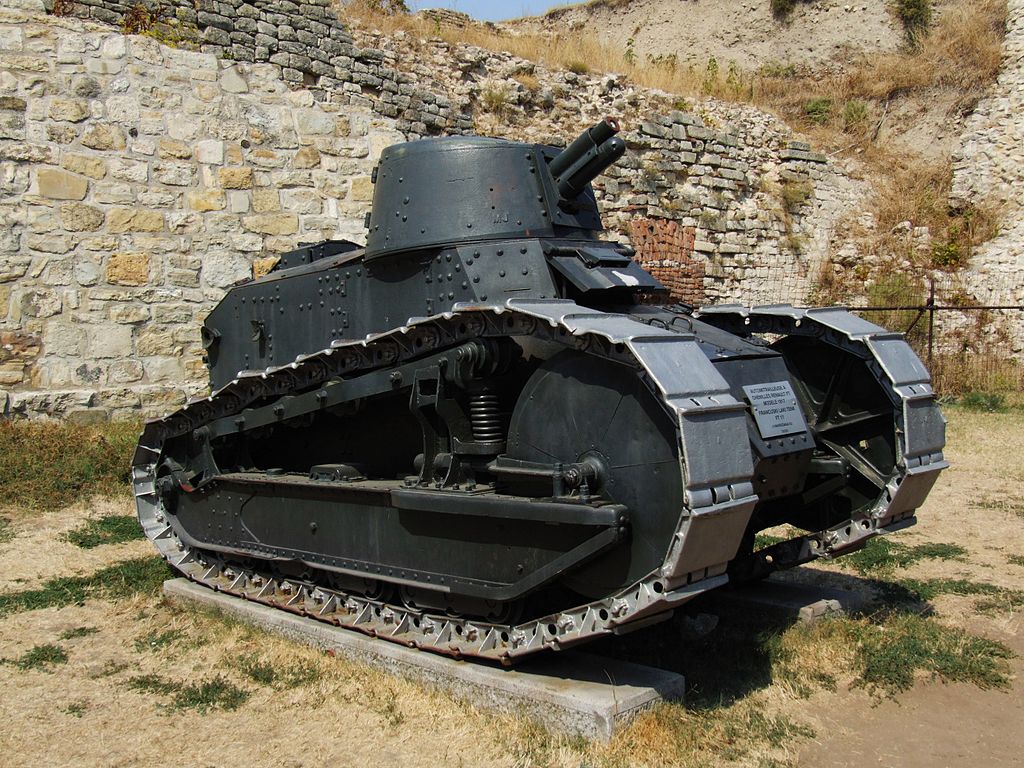
The Renault FT-17 – the WW1 tank that pioneered the classic tank configuration which has remained the basis of tank design up to today
The Renault FT-17 has already been covered in some detail – suffice it to reiterate that the large fleet of Renault FT-17 tanks with which the French Army ended WW1 would remain the mainstay of the French armoured forces through to the mid-1930’s, when they began to be rapidly replaced with a mixed force of light tanks across both the Infantry and Cavalry branches of the Army, as well as with medium and heavy tanks. The Infantry light tanks included the Renault R 35 (which followed the FT 17 concept closely with its small size, two-man crew and short 37 mm gun armament. albeit heavily armored). The cavalry had the similar Hotchkiss H 35, armed with the same 37 mm gun, as well as light recon tanks such as the AMR 35.
France also produced arguably the best tank of the 1930’s, the SOMUA S35. This tank equipped the armoured divisions of the Cavalry and was probably the best combination of armour, firepower and mobility prior to the appearance of the German PzKpfw IV Ausf. F2 and the Soviet T-34. The SOUMA S35 had a long 47 mm gun that could kill any tank then in service, as well as heavy cast armour and good speed. The French Char B main battle tank was also a formidable heavy tank, with cast and riveted armour, the same long 47 mm gun as the S 35, and in addition a hull-mounted 75 mm howitzer. All Char Bs were equipped with radios and the tank was nearly invulnerable to most tank guns and towed antitank guns.
In general, French tanks of the 1930s were well-armoured, innovative vehicles that owed little to foreign designs. However, the light tanks lacked firepower and almost all French tanks were crippled by their one-man turrets. Even the vaunted Char B had a commander who was tasked with commanding the vehicle as well as loading and aiming the turret gun. If he were a platoon leader or company commander, he had the additional tasks of controlling his other units. Such a heavy set of tasks was overwhelming, greatly reducing the effectiveness of the tanks.
The lack of radios for the light tanks was not seen as a major drawback, since French doctrine called for slow-paced, deliberate manoeuvers in close conformance to plans: the “Methodical Battle” concept, adopted because wargaming showed it to be superior. The role of small unit leaders was to execute plans, not to take the initiative in combat. This was nearly the opposite of German doctrine, which stressed initiative and decision-making at low command levels (Auftragstaktik). In 1939 a belated effort was made to improve flexibility and increase the number of radios but overall the French general staff failed in defining an effective military doctrine regarding the use of tanks.
In the post, I’ll look more or less briefly at those French tanks in service in 1919 followed by an overview of French tanks from 1919 through to the outbreak of WW2, with an emphasis on those tanks that were produced in reasonably large numbers and thus potentially available for export.
The Char Schneider CA
Schneider, a major French arms producer, took the lead in French tank design and in December 1915 demonstrated a prototype tank based on a Baby Holt tractor to the French Army. Among the onlookers was Colonel Jean Baptiste Eugène Estienne — an artilleryman and engineer held in high regard throughout the French army for his technical and tactical expertise. On 12 December 1915 Col. Estienne presented to the High Command a plan for the creation of an armoured force; strong French Army support for tanks would be a constant during the decades to come. For Estienne, the Schneider prototype demonstrated the practicality of using tracked armoured vehicles to move infantry, equipment and cannon over the battlefield.
Although Schneider’s project had been underway prior to Estienne’s involvement, Estienne’s played a decisive rôle in getting the Schneider tank into production (although actual completion was entrusted to a ministerial bureau headed by General Léon Augustin Jean Marie Mourret, director of the Army automobile service. Mourret did not closely cooperate with Estienne, who was largely excluded from decisions of a technical nature). In February 1916 successful tests were held and the War Ministry ordered the production of four hundred tracteurs-chenilles type Schneider & Cie blindés (“tracked and armoured tractors of the Schneider type”), at a price of 56,000 French francs per vehicle.
To the modern eye, the Schneider CA tank is barely recognizable as a tank, looking much more like an armoured steel box resting on top of a caterpillar tractor. It has no turret, and its inconspicuous main armament is a fortification 75 mm Blockhaus Schneider, placed in a barbette in the right front corner of the tank. The right side had been chosen because the gunner had to stand to the left of the barrel to operate the gun. The cannon type was developed from a 75 mm trench mortar adapted to fire from a fixed fortification position by adding a recoil compensator and a gun shield. This short-barrelled cannon had a length of just 9.5 calibres and fired the standard French HE Model 1915 75 mm shell with a reduced propelling charge, shortening the length of the round from 350 to 241 millimetres and giving a muzzle velocity of only two hundred metres per second.
While this limited the maximum range to 2,200 metres, the practical range was only 600 metres and the tank needed to close within 200 metres of a target to allow for precision shooting. The gun had a traverse of 60°, a depression of -10° and an elevation of 30°. The ammunition stock was 90 vertically stowed rounds. To the right of the cannon there is a bin for 20 readily accessible 75 mm rounds. Three other ammunition bins were positioned respectively at the extreme right rear corner (14), to the left of the engine (32) and at the left rear corner (24). Two 8 mm Hotchkiss Model 1914 machine guns projected from the flanks in large hemispherical ballmounts. The right machine gun was, because of the room needed for the main gun, positioned more to the rear than the left one. The machine guns could traverse 106°, had a depression of -45° and an elevation of 20°. A bin at the extreme left corner held 4,000 rounds of 8 mm ammunition but in practice fifty belts with ninety-six rounds each were carried, for a total of 4800 rounds.
Another unusual feature is the slanted overhang of the frontal part of the chassis which has the form of a pointed nose, ending in a high obliquely protruding steel spur. It had been designed for cutting through and crushing down German barbed wire, thus opening passages for following French infantry, originally seen as the primary function of the Schneider CA. This long overhang caused the tank to ditch itself readily. The design is of the so-called “box tank” type, in which the crew, propulsion system and all manner of equipment were not clearly separated. As a result there is no real fighting compartment. The space available to the crew, illuminated by three small electric lights, was entered through a double door at the back of the tank and is extremely cramped. The crew consisted of a commanding officer who was also the driver; an NCO who was the main gunner, two machine gunners, a loader who assisted with both the cannon and the machine guns and a mechanic who doubled as a machine gun loader.
Four of these six men had to crouch inside a 1.5 m (4 ft 11 in) high space between the roof and the tank’s floor. They then had to stand within two narrow troughs, one, behind the driver’s seat, used by the gunner and a second square one more to the back, between the suspension elements, used by the cannon loader and the two machine gunners. Most of the space however, had a height of just three feet between the roof and the covering of transmission and suspension: if the mechanic wanted to assist the right machine gun, he had to lie on his belly to load it. Each Schneider tank team also included three riflemen who functioned as and outside crew; during battle they accompanied the vehicle. All-around protection was provided by 11.4 mm steel plate, later improved by a spaced armour of 5.4/5.5 mm, raising the weight from 12.5 to 13.5 tonnes. The roof had 5.5 mm armour. The plates are partly riveted; the superstructure is largely bolted.
The 60 hp Schneider gasoline engine and its radiator were located in the front part of the tank, to the immediate left of the driver. The four cylinder engine was specially constructed for the Schneider CA with a maximum output of sixty horsepower at 1,000 rpm. The tank’s official top speed was only 8.1 km/h and the practical terrain speed was even lower at 2 to 4 km/h. Two fuel gravity-feed reservoirs placed above the engine below the right front roof and nose plate had a total capacity of 145 litres, giving a practical range of about 50 kilometres, though the official range was 80 kilometres. Steering was generally very tiring and there was a tendency to jump out of gear when the clutch was engaged too forcefully.
As the traverse of the main gun was limited, it had first to be pointed in the general direction of the target by the driver-commander swivelling the entire vehicle. To facilitate this, a small rectangular frame is fitted on the right side of the nose of the tank. Looking through it, the driver had a sightline parallel to that of the cannon in a neutral position. In practice, the commander had a too limited view of his surroundings through the small hatches to his left, front and right and had to resort to lifting his head out of his rectangular top hatch to observe the enemy. Small rectangular hatches, fitted with a vision slit, were positioned to the front of each machine-gun. The main ventilation was provided by a large skylight slit running along the midline of the hull. It is doubly roofed with the lower roof having a second slit in its top, while the higher roof has open lower sides, creating oblique oblong ventilation channels through which fresh air can be sucked in from the outside. The top roof is the highest element of the vehicle. With later production vehicles, polluted air was removed through a broad ventilation grid in the nose, having a recessed armour plate below it. To the left and the right of the skylight roof rectangular escape hatches are present in the hull top.
Schneider CA’s in Battle
By January 1917, 32 Schenider’s had been delivered from the order of 400 for which delivery had been contracted to for November 1916. By January 1917 production had picked up to 3 to 4 units per day and by 1 June, 322 Schenider tanks had been delivered. During production, the Schneider’s design was gradually and progressively improved, which caused further delays. Starting from July 1916, tank crews began to be trained, many of these men were volunteers. Their first instruction consisting of the basics of maintenance and a lot of driver training with an emphasis on crossing trenches, avoiding shell craters and running down trees and walls. Because at first no actual Schneider vehicles were available, Holt tractors were used instead. The training camps that were set up included tank workshops and 64 Schneiders were allocated purerly for training purposes and to limit the wear on combat vehicles.
The French Army did not intend to create an independent tank force; the tank units would be part of the Artillery Arm. Each group consisted of four batteries, each battery again of four tanks. This would have resulted in a total of sixteen tanks and indeed this was the official organic strength of an AS, but the fourth battery was normally a depot unit, intended to provide replacement vehicles and crews for the other three batteries. It had an official allotment of three tanks and the total matériel strength of an AS was thus fifteen. Actual operational strength varied wildly, due to frequent breakdowns. The personnel strength consisted of twelve officers — each commanding a tank of the three regular batteries — sixteen NCOs and 110 men of lower rank. In practice often four batteries of three tanks were fielded, to allow for a greater tactical flexibility.
Estienne had hoped to create a powerful and large striking force before committing his tanks to battle. He had strongly disapproved of the, in his eyes premature, British use of tanks in September 1916, just two months after first deliveries of the Mark I. However, political circumstances would compel him to deploy the Artillerie Spéciale before it was at full strength or adequately trained. On the morning of 16 April 1917 the Nivelle Offensive was launched with a heavy commitment of Schneider tanks, with Berry-au-Bac being their first major engagement. The Schneiders penetrated several miles but lost their accompanying infantry and had their numbers whittled down before withdrawing, in the process of which they suffered further losses from artillery fire. Their losses were heavy: 76 of the 128 combat tanks engaged had been lost and many of those lost had burned.
Despite the general failure of the Nivelle Offensive and the ensuing mutinies, the French High Command attempted another offensive in May 1917 at Moulin-de-Laffaux. Tanks were again used, this time in conjunction with an infantry battalion specially trained in combined arms tactics, the 17e Bataillon de Chasseurs à Pied. Coordination with the artillery was improved by attaching a special observation plane, protected by six SPAD VII fighters, whose task was to identify German antitank-batteries and have them destroyed by counterbattery fire; it also had to report the position of the tanks to higher command levels.
While most of the attacks of the offensive were failures, the tank attack on Moulin-de-Laffaux largely attained its objectives. The Schneiders, advancing not in column but “line abreast”, exploited the initial infantry conquest of the first trench by crossing the second and then assisted the foot soldiers in heavy and fluid battles with counterattacking German reserves. Eventually most tanks broke down and had to be left behind by the advancing infantry. The Schneiders had made a good account of themselves. Of thirty-three tanks engaged only five were destroyed. Here we can see the early evolution of modern combined arms warfare, driven by practical lessons rather than theory.
The French High Command considered launching a large-scale summer offensives in 1918, benefiting from a grown number of AFVs. At this point of the war, less than a year after their first employment, the Schneider tanks were already considered obsolete. They nevertheless still formed an essential part of the French tank force with 245 operational in March 1918 and they continued to be used in the ongoing fighting as the German offensives of 1918 were held. By August 1918 only 50 Schneiders were operational, with losses not being replaced.
Schneider CA’s after the First World War
Even before the end of the war, on 6 October 1918 Estienne had proposed to phase out all Schneider tanks from operational units, remove their armament and deploy them as instruction and recovery vehicles. By the end of 1918, all surviving Schneider tanks had been designated utility vehicles. Some of the serviceable Schneiders were rebuilt as recovery vehicles and tank transporters serving with Renault FT units. Some Schneider’s also found their way into the Italian Army in the summer of 1918 and to Spain in 1921 where they fought in the Rif War, as part of a joint French-Spanish effort to subdue the self-declared Rif Republic. They reached Morocco on 28 February 1922 and in September 1925 they took part in the large scale amphibious landings in the bay of Al Hoceima. The Schneider tanks saw action until May 1926, returning to Spain in 1929, not having lost a single vehicle. In Spain, due to their poor mechanical state, they were delegated to a reserve status and used as training and instruction vehicles.
On the outbreak of the Spanish Civil War, one unit remained under Republican command, while the second took the side of the Nationalists. The Madrid vehicles saw some action during the bloody attacks on the Cuartel de la Montaña, the main military barracks of the capital. Some of the tanks were manned by militia members of the Unión General de Trabajadores and the Unión de Hermanos Proletarios. Probably all Schneider tanks became inoperational during 1936.
The only surviving example of the Schneider CA is found at the Musée des Blindés in Saumur, and this is also the world’s oldest tank in full running condition. It was donated at the end of WW1 by the French government to the United States of America, was preserved in the Aberdeen Proving Ground Ordnance Museum in Maryland, USA and in 1985 was donated back to France for restoration. The tank’s original four cylinder Schneider gasoline engine and the original transmissions were fully restored to original working condition by the repair teams at the Musée des Blindés.
The Saint-Chamond Tank
The Saint-Chamond was the second French heavy tank of WW1, with some 400 manufactured between April 1917 and July 1918. The Saint-Chamond proved to be an underpowered and fundamentally inadequate design. Its principal weakness was the “caterpillar” tracks, which were far too short in relation to the vehicle’s length and heavy weight (23 tons). Later models attempted to rectify some of the tank’s original flaws by installing wider and stronger track shoes, thicker frontal armor and installing a more effective 75mm Mle 1897 field gun. The Saint-Chamond tanks remained engaged in action until late summer 1918, belatedly becoming more effective as combat moved out of the trenches and onto open ground. Eventually, however, the Saint-Chamond tanks were scheduled to be entirely replaced by the newer model British-designed heavy tanks.
The origins of the St Chamond lay in commercial rivalry between the the arms manufacturer Forges et Aciéries de la Marine et d’Homécourt aka “FAMH” and Schneider. FAMH was given an order for 400 tanks by the French government and intended to build a tank that would be similar to the Schneider. However, Eugène Brillié, the designer of the Schneider tank, refused to share his patents for free and FAMH refused to pay. Unable to replicate certain patented details of the new Schneider tank, FAMH developed its own proprietary design: the “Char Saint-Chamond”. This also gave Saint-Chamond what they consider to be the opportunity to upstage Schneider. They did this by installing a more powerful, full size 75mm field gun plus 4 Hotchkiss machine guns (instead of the 2 machine guns of the Schneider tank).
When Colonel Estienne learned that an order for 400 Saint-Chamond tanks had been placed in April 1916, he was at first elated. When it became apparent that they would be of a completely different type, Estienne was shocked and wrote: “I am painfully surprised that an order of this importance has been placed without asking the opinion of the only officer who, at the time, has undertaken a profound study of the technical and military aspects involved and who had brought the supreme commander to the decision to take this path [towards a tank arm].”
The new tank was a cumbersome and underpowered vehicle. It had a large overhanging front compartment with the 75 mm gun protruding from the nose. Within the forward fighting compartment and on the left was the driver, who was also the vehicle commander. On the right, a machine gunner operated the front Hotchkiss machine gun. This machine gunner was also responsible for the breech operation of the 75mm gun, a task he performed after pivoting on his seat to the left. A loader (referred to in some sources as the gunner) adjusted the gun’s elevation, observing the target through a small hatch in the front of the tank, which left him vulnerable to enemy fire. Traversing the 75mm gun required traversing the whole tank, a task performed by the driver. A second fighting compartment at the back held one machine gunner next to the secondary driver’s position, from where the tank could also be driven backwards by the mechanic in an emergency.
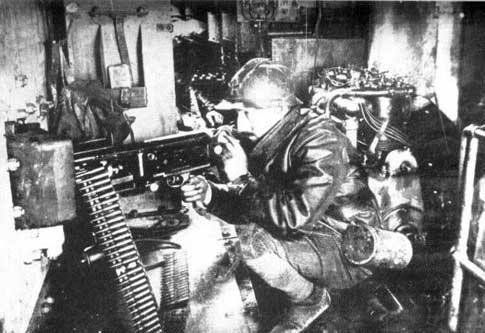
Gunner positions in the St-Chamond WWI tank. You can see just how poorly the side machine gun positions were thought out. The gunner has to crouch down in an awkward position. His shin is inches from a sharp corner of the arch over the tracks. The heat and noise from the engine, located a foot or two away, must have been unbearable.
Between those two compartments the gasoline engine and the electric generator were positioned in the open. Narrow passageways on both sides of the engine connected the front and rear compartments. The passageways also held Hotchkiss positions, one on each side in front of the engine. The Saint-Chamond had 4 Hotchkiss M1914 machine gun positions: one at the front, one at the back and one on each side of the tank. Despite weighing 23 tons, the tank could manage a top speed of 12 km/h. This speed was seldom achieved in the field as the long nose was prone to dig into the ground. The relatively high maximum speed on flat ground was made possible by the “Crochat Collardeau” transmission which coupled a Panhard-Levassor 4 cylinders 90HP sleeve-valve gasoline engine to an electric generator. The generator was connected to two separate electric motors, one for each track.
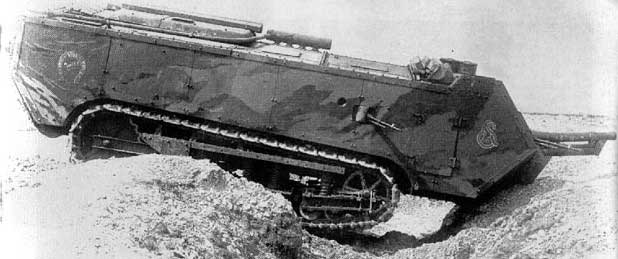
Due to its short tracks and over-extended body, the vehicle experienced major difficulties in crossing trenches and overcoming obstacles.
Due to its short tracks and over-extended body, the vehicle experienced major difficulties in crossing trenches and overcoming obstacles. This led to such a negative reaction by the crews in training that a special mention was passed on to General Headquarters: Nobody wanted to serve on the Saint-Chamond. Second Lieutenant de Gouyon, principal Saint-Chamond driving instructor at Marly, publicly declared that it had become virtually impossible for him to continue and, since he was a Member of Parliament, he requested that the whole matter be placed on the next parliamentary agenda.
The Improved Saint-Chamond tanks of 1918
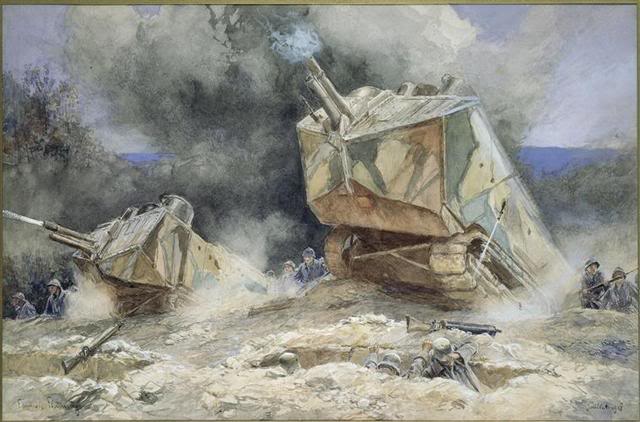
The Saint-Chamond was the second French heavy tank of the First World War. Born of the commercial rivalry with the makers of the Schneider CA1, the Saint-Chamond was an inadequate design. Four hundred Saint-Chamond tanks were manufactured but most of them were destroyed in action.
Originally the crew of nine men was protected by 11 mm of steel armour on the sloping front and 17mm on the sides. An extra layer of spaced 8.5 mm armour was added to the front to improve protection. Beginning with the 151st tank, the roof was also redesigned with a double slope so that satchel charges and grenades would slide off. At the same time, the original two observation turrets in front and on top were done away with and replaced by a single low profile square turret permitting front and side vision by the tank’s driver/commander. The tracks were also widened from 324 mm to 412 mm to lower their ground pressure. After Saint-Chamond tank No 210 the more effective Model 1897 field gun was installed instead of Rimailho’s (profitable) 75mm Saint-Chamond gun.
At about the same time barrel-like rollers were added underneath the front and rear of the tank to help crossing trenches. This improved version was later called, unofficially, the Modèle 18. Production slowed down in March 1918, after 377 had been assembled, and ceased completely in July 1918. Initially, forty eight Saint-Chamond tanks were modified as supply and recovery vehicles that could tow the lighter Schneider tanks. Their first action as a fighting vehicle took place at Laffaux Mill on May 5, 1917. During the summer of 1918, as combat moved from the trenches into the open, the Saint-Chamond’s were used to engage German field gun batteries (Nahkampfbatterien) at a distance with their 75mm cannon. The Saint-Chamond proved reasonably effective in this specialist assault gun role. The Saint-Chamond’s final engagement in battle took place in early October 1918, in support of the U.S. First Division near Montfaucon. However, by that time, the Renault FT tank had successfully taken over the major role in the French tank force and had also been purchased by the American Expeditionary Forces in France. After the war 54 were rebuilt as ammunition carriers. The remainder were scrapped.
The last Saint-Chamond tank remaining in existence ( an improved mid-1918 model ), alongside other French tanks of World War I (Schneider CA1 and Renault FT), is preserved at the Musée des Blindés at Saumur, France. It survived, together with a Schneider CA1 tank of the same vintage, at the Aberdeen Proving Grounds Ordnance Museum in Maryland, USA, and was later donated by the U.S. to the French government. Although very well preserved at the Musee des Blindes, this unique Saint-Chamond tank could not be fully restored due to the irreversibly degraded conditions of the two electric motors and of the electric generator.
Industrial Rivalry
Industrial rivalry had played a detrimental role in the design of French Tanks. The heavy Char St Chamond emerged from industrial lobbying of the government, rather than being ordered by the Army. Industrial initiative however also led to swift advances. Some in the French army had lobbied for the alternative mass production of super-heavy tanks, the resultant gigantic Char 2C, the most complex and technologically advanced tank of its day, was the outcome of this. Only ten were eventually produced, and these were far too late to participate in World War. The Char 2C would be the first tank with a three-man turret; the heaviest tank to enter service until late in WW2 and is still the largest ever operational tank.
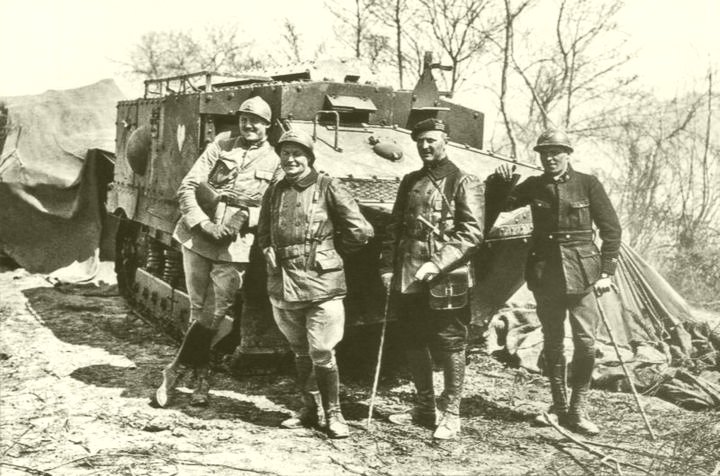
French tank from the Groupe D’Artillerie Spéciale at Berry-au-Bac, at the opening of the Nivelle Offensive in April 1917
French production initially lagged well behind the British. After August 1916 however, British tank manufacture was temporarily halted while better designs were completed, allowing the French to overtake their allies in numbers at least. During the Nivelle offensive of April 1917, the first use in battle of the French Tanks, the French Army had four times more tanks available that the British.
This numerical superiority was brief however as the French offensive was a major failure; the Schneiders were badly deployed and they suffered large losses from German artillery. The Saint-Chamond tanks, first deployed on 5 May 1917, proved to be so badly designed that they were unable to cross the first line of the German trenches. Not an auspicious start.
The Renault FT 17
We’ve already taken a look at the Renault FT-17 – this tank had a long life and saw use in WWII and even later in Indochina. It was utilised as far away as in China, during the Chinese Civil Wars, and versions of the tank were used both against and by the Japanese during the invasion of China. A large number found their way into both Republican and Nationalist hands during the Spanish Civil War. They were used in the Russian Revolution by both the Bolsheviks and the White Russians. France exported the FT 17 right up to World War II. The design was also developed by the Italians as the Fiat 3000 and the USSR as the T-18. The last known combat action by the Renault FT was in Afghanistan in the 1980’s when a handful of the tanks were used as static pill boxes or roadblocks.
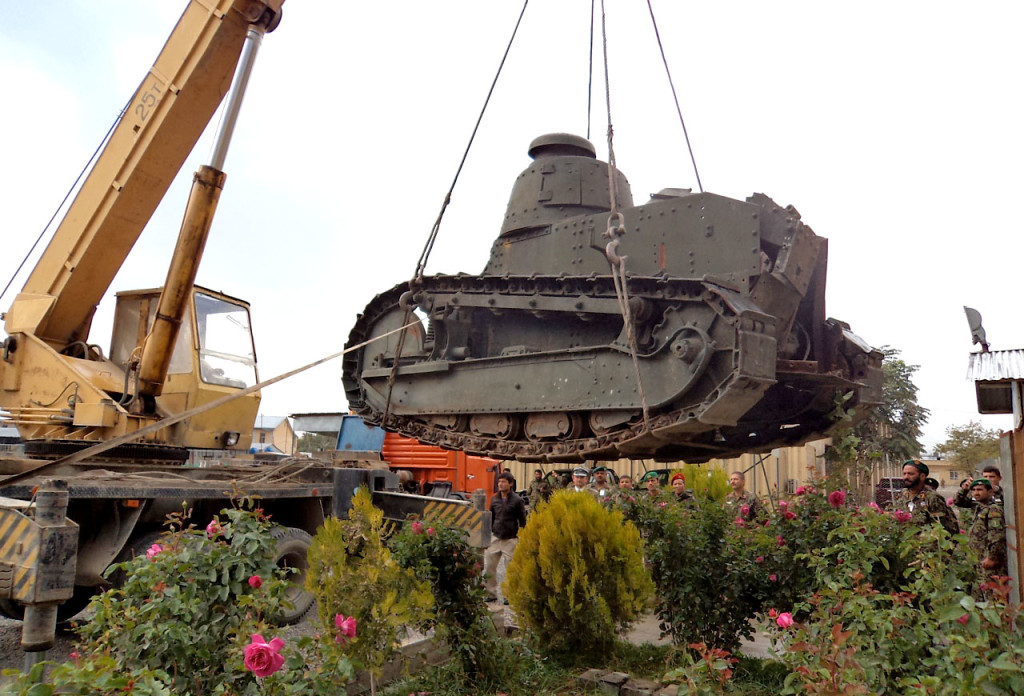
On 20 October, the Afghan Defence Ministry officially handed over the historic vehicle to Polish Ambassador in Kabul Piotr Łukasiewicz. The Russians probably seized the tank during the 1920 war, and presented it as a gift to the then Afghan emir in 1923.
Remnants of equipment from many other countries lie in ruins scattered across the Afghanistan landscape, faint traces of the military equipment of many countries whuh has made its way to this remote land. Many of the items are still being used, but much also litters the sides of the roads and decorates various junkyards. Amongst these remnants were Four old renault FT-17’s, two of which lay disassembled and rusting in a junkyard in Kabul whilst another sat on a plinth on display. These four Renault FT17’s given as a gift by the Soviet Union to Afghanistan in 1923. They had been captured in the Battle of Równe, on 5 July 1920…after being abandoned by the Polish forces. The two tanks in the junkyard have now been shipped to the US whilst the third (photo above) has been given to Poland as of 20 October 2012. The Polish Embassy in Kabul transported the tank to the Bagram base and handed it over to the Polish Military Contingent in Afghanistan frm where it was transferred to Poland by the Operational Command and the Armed Forces Support Inspectorate. The Renault FT-17 will be renovated by Stefan Czarniecki Land Forces Training Centre in Poznan. According to President Bronislaw Komorowski’s decision, the tank will be put on public display as a valuable reminder of the 1920 Polish-Soviet war.
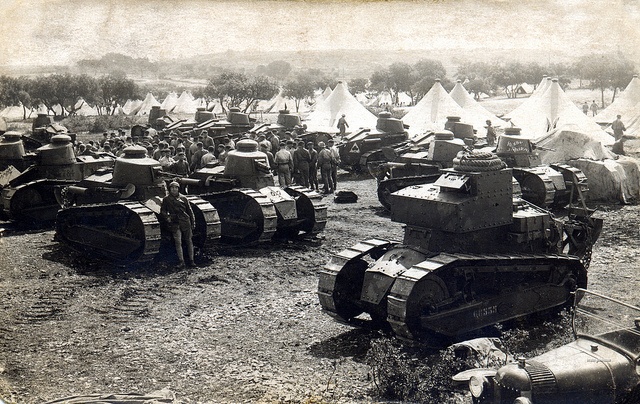
The FT-17 was one of the success stories of the First World War. The small tank was mechanically reliable after some initial teething problems. Owing to it’s size and narrow body, it was a relatively hard target for German artillerymen. But the standout feature of the FT-17 was the 360 degree rotating turret, which has been the mainstay of tank designs ever since. The version in the foreground is a wireless or command tank.
In battle in 1918, the Renault FT’s proved their worth immediately. They proved themselves technically also, continuing to perform in sustained operations with minimal technical support – miraculous by WW1 standards. The Soissons offensive of July 1918 saw the Renault’s in the vanguard of the attack and also showed the offensive power of tanks. The most significant tactical problem was the continued lack of sufficient tank-infantry training and as the atnks themselves were only good for a few dozen hours of operation before they required an overhaul, training was limited.
The major killers of the Renault’s in battle proved to be artillery, the anti-tank trench (and large shell craters) and mechanical problems. Mines were also a threat, although not many Renault’s were destroyed by these. Bridging tanks were, by the end of WW1, already being used as a solution to the anti-tank trenches. By late 1918, attacks were not necessarily being preceded by heavy artillery bombardments since the resulting craters were obstacles to the passage of the tanks. In the final offensives of September-October 1918, the Renaults enabled the French infantry to return to the fight, the poilus no longer faced the machine-guns alone. They were able to advance behind the tanks, watching as the machinegun nests were smashed and overrun by the tanks. There was no grand victory, but these battles heralded the end of trench warfare.
Although many were sold to other nations, over 2,800 Renault FT-17’s remained with the French Army. In contrast to the United Kingdom, which greatly reduced its armoured forces and scrapped redundant AFVs after the war, France continued to maintain a large number of active or reserve armoured units (with an organic tank strength of about 1,260 tanks) and all of the remaining Renault FTs were at least kept in working order.
The last of the French WW1 Tanks – the Char 2C
The Char 2C was the last of the French tanks developed during WW1 and was a “super-heavy” tank. In physical dimensions it was the largest operational tank ever built – the next operational tank to even approach its weight would be the German Tiger II tank of WW2. Ten were eventually built and entered service, remaining in use up until WW2, when they were activated during the French mobilization.
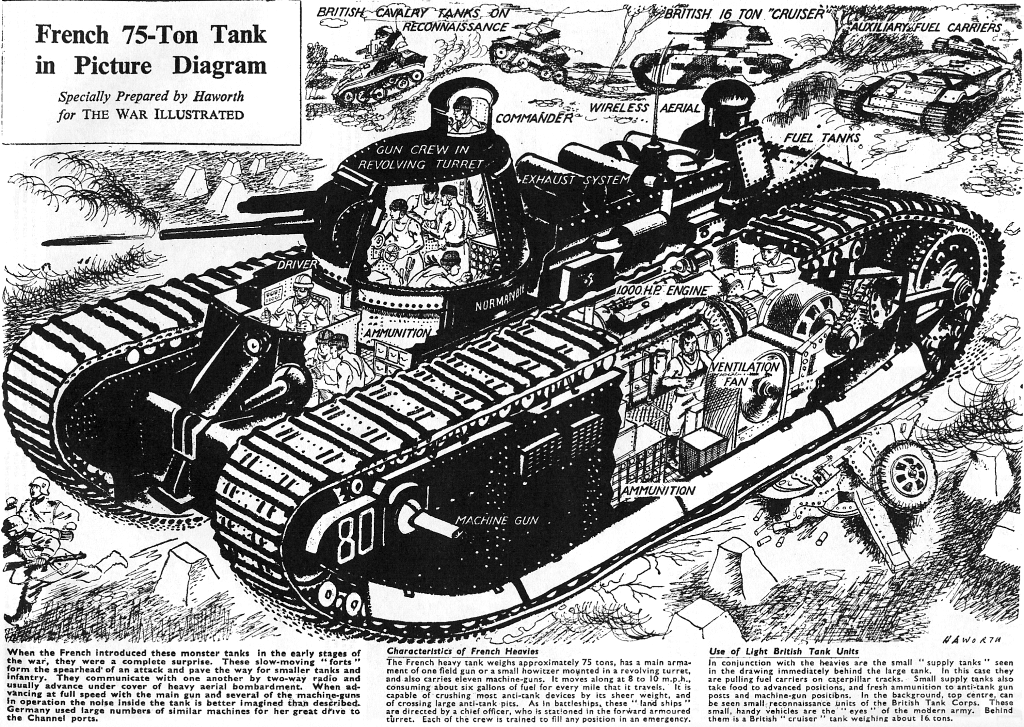
The Char 2C was intended as a breakthrough tank or “Fortress Tank” (Char de forteresse), intended to lead the great Allied offensives that were planned for the spring of 1919. France planned to produce 300, but only 10 were ever built. This monster had a crew of 12, weighed some 152,100 pounds, and was powered by two Maybach or Daimler Benz 250-hp gasoline engines. It had a speed of 7.5 mph. The Char 2C had maximum 45mm armor and was armed with a turreted 75mm gun (later a 155mm) and four machine guns.
The origins of the Char 2C have always been shrouded in mystery. In the summer of 1916, General Mourret, the Subsecretary of Artillery, verbally granted Forges et Chantiers de la Méditerranée (FCM), a shipyard in the south of France near Toulon, a contract for the development of a heavy tank, a char d’assaut de grand modèle. At the time, French industry was very active in lobbying for defence orders, using their connections with high-placed officials and officers to obtain commissions; development contracts could be very profitable even when not resulting in actual production, as they were fully paid for by the state. The French Army had no stated requirement for a heavy tank, and there was no official policy to procure one so the decision seems to have been taken solely on his personal authority, for reasons we can now only surmise.
The reason he later gave was that the British tanks then in development seemed to be better devised as regarded lay-out, ventilation and fire protection, so awarding a contract to a shipyard might improve on existing French designs. Exact specifications, if they ever existed, have been lost. FCM then largely neglected the project, apart from reaping the financial benefits. At that time all tank projects were highly secret, and therefore well shielded from public scrutiny. This was soon to change, however as, following the British deployment of tanks in battle for the first time, the French people and politicians now became curious as to the state of their own national tank projects. This sudden attention greatly alarmed Mourret, who promptly investigated the progress that had been made at FCM and was shocked to find there there had been none.
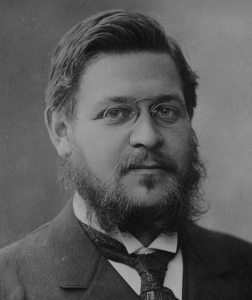
Albert Thomas (1878-1932) was a prominent French Socialist and the first Minister of Armament for the French Third Republic during World War I.
On 30 September 1916 he personally took control of the project and even without a design, ordered FCM to build one prototype. This development coincided with a political demand by the Minister of Armament Albert Thomas to produce a tank superior to the British types. Mourret asked Renault for help with the design and with assistance from the Renault team (who had fortuitously already prepared a feasibility study for a heavy tank), a full-size wooden mock-up was quickly constructed. In January 1917 the design was presented to the Consultative Committee of the Assault Artillery, who decided to have two prototypes built. By December 1917 the first prototype, the FCM 1A, was ready.
Mourret had by now been replaced as head of the commission by Estienne, whose good friend General Philippe Pétain, the new High Commander of the French Army, asked him to use his position to end the project. Estienne told Pétain that this was ill-advised while the public was questioning why these heavy tanks had not been produced. Besides, the allies (specifically the British and the US) would consent to give France 700 of the new Mark VIII Liberty design only if France had made at least a token effort to produce its own heavy tanks. Thus the French authorities had to delay the project while outwardly endorsing it. Estienne had already set this course by choosing the heaviest version, the “C”, for production, requiring a completely new prototype, causing a considerable delay. Pétain then demanded unreasonably high production numbers, asking for 300 heavy tanks to be ready for March 1919, thus delaying planning and initiating a political row, causing a quarrel to erupt between Clemenceau, who was both Prime-Minister and Minister of War, and Louis Loucheur, the Minister of Armament, who believed it impossible to provide the labour and steel required.
Meanwhile, Estienne and Pétain complicated the issue with further demands. Pétain asked for special pontoons while Estienne demanded battering rams and electronic mine detectors. When WW1 ended, not a single Char 2C had been built. The production order for the Char 2C was cancelled. However, despite the end of hostilities, strong political pressure to adopt new heavy tank projects remained as there was now a considerable surplus capacity in French industry. The Direction de l’Artillerie d’Assaut thus decided in April 1919 to procure ten Char 2Cs and to simultaneously use this order as an argument to reject any further projects. The Char 2C prototype was finished together with the other nine tanks being built; all ten were delivered in 1921 although modifications by the factory continued until 1923. They would be the last French tanks to be produced for the home market until the Char D1 pre-series of 1931.
The Char 2C had a loaded weight of 69 tonnes, partly because of its armour – 45 mm at the front, 22 mm at the sides, but much of it just because of its huge size. The armour was among the thickest of World War I-era tanks, though by modern standards this would be considered thin (The 40mm armor plating was substantial in 1918, but much less so by 1940 particularly when combined with the gigantic target the tank presented). With the tail fitted, the hull was over twelve metres long. Within its ample frame there was room for four compartments: a relatively short drivers compartment at the front, a fighting compartment with a 3-man turret (the first such in history) at its top mounting a long 75mm gun, a larger munitions room and finally a large engine compartment at the rear and a rear fighting compartment topped by a machine gun turret. Both turrets had stroboscopic cupolas. The three independent 8 mm machine gun positions at the front gave protection against infantry assault.
The fighting compartments were connected by the engine room. Each track was powered by its own 200 or 250 hp engine, via an electrical transmission. The original engines were German-made Mercedes diesels, later replaced by Maybach models, all of them part of the war reparations taken by France following the Great War. Mechanical reliability remained low: The German manufacturers were reluctant to provide spare parts, and may have given the French defective engines. Patriotic French mechanics disliked working on German-made equipment, with more than one man demanding a transfer. As a result, no more than six of the 10 tanks were ever fully operational at the same time, while the enormous fuel consumption made Army accountants reluctant to authorize their use for training.
The tank had been designed with a comparatively narrow width to make it transportable by rail, but loading the 2C aboard a specially-built flatcar was a difficult and time-consuming task. That cumbersome rail-transport process would eventually prove the undoing of the 2C. Top speed was 15 km/h. Seven fuel tanks, containing 1,260 litres, gave it a range of 150 kilometres. The suspension contained 39 interleaving road wheels on each side, making for a total of 90 wheels on the tank. To man the tank required a crew of twelve: driver, commander, gunner, loader, four machine gunners, mechanic, electrician, assistant-electrician / mechanic and a radio operator. Some sources report thirteen men, probably due to pictures of the crews that included the company commander.
Much attention had been given to ergonomics, Mourret’s stated motive in having the tank designed by a shipyard. The vehicle was less cramped than earlier designs, the crew being able to more or less walk around inside the hull. The mechanic could access the engine from either side. The commander could communicate with the driver, the front machine-gunner and the mechanic via speaking tubes. External communications were the responsibility of the mechanic who could lift a little hatche just behind the turret to signal by fanions, pyrotechnic devices or electrical lights. The tank could be entered through the cupola, but each crew member also had oval or round escape hatches above and below him.
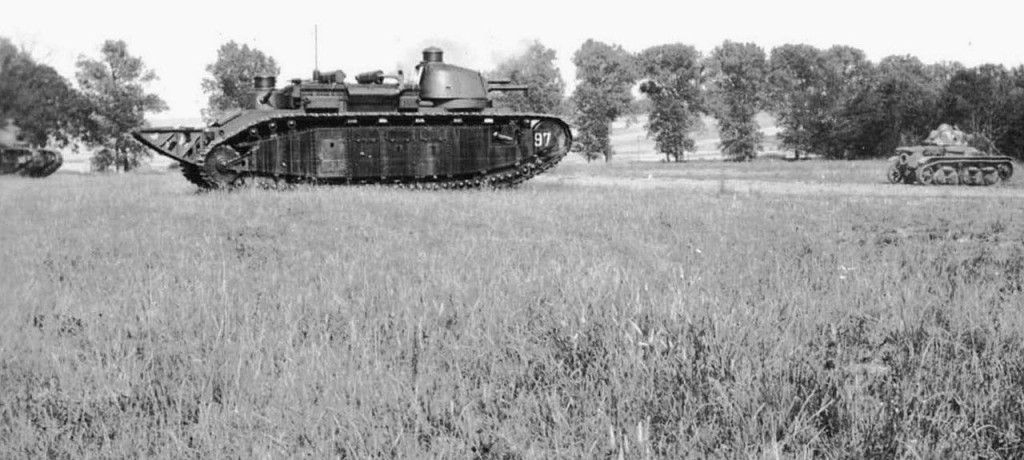
The Normandie #97 with skid tail in place, in maneuvers.
Note the difference in size with Renault R-35
Each track was powered by its own 200 or 250 hp engine, via an electrical transmission. Top speed was 15 km/h. Seven fuel tanks, containing 1,260 litres, gave it a range of 150 kilometres. The suspension contained 39 interleaving road wheels on each side, making for a total of 90 wheels on the tank. Later, new engines (two Sautter-Harlé engines 6-cyl 250hp/each) were fitted and the machine guns in the side positions were deleted. In this configuration the tank weighed perhaps 74 tons. Between 15 November and 15 December 1939 the Lorraine, as the company command tank, was experimentally up-armoured at the Société des Aciéries d’Homecourt to make it immune to standard German antitank guns. The front armour was enhanced to 90 mm, the side to 65 mm. In this configuration, weighing about 75 tons, the Lorraine had at that time the thickest armour of any operational tank, and is probably still the heaviest operational tank ever.
During the French mobilisation of 1939, all ten were activated and put into their own unit, the 51st Bataillon de Chars de Combat. For propaganda purposes, each tank had been named after one of the ancient regions of France, numbers 90-99 being named Poitou; Provence; Picardie; Alsace; Bretagne; Touraine; Anjou; Lorraine; Berry; Champagne respectively. In 1939, the Lorraine was renamed Normandie. As their main value was in propaganda, the giants were kept carefully out of harm’s way and did not participate in the September 1939 attack on the Siegfried Line. They were used instead for numerous morale-boosting movies, in which they were often shown climbing and crushing old French forts. Their public reputation was of invincible super tanks, the imagined dimensions of which far surpassed the actual particulars.
The French commanders knew perfectly well that this reputation was undeserved. When the German Army ripped apart the French lines after 10 June 1940, the decision was made to prevent the capture of the famous tanks. All were to be sent to the south by rail transport. On 15 June the railway on which they were being transported was blocked by a burning fuel train, so it became necessary to destroy the tanks by detonating charges. Later Goebbels and Göring claimed the tanks were hit by German dive bombers. This propaganda lie was to be repeated by many sources. One tank, the Champagne, was nevertheless captured more or less intact and brought to Berlin to be exhibited as a war trophy. In 1948 this tank disappeared, causing many to speculate it still survives at the Russian Tank museum in Kubinka.
Next, we’ll look at French Tanks of the 1930’s – some of which were considered by Finland as the Finnish Army built up armoured units through the decade of the 1930’s.
French Tanks through the 1930’s
France came out of the First World War with the laurels of a winner and the promise of interesting developments with the little Renault FT, the first mass-produced tank of the modern age. But the vagaries of the Fourth Republic and the choices facing an ageing staff would turn to the creation of a force largely marked by a strong defensive vision, relying mainly on the Maginot Line. French tanks were classified as infantry and cavalry models, with some “chars de rupture” (breakthrough tanks). Production and testing was ongoing in the late twenties and thirties, leading to a new generation of armored vehicles by 1935-36. These formed the bulk of the armored forces of France (then numerically the largest in the world) in September 1939.
As far as tank design was concerned, French engineers came up with various innovative designs of their own. The army – partly because of political issues and spending concentrated on the Maginot Line – was not given a sizable budget before 1932-34. This forced the continued use of the existing obsolescent types, the fleet of Renault FTs and the very few super-heavy FMC-2s. Renault attempted to modernize its best seller (very popular on the export market) while Panhard courted the cavalry with its armored cars. Both tried to implement the Kégresse track system, an innovative design which proved to be more useful on half-tracks. The mass-produced US M2/M3 models of WW2 used a similar system. The French adopted it for the AMC P13 and also for many off-road trucks and gun tractors delivered to the Army.
Casting was incorporated into French tank manufacturing early on, in 1934-35, first for turrets and then for hulls. The Hotchkiss H35, for example, was the first tank to be built entirely by cast sections (the hull needed three sections, the driver’s compartment, fighting compartment and engine bay), which helped standardization for mass-production. Cast parts when welded together allowed for a lighter weight, were less labor-intensive and prevented the risk of spalling. The SOMUA S35 also made use of an entirely cast hull and turret, also with many large prefabricated parts. The Souma S3 design was in fact influential on the US when they decided to build the Sherman M4A1.
Other innovative features were more specific, such as the Oleo-pneumatic steering system designed to steer the massive hull of the B1 heavy tank. In this case, the driver was also aiming the main 75 mm (2.95 in) gun. Many other tanks allowed some limited traverse for their hull-mounted gun, compensating for the lack of precision of the standard brake-steering system. French engineers, however, designed a system theoretically giving the greatest possible precision to the driver, allowing accurate traverse. However this system in operation proved too fragile and complex.
French tanks were generally better protected than their German opponents. The reason behind this was their doctrine of use. They were not seen as independent units but were to be spread amongst infantry units so as to offer close support on the battlefield. For this reason strong armor was of capital importance, the speed was “infantry pace” and the low-velocity guns were meant to deal with concrete fortifications and pillboxes rather than with opposing tanks. This doctrine went back to trench warfare and the experiences of WWI. All French tank models, until 1937 at least, were designed for the same kind of operations as practiced in 1918. They were spread out on the battle line, under the command of generals moving little flags on maps, inside a rigid, pyramidal chain of command.
Consequently French tanks were generally slow (with the exception of cavalry tanks like the SOMUA S35 and scout tankettes) and relatively underpowered – and this was not seen as an issue since infantry pace was required. Range was also limited by fuel consumption but the tactical needs were seen as limited in scope to the area of a typical WWI battlefield. A 50-100 km (30-60 mi) area of operations was foreseen. Radio communication between tanks was sorely lacking, with flags and couriers used instead. The common practice in 1935 was that only command tanks possessed a long-range radio.
Demography was also, surprisingly, a critical factor with French tank design. After the Great War, the demographic pyramid was inverted in France and Germany, resulting in a natality gap largely favorable to Germany, which was crucial twenty years later. After 1935 the French were vividly aware of this, a fact that was reflected in the army’s specifications. To cope with the normal provision of tanks per units, and faced with limited manpower, the most viable option seen was to limit tank crews to three men and design the tank around these men.
With more complex requirements, new tank models saw a multiplication of tasks which were not counter-balanced by an increase in crew numbers nor a new turret design. The commander remained isolated in his single-man turret, with the task of commanding, loading and manning the main gun and the coaxial machine-gun, plus sometimes the radio. The driver and a loader/co-gunner/mechanic completed this busy crew. As a result, French tank commanders were task-overloaded and simply couldn’t cope with both other tanks maneuvering around them and dealing with several threats at the same time. This helps explain why French tanks units were decimated despite having better armor. Another issue was the lack of penetrating power of the French guns, the most common being the short APX (Puteaux) 37 mm (1.46 in) designed for infantry support.
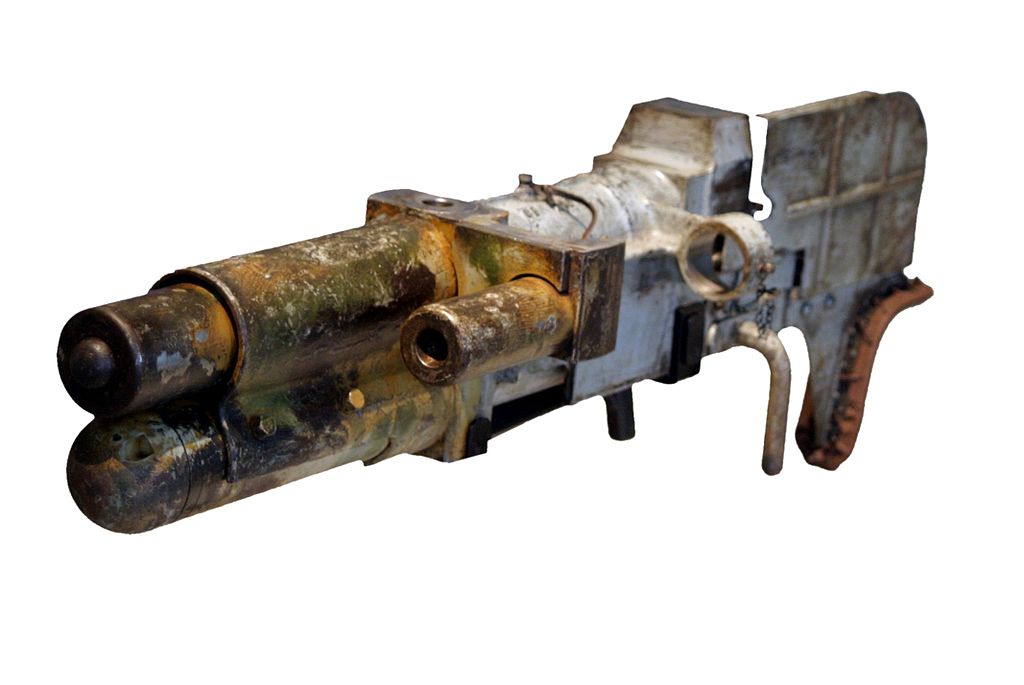
Puteaux M 1918 37mm semi-automatic short gun / Canon de 37mm court semi-automatique Puteaux modèle 1918
French logistics were also a weak point. France pioneered their first armoured division, with a combination of tanks, armoured cars, motorised infantry and artillery. It was called the Division Legere Mecanique (DLM – Light Mechanical Division). In the mid 1930s France created to entirely motorised armoured light divisions, that were equipped with the brand-new SOMAU S-35 tank. Although called ‘light’ divisions, they were well-equipped units that were the equivalent of a German Panzer division. They had 300 armoured vehicles, including 190 tanks, mostly medium tanks like the Hotchkiss H35 H39, Renault R35 and the Somau S-35. By the beginning of 1940, there were four of these divisions in the French army. In 1939 the French army formed a heavier armed unit called the Division Cuirassee (DCR). These contained Char B1 heavy tanks and some older Char D2 tanks as the main striking force.
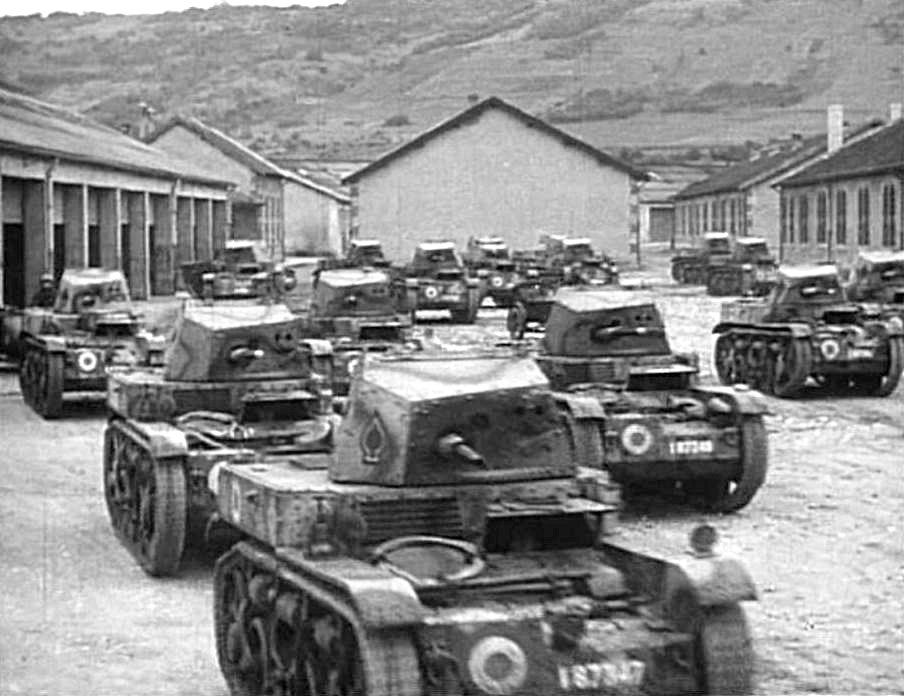
A group of 13.2 mm-armed AMR 35s, belonging to 4e RDP, 1re DLM; the vehicle in front, No. 87347, is the second produced and shows the large rosettes typical of this unit from 1938
While the French had some excellent medium and heavy tanks, the sheer variety of different types caused logistic problems. The French ordnance officers and quartermasters had to make sure that the correct spare parts and ammunition were sent to the right units when needed. This often did not happen. Once war broke out, some tanks were abandoned because of lack of ammunition and lack of the correct parts to mend a broken down tank. The only helpful factor was that the S-35 had the same turret and 47mm SA 35 gun as fitted to the char B1 and D2 tanks. Logistical problems were a major factor in the defeat of the French army. Lack of fuel was a big problem for the tank units when most tanks consumed gallons of fuel per mile. The French 3rd Light Mechanised Division for example was ordered to start a counter-attack on 20 May 1940 alongside British units. They were unable to get into position until the 22nd due to fuel shortages and crew exhaustion. The 3rd DLM could only muster around 60 Somua S35 tanks as they had already lost all their Hotchkiss H35 tanks.
We’ll now go on to look at the French tanks and armoured vehicles of the 1930’s. In doing so, we’ll concentrate on models which were produced in relatively large numbers and which were potentially available for export to Finland. Those vehicles produced in small numbers will by and large be ignored. As France was a supplier of tanks and other armoured vehicles to the Finnish Army in limited quantities both through the 1930’s and in the early part of the Winter War, I’ll also indicate whether a particular model was purchased or given to Finland and in what quantities. This will serve as a prelude to the study of the founding and expansion of the Finnish Armoured Divisions of the Winter War that will end this series of Posts.
Renault Char D-1 – requested 1928 (160 built between 1930-1934)
The French plan of 1926, calling for the creation of a Light Infantry Support Tank, led to the development of the existing Renault NC1 prototype into the Char D1. In 1923 Louis Renault had obtained an order to build two prototypes of a modification to the design of the Renault FT’s, with the factory designation of Renault NC. In 1928 Renault had his Renault NC accepted as a light infantry tank two prototypes ordered. The Army called this project the Char D and ordered a pre-series of ten vehicles in December 1929. The ten hulls were delivered between May and November 1931: an interval of ten years from the delivery of the last Char 2C in 1921. With this order, French tank production for the home market had finally resumed. In testing the prototypes, many shortcomings were identified and the type entered mass production, albeit with some further modifications.
The Char D1’s Renault FT ancestry can be seen in the sloping engine deck and the profile of the side armour plates. For its time the Char D1 was relatively well armoured; the hull weighing 11 metric tons. A 74 hp V-4 6.08 litre engine gave a top speed of 18.6 km/h with a range of 90 kms. The D1 had a crew of three: a driver who, as with the Renault FT, was seated below large double hatches that formed the nose plates, a radio operator who also assisted in the loading of the gun, and a third crew member, the commander, located in the turret. With the turret, the total weight was 14 metric tons with a total vehicle price of 475,000 FF. The Char D1 was thus neither particularly light nor cheap.
One hundred and sixty of these tanks were produced between 1931 and 1935. Until 1936 the vehicles were fitted with Renault FT turrets because the intended cast ST2 turrets were not yet ready. The ST2 turret was fitted with a short 47mm SA34 tank gun with a coaxial 7.5mm machine gun. The hull was equipped with a 7.5mm MG in the bow. In 1932 the Char D1 was the most — indeed the only — modern tank available to the French Army and served as France’s major battle tank of the early thirties rather than as an infantry support tank as originally intended.
For the regiments receiving the new tank, the D1 proved a grave disappointment. The main reason was its very poor mechanical reliability. In March 1934, when 110 vehicles had been delivered, seventeen were already worn out and had to be returned to the factory for a complete rebuild; of the remaining 93, 62 were non-operational because of major defects. Burn-through of brakes and transmissions was common; the armour plates bent out of shape because the chassis was not stiff enough, rivets regularly snapped. The fundamental cause was that the Renault design team had “solved” the problem of combining low weight with low cost by using weak components of inferior quality steel: other later Renault designs such as the AMR 33, AMC 35 and Char D2 would also suffer from similar problems.
In 1935 a large maintenance program was started to improve the Char D1’s mechanical reliability. However in March 1936 when tank units were rushed to the German border in reaction to the Rhineland Crisis, it became painfully obvious that their poor readiness state had not been rectified. The new ST2 turret only worsened the situation: the glass of the diascopes was shattered by mere driving; there were no AP-rounds available, the munition racks had not been changed to hold the new and larger 47mm rounds. The ST2 turret also proved too small to be adapted to the much more powerful 47 mm SA35 gun. Analysis led the Army to conclude that it should rid itself as soon as possible of the troublesome tank.
The Char D1s were thereafter shipped to the typical destination of French army ordnance that was obsolete but too valuable to be scrapped: the colonies. In 1937 the D1’s were transferred to colonial units in North Africa.
Renault Char D2 – requested 1930 with 100 built 1936 and 1940
While the Renault D1 was still in development, a heavier version was requested the Direction de l’Infanterie on 23 January 1930. This request called for a medium tank (the D1 was a light model) with 40 mm (1.57 in) of armor and a higher top speed (13.67 mph/22 km/h) than the D1, which in turn required a far more powerful engine. Negotiations ended in April-May, Renault also agreeing to build an adapted version for the colonies, the D3. It was also hoped that it could replace the heavy B1 bis if the later would have been banned by an armament reduction treaty in negotiation at that time. However, this never happened, and the D2 soon became a low-priority project and the army greatly reduced the initial order of 750. Two batches of 50 would be eventually delivered by the company, the first in 1936-37 (called model 1935) and the second, much improved, in 1940 (model 1938).
Three prototypes were built. The first was the Renault UZ, with a riveted hull and Renault FT turret (April 1932). It was tested at Rueil with the 503e RCC and accepted in service in December 1933. One year earlier, two welded hull prototypes had been ordered and build, to be delivered in November 1933. Nevertheless, the first batch was approved without testing the real production model. This was done in order to partially finance the cost of applying new welding techniques. This building technique proposed by Renault saved weight and time. This was a costly and complex process that Renault had a hard time mastering, and since the production was rushed, problems immediately appeared.
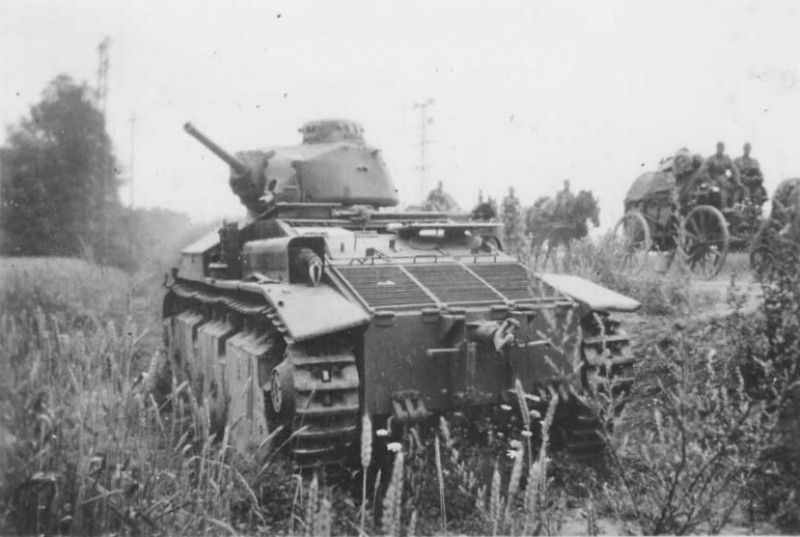
The first 50 D2 tanks manufactured were delivered to the 1st Battalion, 507th RCC (based in the neighborhood of Metz) to replace their D1’s, which were sent to Tunisia
In most respects, the D2 was a slightly enlarged D1, retaining many features of the previous vehicle, like the vertical coil suspension design. The D2 was still narrow, with the turret placed forward, immediately behind the driver’s compartment, and a long, sloped back engine hood. Massive side skirts with mud chutes, similar to the former vehicles, were also retained. Previous experience dictated the return rollers be placed higher to prevent track resonance. The tracks were 35 cm (13.78 in) wide. The suspensions counted three bogies, each with four road wheels, one coil spring and two shock absorbers, per side. The crew was three, the radio operator being seated next to the driver, operating the hull Reibel machine-gun (low, right side). The commander was seated in the turret. As usual in this configuration, he had to operate the gun (loading, aiming and firing), serve the coaxial machine-gun and command the tank at the same time. There was a four-speed gearbox, and four fuel tanks, giving a 100 km (62 mi) range. The D2 could cross a 2.1 m (6.89 ft) wide trench, climb a 80 cm (2.62 ft) obstacle, climb slopes of 45° and ford 120 cm (3.94 ft) deep rivers.
The first batch was approved on 29 December 1934, based on the tests performed with the three prototypes, fitted with gasoline and diesel engines. The gasoline engine was retained. The turret was bought separately from another manufacturer, the Puteaux factory near Paris, and the APX-1 was chosen, a modern, cast turret fitted with a SA-34 short barrel 47 mm gun (1.85 in) (from the same manufacturer) and a coaxial Reibeil 7.5 mm (0.29 in) machine-gun, and a hemispheric observation cupola. As usual, the commander could sit partly outside on a rear turret hatch. The turret cost was 200,000 frs, which when added to the cost of the hull (410,000 frs apiece) raised the unit cost to 610,000 frs. The first units from the batch were delivered in May 1935, the last in February 1937. The SA-34 had limited antitank capabilities. It was supplied with HE shells (obus D, muzzle velocity of 490 m/s / 1607 ft/s), and AP shells (model 1932, muzzle velocity of 480 m/s / 1574 ft/s, piercing only 25 mm/0.98 in at 100 m/328 ft). Two command vehicles were built (chassis 2016 – 2049), equipped with a second ER51 long range set.
The second batch was ordered in June 1938, (despite alarming tests reporting balance unreliability) following Renault’s assurance that they could produce two hundred units a year. However, this proved overoptimistic in the context of 1937-1938, with Renault plagued by general strikes and financial problems. Production was postponed, and there was uncertainty about possible exports to Poland or Belgium, exports which were eventually opposed by the Supreme Commander Maurice Gamelin for fear of technology transfers. The state of the first batch was so poor that their conversion into flame-thrower tanks was envisioned, while the unit tanks were to be replaced by newer tanks. When WW2 broke out, Edouard Daladier confirmed mass production of the type, however deliveries were kept low, three to five vehicles per month, so that the entire second batch was not completed until June. The last fifteen were probably not taken in action in time.
The second batch was basically identical, mostly differing by the use of a more modern APX-4 turret, bearing a 47 mm (1.85 in) SA-35 long barrel gun, quite effective against tanks. PPLR X 160 episcopes replaced the older Chrétien type, and there was a S 190 G attachment point on the roof for an extra 7.5 mm (0.29 in) AA machine gun. An improved greasing system, modified idler wheels and sprockets, ball bearings, shorter mudguards, a new Vertex distributor and Vlex starter completed this overhaul. At the same time, older vehicles from the first batch received upgraded APX 1A turrets, and were taken over at the Atelier de Rueil for rebuilding – namely to fix all the issues previously known. This process started in March 1940 and continued until May 1940. At the same time, the flame-thrower project was maintained but never carried out despite a prototype being built in 1939.
The D2 was plagued by mechanical unreliability and quickly worn-out, a problem further aggravated by the lack of spare parts. The D2 also proved ill-adapted to snow conditions.
Renault AMR 33 (123 built between 1933 and 1936)
In 1931 the French cavalry arm needed a fast vehicle for forward reconnaissance missions. Renault, eager to be ready for the upcoming specifications, quickly completed the design for a very small and light vehicle by November 1931. This first Tracteur léger de cavalerie type VM was equipped with Carden-Loyd suspension (copied without a licence), was lightly armored and equipped only with a single machine-gun. On January 16, 1932, the specification came in, calling for a three-ton light reconnaissance tracked vehicle armed with a machine gun and with a range of 200 km (124.27 mi), to be called “Automitrailleuse de Reconnaissance”, abbreviated as AMR, since the Cavalry was forbidden by law to have tanks. For the army this was a skirmishing, radio-less vehicle rather than a pure recon vehicle, like the AMDs (Automitrailleuse de Découverte).
Renault meanwhile had completed its prototype, based on the Renault UE and showing impressive performance. It had excellent off-road capabilities and could cruise at 50 km/h (31 mph) and could reach 35-40 km/h (21.74-24.85 mph) on bad terrain. This prototype was rejected as too cramped for operational use. Ten days later, officers from the Section Technique de la Cavalerie approached Renault to design a tankette based on the AMR concept. The General HQ commander, General Maxime Weygand, eventually agreed to the type. Renault then quickly returned to the drawing board and presented a larger wooden mock-up in March 1932. On April 20 1932 an order for 5 prototypes was signed, with a deadline of the Champagne maneuvers in September 1933. Each of the prototypes was delivered on schedule, testing different suspension configurations, all based on the Carden-Loyd type. These prototypes were equipped with one of Renault’s most powerful, already available, commercial engines, the 6-cylinder Reinastella, also used on the luxury sedan of the same name.
AMR 33 Design
By weight and dimensions the AMR 33 was first considered as a light tank, not a tankette, but that was before the appearance of the much heavier Hotchkiss 35, Renault 35 and FCM-36 tanks. By all other standards, the AMR 33’s were tankettes. First of all, they were small with a very low profile. Their suspension was largely “inspired” by (copied from) the Carden-Loyd design. The empty hull weighed just 4.5 tons, the armor was only 13 mm (0.51 in) thick and was made from riveted plates which supposedly protected the crew from heavy machine guns . The engine fitted was another commercial model, the eight-cylinder 84 hp 4241 cc Renault Nervasport. This powerful engine combined with the lightweight hull allowed for speeds in excess of 60 km/h (37 mph) on flat ground, and 47 km/h (28 mph) off-road. There was a Cleveland differential and a 4 forward, 1 reverse gearbox. The main fuel tank contained 128 liters (33.81 gal), giving a 225 km (139 mi) range. The tracks were narrow, as was customary for tankettes, at just 22 cm (8.66 in) width. The AMR 33 could ford 60 cm (1.96 ft) deep rivers, cross 1.4 m (4.59 ft) wide trenches, climb a 45 cm (1.47 ft) high obstacle or a 50° slope.
The armor was well sloped at the front glacis (9 mm/0.35 in), 13 mm (0.51 in) thick on the vertical plates, 6 mm (0.23) on the top and 5 mm (0.19 in) on the bottom. The driver sat on the left, next to the engine, seeing through a large opening protected by a lifting hatch pierced by a vision slit. The engine could be accessed through a hatch on the right, and crew entered the vehicle through the rear two-piece door. The turret was also on the left, with the commander inside, provided with a top observation hatch (and not a rear hatch as was customary in French tanks). The turret was of the Renault type. Initially a Schneider cast one was preferred, but found to be too expensive. The Renault type, made of sloped riveted plates was lighter and easier to build. This AVIS turret had been designed by the Atelier de Vincennes and was shifted slightly to the front to improve visibility. The compact Reibel 7.5 mm (0.29 in) machine-gun was a fortress model, comparable to the British-Czech Besa. There was however an optional pedestal mount, adjusted on top of the turret for an extra AA machine gun.
AMR 33 Trials and production
The Renault prototypes were tested in real and large scale exercises with the first operational French cavalry unit, the Détachement Mécanique de Sûreté. However the Commission de Vincennes charged to test them, although finding their speed sufficient enough, was not so positive about their weight and range. In April 1933, new tests were performed with two tankettes fitted with dead weight mimicking extra armor. One had a horizontal rubber spring suspension, the other a central vertical spring and casings of the horizontal springs oil-filled to act as dampers. Renault preferred the first, but the Army choose the second (with dire consequences), and approved this version for productionon the 6th of June 1933 as the Renault AMR modèle 1933.
The first order of 45 units was issued by the Cavalry Corps as early as March 1933. A second order of twenty was put through on June 22nd, with deliveries being scheduled for July. Finally a third order for fifty was placed in August. However production proved difficult at first and finally the deliveries began in June 1934 and ended in September. Two machines were completely rebuilt to produce a new improved model, the AMR-35. To compensate, three others were built in the spring of 1935. Indeed the flaws quickly detected on the model 33 put an end to further developments. The AMR-35 was much more successful. The first problem was excessive vibrations and noise caused by the engine. Compartmentalization was poor and there no intercom nor radio. But moreover, the suspensions, initially designed for far lighter models proved far too too weak for the task, broke down, broke off, or literally fell to pieces in prolonged off-road rides.
The AMR 33 in action
At the beginning their operational concept called for a mass of light tanks preceding the medium types, but since in the meantime mediums were produced in sufficient numbers and the AMR 33s saw themselves quickly replaced by the AMR-35, their role shifted towards infantry and dismounted cavalry support. By 1934, 115 vehicles has been delivered so far, and spread among five cavalry divisions, in GAM (Groupe d’Automitrailleuses) units comprising three platoons of four, two reserve/training, and one command model. However the 5th DC received only ten and the 4th DC forty. It was composed then of the 4th BPC (Bataillon de Dragons Portés) and 18e Dragons.
By 1935, the 4e DC was converted into a fully armored division, at first with six full squadrons of AMR 33s and later reinforced with medium tanks. At the end, the 1 DLM and 2 DLM (Division légères Mécaniques) formed the core of these new divisions in case of war. However by 1937, the mechanical unreliability of the AMR 33 was notorious and all had been replaced by the AMR-35. The AMR 33s were concentrated in remaining RAMs (Régiment d’Automitailleuses) forming light divisions of 46 vehicles.
However, these were reorganized once again between September 1939 and May 1940 into five newly-formed Divisions Légères de Cavalerie (“Light Cavalry Divisions”). However their organic strength was still poor, ranging from 26 to 22 per DLC, and this was proven during the battle of France. They had been posted in the Ardennes sector and found themselves badly prepared to stop the German advance, only participating in skirmishes, covering actions and support actions for the infantry, but proved easy prey for the Panzer II and many armored cars equipped with the same 20 mm (0.78 in) gun.
The losses were appalling. An AMR 33 of the 3rd DLC was the first French tank destroyed in battle, but most of the 75% losses occurred due to breakdowns issues rather than enemy fire. On June 7, 1940, the 7e DLM was created of surviving vehicles and some reserves, having 14 AMRs in total. Most were lost. After the armistice, the Germans captured a handful of these models, renamed Panzerspähwagen VM 701 (f). They never left French soil and were probably kept for patrolling and anti-partisan activity. A single AMR 33 has survived to this day. It is on static display at the Saumur tank museum in France.
Hotchkiss H35/39 – (1200 built from 1935 to 1940)
Renault and Schneider had been long time manufacturers of French tanks. Hotchkiss (Société Anonyme des Anciens Etablissements Hotchkiss et Cie), founded in 1875 near St Denis (Paris) by Benjamin B. Hotchkiss, an American engineer, was a newcomer in this field in the 1930’s, although already well known by the army for its world-famous machine-guns, cars and transmissions (the Hotchkiss drive). The Hotchkiss H35 Tank was a private design in response to a 1926 specification for a light, cheap infantry tank (or Char d’accompagnement). A proposal was made in June 1933 showing some innovations, including a steel hull cast in sections. It was also theoretically cheaper and lighter than the Renault D2 and was initially selected by the army’s Conseil Consultatif de l’Armement. The final specification (issued on the 2nd of August 1933) asked for a 6-ton tank, uniformly protected by 30 mm (1.18 in) of armor.
Hotchkiss was not the only bidder against this specification. Renault quickly entered the fray, being the first to deliver its prototype, which would be accepted as the Renault R35. However, the first prototype Hotchkiss demonstrated to Colonel Keller of the Commission of Vincennes, was a machine-gun armed tankette, tested in March 1935 and followed by another identical vehicle in May. Both were rejected because the initial specification had been changed in the meantime and was now asking for 40 mm (1.57 in) of armor. In August 1935, a third and last prototype was delivered, with a brand new cast steel hull and an APX-R (Puteaux) cast turret fitted with a 37 mm (1.46 in) short barrelled gun. The proposal was accepted in November 1935 as the Hotchkiss H35 and an order for 200 machines promptly.
Production started mid-1936 and by September 1936 the first series of H35’s were being delivered and heavily tested. However their cross-country capabilities had been overestimated. They were badly balanced and gave quite bumpy ride, which was potentially dangerous in formation, particularly when firing on the move. The power-to-weight ratio was also insufficient. Therefore, the Army turned them down. But as the initial order could not be cancelled for fear of a political upheaval, the Cavalry, already interested because of the slow deliveries of the costly Somua S35, decided to take the H35’s instead.
Production was interrupted in late 1937 after 400 had been built. Hotchkiss was requested to revise the design, which became the H39. The Hotchkiss H35 initially equipped several cavalry units but later on, with R35 deliveries proving insufficient, part of the H35 production run was diverted to meeting infantry tank requirements. All the H35 equipped units took part in the fighting of May-June 1940, but performed poorly as a result of of their limited speed, endurance and the low-velocity main gun. However, the German infantry, largely equipped with the PaK 36 37 mm (1.46 in) gun, was baffled to see how their anti-tank rounds simply bounced off the thick armor of these light tanks.
Design of the Hotchkiss H35
The initial H35 was a small and narrow machine, in order to fulfill the bid and keep the weight in check while having the thickest armor any light tank of 1935. The H35 was very similar to the Renault R35, its main competitor. They shared the same APX-R (Puteaux foundry) single-piece cast turret characterized by sloped sides, rounded bottom and a spherical vision cupola. The cupola comprised a PPL RX 180 P optical visor and targeting sight. Just abaft the mantlet there were three Chrétien binocular slide projectors (later horizontal PPL vision slits). The turret, which weighed 1350 kg with full equipment, housed a low-velocity SA 18 gun M37 (87 kg), with a coaxial 7.5 mm (0.295 in) Reibel machine-gun M31, protected by a small additional mantlet. The main gun received 102 rounds, and the machine-gun 2400 rounds. The SA 18 had a +20 -13° elevation. The hull was rather small, completely built of cast parts welded together, only 4.22 m (13.78 ft) long and narrow, at just 1.95 m (6.4). The total weight, in battle order, was a mere 9.6 tons. The tracks were small too – each link was only 27 cm (10.63 in) wide. The smaller links procured a smoother ride. The commander had a small seat and strap, but stood for observation and for operating his weapons.
The suspension was made of six pincer bogies, each holding two rubberized roadwheels, sprung by helicoidal horizontal springs. There was a front drive sprocket, a rear idler wheel and two return rollers on each side. The driver/mechanic sat on the right side, seeing through a periscope mounted on a hinged flap, supplemented by two oblique vision slits on the sides. A door section of the hood opened forward to allow the driver access. The commander/gunner accessed the turret through a rear door, and there was an extra emergency manhole at the hull bottom, just behind the driver. Equipment and tools were situated around the hull, comprising a camouflaged tarp fastened by straps to the back, a shovel, hatchet and cutter, on the left fender, a pickaxe bracket at the left of the hull, a mass, jack and crank on the right fender, a track cleaner on the rear cover, a 10-ton cable at the rear and two towing steel chains attached to the hull rear panel. The engine hood plunged forward, protecting a gasoline, air-cooled, Hotchkiss 3.4 liters, 6 cylinder, developing 75 hp@2400 rpm, for a 8.8 hp/ton ratio. The gearbox was a synchromesh with 5 speeds forward and one reverse. Normal consumption was 130 liters/100 km. The normal speed on road and over flat terrain was 28 km/h, ground pressure was 0.9 kg/cm2. The H35 was capable of climbing a 35° slope, a 70 cm high obstacle and of fording a 0.85 m deep river. However, trench crossing was limited to 1.80 m.
The later-model Hotchkiss H39
The H39 was an overhaul and upgrade of the H35, with a new Hotchkiss 6-cyl. 5.97 litre engine giving 120 hp at 2800 rpm. With a power-to-weight ratio of 10 hp/ton (the weight had increased to 12.1 tons), top speed was now 36.5 km/h (22.6 mph) on the road and range was increased to 150 km (93 km) thanks to a new 207 litre gasoline tank. The new engine required a redesigned hood, the rear being raised and now being nearly horizontal. Apart from these details, the H39 was very similar to the previous AFV, with the same SA 18 short barrel gun. But it was also subjected to some criticism and, at the end of 1938 a proposal was made to adopt the new SA 38, a long barreled 37 mm (1.46 in) gun, which had far superior penetration power and muzzle velocity. The turret was now equipped only with the new PPL horizontal vision slits.
The SA 38 was supplied with longer rounds, and thus only 90 could be carried (instead of 100 rounds with the SA 18). The gun was in relatively short supply, and despite the priority given to production of this new weapon, many H39s were put in service with the older gun model. 700 H39’s were built in total, starting in October 1938, the last being delivered in feverish conditions, thrown into combat right from the factory door in May 1940 without exhausts or mudguards. In early 1939, the Hotchkiss delivery rate was around 60 units each month. Final records are confusing, and based on the chassis numbers and factory monthly deliveries by 1940, the usual figure is 1200 machines in total, for both subtypes.
The Hotchkiss H35/39 in action
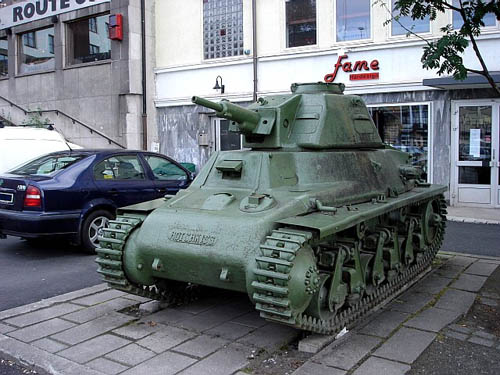
This French light tank stands in the centre of Narvik today. It was captured by the German army in 1940 and further modified.
The Hotchkiss H39 was also allocated to cavalry units and Army units. Some 15 H39’s were shipped to Narvik on the 7th of May 1940. Only 12 were withdrawn in June and these finally disembarked in Great Britain where they formed an embryo of the armored forces of the FFL (Forces Françaises Libres), the Free French led by De Gaulle, as the 1e Compagnie de Chars de Combat de la France Libre. Operational formations were unfortunately mismatched. The slow H35s operated with the faster Somua S35, and the H39 with the B1 bis.
During the May-June 1940 campaign in France, the H35 and H39 found themselves committed in spread out formations and rarely had a clear superiority over the enemy. Their 37 mm (1.46 in) “long” model 38 gun was, added to their thick armor, a clear advantage in tank-to-tank engagements against German light tanks. They were matched only by the Czech-built PzKpfw 38(t). However, tactically, the lack of radio and communication with HQ, as well as the overburdened tank commander led to disastrous results. Many were abandoned due to the lack of gasoline, entire units being captured later in this way. Some participated in a few improvised counter-offensives directed against the Germans without air support, which had dire consequences.
Export of the Hotchkiss H35 to Finland
In 1936, Finland purchased 60 H35’s, sufficient to equip one Panssaripataljoona (Panzer Battalion). These were delivered without guns – the standard Tampella-manufactured Bofors 37mm was fitted after delivery in Finland, together with the first tank version of the Suomi submachinegun. The H35-equipped Pataljoona would be one of the three Erillinen Pansaaripataljoona (Separate Panzer Battalions) tasked with fighting the initial delaying action on the Karelian Isthmus when the Soviet Union first attacked at the start of the Winter War. In the defensive battles on the Isthmus, operating in close cooperation with infantry, anti-tank guns and artillery and almost always from pre-prepared hull-down positions, the H35’s fought to their strengths. Their Bofors 37 mm gun, added to their thick armor, gave then an advantage in front-on tank-to-tank engagements against the Red Army’s light tanks.
In such conditions, well-protected, with clear lines of fire, pre-planned lines of retreat and good inter-arms cooperation with accompanying infantry, anti-tank guns and artillery, the H35’s inflicted heavy losses on the Red Army’s armour while taking very few of their own. By the end of the Winter War, the H35-equipped Erillinen Pansaaripataljoona remained in existence and by this time formed part of the 23rd Panssaridivisoona. The H35’s would be phased out of armoured combat units over 1941 and 1942, replaced with Finnish Patria-built tanks.
Other H35/39s also saw action under foreign colors.
Three H35’s were (as well as three R35) to the Polish Bureau of Technical Studies of Armored Weapons for trials sent in July 1939. In September 1939 these were integrated into an ad hoc unit commanded by Lieutenant J. Jakubowicz where they fought as part of the Dubrno task force. Two were sold to Turkey in February 1940.
Renault AMR 35 (187 built 1936-1939)
The AMR (Auto Mitrailleuse de Reconnaissance) 35 was not ordered by the army. When the AMR 33 hadn’t even reached production stage, Louis Renault took two prototypes and completely overhauled them, starting in February 1934. Trials indeed showed the weight distribution – due to a forward-mounted engine – was a serious issue, and he addressed it first by placing a new, more powerful Nerva Stella 28 CV, Renault sport coupé regular engine. Changes were made accordingly to the transmission, because the drive sprockets were maintained at the front. This also considerably lowered the noise inside the fighting compartment. The ventilator and exhaust pipe were also shifted to the rear. The weak suspension of the AMR 33 was also completely changed and tested on a third prototype made of bolted boiler plates in September 1934.
During the first trials at Vincennes, speeds attained were up to 72 km/h (44 mph), an impressive feat for any tank of that time with such a small engine. Louis Renault did not intend to support the cost of upgrading the production line, however the army was impressed, and General Flavigny insisted these changes be made. Cavalry officers noted that the engine was perhaps too delicate for military service and later asked for a sturdier one. Therefore, the second prototype was fitted with a 432 22 CV four-cylinder bus engine. Top speed was still 63 km/h (39 mph), with a weight of 5.03 tons. It was subsequently accepted into service as the AMR 35 and followed the AMR 33 on the factory line, sanctioned by an official order on July, 3, 1934.
Design of the AMR 35
The initial plans introduced a specific command vehicle fitted with a AVIS-1 turret (“Atelier de Vincennes”) armed with a 7.5 mm (0.295 in) machine-gun and equipped with a top observation hatch. The regular vehicles would be fitted with an AVIS-2 turret and a 13.2 mm (0.52 in) machine-gun. But these plans were dropped although the turret models were accepted. 100 were ordered including 8 command vehicles, factory designated ZT (this was purely chronological, without meaning). Changes compared to the AMR 33 were considerable. Despite relatively similar internal accommodations and equipment, the similarities ended here, as the engine and transmission were relocated and the suspension was brand new. The AMR 35 was larger and almost 1.5 tons heavier (6.5 vs 5 metric tons). It was assembled with armor plates riveted on a frame, ranging from 13 mm (0.51 in) for all vertical plates, 9 mm (0.35 in) for the glacis and sloped plates, and 5 mm (0.2 in) for the top and bottom. This meant it was better protected than its predecessor.
The driver sat to the left and at his right was placed a large ventilation grill. The commander turret was placed offset to the left. Eventually two turret types were used on the ZT-1, recognizable by their shape and armament. The 7.5 mm (0.295 in) armed AVIS-1 (Atelier de Vincennes turret) was octagonal and could receive an extra machine gun on a small AA mount on top of the turret. Normal provision was 2250 rounds. The AVIS-2 was fitted with a Hotchkiss 13.2 mm (0.52 in) heavy machine-gun. In battle the 13.2 mm gun, despite its ability to penetrate 20mm steel at 500m, proved to be incapable of defeating even the German armored cars, its bullets being deflected by their sloped armour.
Radio command versions received a ER 29 model, operated by the commander. The suspension was of the new type also used for the light tank R35, and was quite heavier and much sturdier than the previous design. It could, in theory, take twice the load it was intended to. It comprised a sprocket and idler of similar types, retained from the AMR 33 but with the spoke intervals filled for better strength, the sprocket just receiving dents. There were also four paired all-metal roadwheels resting on independent bogies front and rear, and a central twin bogie. All three were horizontally sprung with large rubber cylinder blocks. The central ones counted five smaller rubber cylinders separated by steel discs, acting as shock dampers. The track was 22 cm (8.66 in) wide and was supported by three return rollers. As shown at Vincennes, the AMR 35 could ford 60 cm (2 ft) deep rivers, cross 1.7 m (5.6 ft) wide trenches and climb a 50 cm (1.6 ft) obstacle or 50% slope.
The Renault 447 22 CV four-cylinder 5881 cc petrol engine was capable of giving the 6.5 ton tank a top speed of 55 km/h (34 mph) and average top speed of 40 km/h (25 mph), making it the fastest French tank of the day. The engine had a max output of 85 hp at 2200 rpm. Fuel capacity was 130 liters. Transmission used a Cleveland differential, with single dry plate type brake with four gears forward and one reverse. The Zénith carburetor and Scintilla Vertex magneto allowed it to start at temperatures well below zero.
AMR 35 Production
The first order asked for the delivery of ten pre-series vehicles in March 1935, but it was postponed in August. Due to a bad financial situation and strikes Renault eventually refused the second order for fifty tankettes, but accepted an order in April 1936 for only thirty others. There were coordination issues with the subcontractors as well, Schneider for the armor plates and empty hulls and Batignolles-Châtillon for the AVIS-2 turrets. By August 1935 trials at Satory had already led the army to ask for a change to the gear ratio and even refused the twelve vehicles delivered in September. These were returned for modifications and were accepted in October 1935. The first entered service on the 22nd of April, 1936.
By June 1936 seventy-six AMR 35s had been produced. However exercises showed serious reliability issues due to weak mechanical parts, including the Cleveland differentials not being suited for such speeds. In 1937, production almost stopped to allow the refitting of 92 vehicles, but the problems with the differential persisted, some being replaced up to five times in a short period. By August 1937 a second and third series were started, and seventy-five were delivered by the end of 1938. Most were now equipped with a synchromesh gear box and reinforced chassis girders, but reliability issues persisted until May 1940 and availability was poor. In January 1939 only 123 were reported serviceable, while the others were in repairs. In 1936 it had been envisioned to replace obsolete Renault FTs in service throughout the colonies with Renault AMR 35 ZT-4s, equipped with FT turrets. But this was given low-priority and of a total order of 56 vehicles only 40 had been completed when France surrendered. Another variant was the AMR 35 ADF (Renault YS), used for artillery observation, and equipped with advanced telemetric systems.
The AMR 35 in action
In May 1940 178 AMR 35s equipped the French Army. Tactically they operated in three squadrons for each DLM (“Division Legere Mecanisee”), and two squadrons for each DLC (light cavalry divisions). Tactically, and contrary to their acronym, they were used as fighting vanguard units, covering the infantry rather than for reconnaissance, a role already taken by the Panhard 178 and Somua-Gendron armored cars. In the Battle of France the AMR fared very badly being both poorly armed and armoured. The one main advantage of the AMR was its speed; it was the fastest French tank of its day and faster than all the German light tanks. However travelling at high speed cross-country played havoc with the poorly designed suspension which quickly wore out. During the campaign, more AMR’s were lost to mechanical trouble than to enemy action. Their actions are not known with precision, but their fate is shared between vehicles destroyed in action (due to poor armor and armament), abandoned due to the lack of gasoline or because of mechanical failure, mostly coming from the differential, transmission or more commonly because of suspension failure.
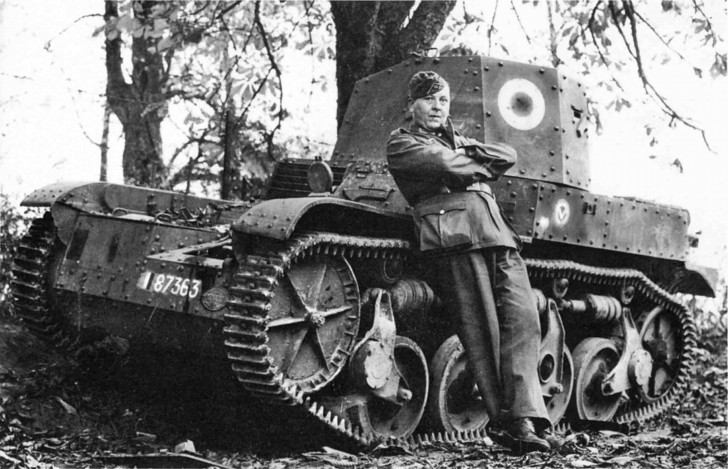
German soldier posing in front of an abandoned French light tank AMR 35 (№ 87363) of 5 RDP (Régiment de Dragons Portés) – the fate of much of the French Armoured Force of 1939/1940
Renault R35 & R40 (1,690 built between 1936-1940)
Until 1935 the little vintage Renault FT had been the staple of the French tank force. It was clear by 1932 that the new Renault tanks developed from the NC27 were not sufficient for the task demanded from them. They were too heavy, complex, costly and not suited for mass-production. The original requirements dated back to 1926 and asked for a “char d’accompagnement” (support tank) that could replace the FT and still operate in the same manner. However, with increase in AT gun caliber and velocity, the emphasis was put on protection. In early 1933 Hotchkiss proposed a solution, with an affordable small tank which turned the tables. But instead of purchasing these, for political reasons and due to the contract size, other contractors were in August 1933 asked to present their own model. Fourteen responded, ranging from automotive companies to small armories.
Renault, badly wanting the contract, rushed out a prototype which was ready when a further new specification was issued on June, 21, 1934. The new specification asked for an increase of armor from 30 to 40 mm (1.18-1.57 in). Renault could not revise the design on time and nevertheless presented its ZM prototype to the Commission de Vincennes on 20 December 1934. The model performed well, but was sent back to the factory for add-on armor and mounting the new APX (Atelier de Rueil) cast turret in April 1935. Tests were then resumed when, due to growing tension caused by the swift and massive German rearmament, the commission awarded a contract for 300 of the new “R35” tanks on 29 April 1935. This was even before the model could be perfected by Renault for pre-production. By 4 June 1936, the first deliveries were being tested and modifications performed during production. The hollow hull price was 190,000 FF, but with engine, mechanical parts, the turret and modifications, rose to 1,400,000 FF (the equivalent of 32.000$ at the time). Contrary to the Hotchkiss H35, the R35 was also produced for export.
The cast APX hexagonal turret had a 30 mm thick domed rotatable cupola with vertical vision slits (the highest point of 2.13 m) and had to be either hand cranked or moved about by the weight of the commander, the only other crew member. There was sometimes unofficially a seat installed for him but he most often stood. The rear of the turret had a hatch that hinged down that could be used as a seat to improve observation. The earliest vehicles were fitted with the APX-R turret (with the L713 sight) mounting the short Puteaux 37 mm L/21 SA18 gun (the first batches were removed from FT 17 guntanks which were then rebuilt as utility vehicles) and the 7.5 mm Châtellerault fortress machine gun. The cannon had a very poor armour penetration: only 12 mm at 500 metres. Afterwards the APX turret with the same cannon but the improved L739 sight and the standard Châtellerault 7.5 mm MAC31 Reibel machine gun was used because of delivery delays of the original weapon. There were also so many delays in the production of the turrets that after the first 380 hulls had been produced in 1936 and only 37 could be fitted with a turret, production was slowed down to 200 annually. The 7.5 mm machine gun’s spent cartridges (from a total of 2,400) went down a chute through a hole in the floor. The tank carried 42 armour piercing and 58 high explosive rounds.
Due to the deterioriating international situation, the total number of units ordered rose to 2,300 by 1939. As a result of the frequent delays experienced by APX in manufacturing the turrets, by 1936 Renault had succeeded in delivering only 380 hulls, while only 37 turrets were available – the annual delivery rate fell to just 200. By 1 September 1939, only 975 R35’s had been delivered to the army out of the 1070 produced. They only just replaced most of the units that had been equipped with the Renault FT’s, but crews still needed a few weeks to retrain. In consequence, by May 1940 there were still eight battalions of FT’s operational due to the lack of trained men. By June 1940, 1,601 R35’s had been produced for the Army. Out of this number, 245 had been exported: Poland (50), Turkey (100), Romania (41) and Yugoslavia (54). Production ceased after the capitulation of France.
The Renault R-40
Due to insufficient tests before production, it was quickly apparent to the receiving units that the R35 suspension was unreliable and experienced many failures. Work started in 1939 at AMX (the new name for the Renault tank department since 2 December 1936) to devise a better system, which could be fitted into the existing production run. This new system mounted twelve wheels in six pairs suspended by large vertical coil springs. These were protected by armored side skirts. The engine was upgraded to a more powerful model, while the hull was lengthened at the rear. The turret was the new APX-R1 cast model with a L767 sight, mounting a long barrel 37 mm (1.46 in) L/35 SA38. Last but not least, a radio was fitted. The new gun was capable of defeating 40 mm (1.57 in) of armor at 500 m (1640 ft).
The R40’s began to replace the R35’s after the 1540th unit. Only a few were delivered in time. The reconstituted Polish 10th Armored Cavalry Brigade in France was the first unit to be equipped with the new tank. At the same time, from 1939, some R35s were re-equipped with the new APX-R turret and the long-barrel 37mm. These were known as the R35 modifié 39, but only a few were converted and allocated to to unit commanders. AMX also produced quantities of steering tails prior to the war to improve their trench crossing capabilities. These were not always fitted.
The R35 bears a strong resemblance to its rival, the Hotchkiss H35. They shared the same APX turret, the three-module hull construction and placement for the driver and engine. However their dimensions differed, as well as the placement of the hull casemate, placed further to the rear for the Renault and, most obviously, the drivetrain. The hull, as stated, was made of three main prefabricated cast sections bolted together, while on the H35 these were welded. This helped improve Renault production times. Everything else was welded-on. Maximum thickness on the glacis was 43 mm (1.69 in), and 40 to 30 (1.57-1.18 in) on the hull lower sides, rear and engine deck. The turret itself was made of hard cast iron, 30 mm (1.18 in) thick.
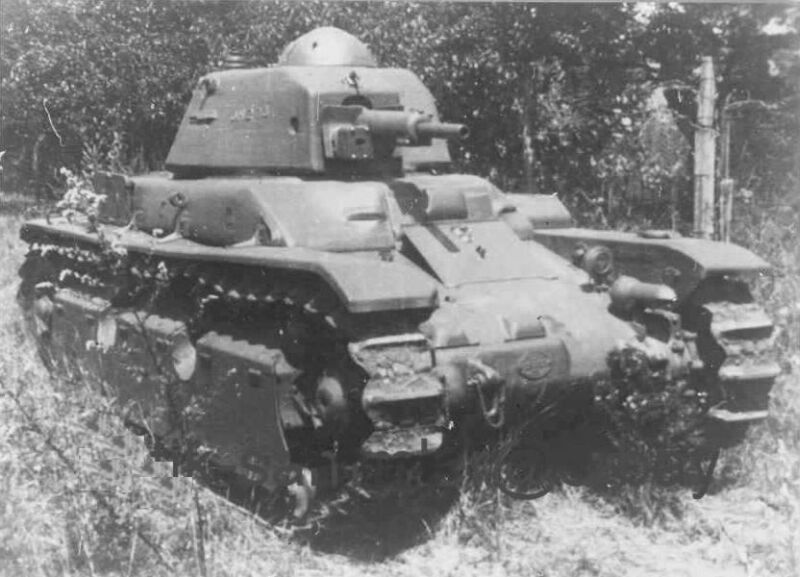
The Renault R40 was the final variation of the R35. It was developed by the Atelier de Construction d’Issy-les-Moulineaux (AMX) which introduced a brand new and better suspension that consisted of 12 pairs of small road-wheels on each side mounted in pairs, vertical coil springs, and protective skirting plates. This vehicle mounted the long barreled 37mm SA38 L/33 gun in the APX-R1 turret and had an AMX crossing tail.
The running gear was based on the one used for the light cavalry AMR 35 tank, with five double roadwheels encased in two sets of bogies and another single one at the front. All three were suspended by massive horizontal coil springs, with characteristic rubber ringlets. The drive sprocket was at the front and idler at the rear. The tracks reposed on three rubberized return rollers.
The tank used a crew of two. The driver’s position was offset to the left and the commander/gunner was in the turret behind. The final drive and differentials were in the nose. The driver had a Cletrac differential with five gears and steering brakes at his disposal. He had two hatches and one periscope for vision. The Renault V-4 85 hp engine was at the right rear, with a self-sealing 166 liter gasoline tank on its left. On final production tests, practical top speed was measured as 20 km/h (12.4 mph), which could fall to 14 km/h (8.7 mph) on soft or bumpy terrain. Fuel consumption was 212 liters/100 km off-road, but that was not believed to be a problem since it was believed 50 km (31 mi) was more than sufficient for a real breakthrough on a static front.
The turret received a dome-like rotatable cupola with vertical vision slits. It was free running on a ball track ring, either traversed by the weight of the commander or cranked more precisely for aiming. The commander normally stood on the tank floor. As was customary in French practice, the turret had a rear hatch that could be hinged down, allowing the commander to sit on it, legs inside, for external observation. The early turret model was the APX-R, equipped with a L713 sight, mounting the short barrel 37 mm (1.46 in) Puteaux L/21 SA-18 and a coaxial 7.5 mm (0.29 in) Châtellerault fortress machine-gun. This main gun was effective only against concrete fortifications at relatively short range, as muzzle velocity was only 300 m/s (984 ft/s). At best only 12 mm (0.47 in) of armor could be defeated at less than 500 m (1640 ft). Once again, it was a tactical limitation. The R35 was never intended to deal with other tanks. Normal provision of ammuniion was 72 AP and 58 HE rounds plus 2400 machinegun cartridges.
At the time of the German attack on France, the French Army had 900 R35’s in service, then the most numerous model available. According to French military doctrine it was to be used only for direct support of infantry. However, its gun proved able to defeat Panzer I and IIs, while the frontal armor could withstand a direct hit from the standard 37 mm (1.46 in) gun. These were strictly to tank units without other organic components, and only committed to infantry support in close coordination with infantry units. However, in May, when it was clear that doctrine was failing the test of battle, 135 R35’s were allocated to a newly formed 4th DCR (Division Cuirassée de Réserve) while others reinforced the 2nd DCR. Later, 300 tanks from the materiel reserve were also allocated to these new units.
The majority (843) of R35s fell into German hands; 131 were used as such as Panzerkampfwagen 35R 731 (f), issued to panzer units and mainly used for security duties or driver training, or used on armoured trains; most were later rebuilt as artillery tractors and ammunition carriers after removing the turret. Others were converted for use as tank destroyers. Some of the tanks that Germany captured were given or sold to Germany’s allies (124 to Italy for example).
R35 Exports – Poland
In 1938, the Polish Army bought two R35’s for tests by the Office of Armored Forces Technical Research. The tank did not meet Polish requirements, neither did the Hotchkiss H35. The Polish Army wanted to buy the SOMUA S35, but the French government did not give its consent. In April 1939, due to the impending conflict with Germany and the lack of opportunities to increase production of the 7TP, 100 R-35’s were ordered. The first batch of 50 (including three H35’s) wer delivered in July 1939, and were given to the 12th Armored Battalion in Lutsk. In September, this unit formed part of the 21st Light Tank Battalion, entrusted with the defense of the border with Romania. Others were incorporated into the composition of Group “Dubno” which took part in the battles against the Germans at Strumiłową and the Soviets at Krasne. 34 tanks of the 21st Light Tank Battalion crossed the border into Romania on 18th September and were interned.
R35 Exports – Finland
After the Polish capitulation, a Polish cavalry unit was raised in France (the 10th Armoured Cavalry Brigade / 10 Brygada Kawalerii Pancernej / 10e Brigade de cavalerie blindée polonaise). When the Soviet Union attacked Finland, the 10th Armoured Cavalry Brigade under the command of General Stanisław Maczek was brought up to strength in both men and equipment, being made up of two tank battalions, two strong motorized cavalry squadrons, one motorized infantry battalion one anti-tank battery, one anti-aircraft battery with engineering, signals, transport and support units. The two tank battalions were equipped with a total of 120 Renault R35’s. The Brigade was dispatched to Finland in February 1940 but with much new equipment that many Polish soldiers had no idea how to use.
Some 115 more Renault R35’s were taken from the Material Reserve and shipped as Aid to Finland together with the Brigade (these tanks were used to hastily equip two further Finnish Panssaripataljoona). Training was carried out after arrival in Finland, with the Brigade forming a part of the rather ad-hoc 23rd Panssaridivisioona (“Marskin Vasara – The Marshal’s Hammer”). The 10th Brigade fought well on the Karelian Isthmus and would end the Winter War on the outskirts of Leningrad.After the Winter War ended, General Maczek and his men eventually returned to the UK, leaving their surviving R35’s behind for the Finnish Army.
In the UK, the Polish 10th Brigade formed part of the 1st Polish Armoured Division, which was placed under General Maczek’s command. The 1st would return to Finland in late 1943 with rather more modern Sherman tanks and American-supplied equipment, after which they would fight their way down the coast of the Baltic and into Poland under overall Finnish command. General Maczek and the 1st Polish Armoured Division would lead the offensive that broke through German lines and relieved the besieged Polish Home Army forces in Warsaw after the Warsaw Uprising in August 1944. The 1st would spend the rest of WW2 ensuring Polish territory remained Polish, a bitter and ruthlessly fought internecine and largely clandestine struggle against the NKVD and the Red Army which resulted in Poland retaining its pre-WW2 borders in the east.
R35 Exports – Yugoslavia
The kingdom of Yugoslavia ordered and obtained 45 R35s in April 1940, where they formed two brigades. One of these saw heavy action against the Germans around Belgrade. Surviving ones were re-used by the Independent State of Croatia, which fought alongside the 11th Panzerdivision on 13 and 14 April 1941. After that, they formed the Croatian 11 Dalmatinska udarna brigada (Dalmatian brigade) which fought against partisans.
R35 Exports – Romania
Romania’s rearmament plan was in full sweep in the early 1930’s when the last Renault tank was tested. The Romanian government investigated acquiring a licence to produce 200 R35’s locally. However, with French rearmament being given priority, as a stopgap measure, forty-five R35’s were sold and shipped in Romania in August and September 1939, making the bulk of the newly formed 2nd Armored Regiment. At the end of September 1939, an unexpected 34 Polish R35s from the 21st Light Tank Battalion retreating before the Germans crossed the northern border. These were interned and bolstered the strength of the 2nd Armored Regiment. Although these were used as is by the Romanian army, 36 were converted by Atelierele Loenida in 1943-44 with a high-velocity Soviet 45 mm (1.77 in) gun and saw action as the Vanatorul de Care R-35.
Somua S35 (430 built 1936-1940)
During WW1, the famous Cuirassier horse guards had their traditions shattered when it became obvious that the cavalry was obsolete in this new kind of warfare. When the first tanks appeared in 1917, new tactics in conjunctions with tanks proved there were still possible uses for cavalry. The French, as well as the British and Soviets, thereafter made the distinction between three kinds of tanks: those for the infantry and the cavalry, and lastly the heavy breakthrough tank, the “char de rupture”, like the FMC 2C.
Plans for a new cavalry tank came in 1931, revised on 26 June 1934. A new and heavier model was specified, capable of resisting any antitank gun of the time. The responsibility was given to the St. Ouen Societe d’Outillage Mecanique et d’Usinage d’Artillerie (SOMUA). At that time the old French Army ban on cavalry having tanks was removed. Cavalry tanks were to be called “Automitrailleuses” (armored cars) in French service, like the AMR 33/35. The SOMUA was in a completely different – it was the first cavalry vehicle to be called a tank. It was classed as a fast medium, aimed not only at reconnaissance but also at contact and engagement with advancing enemy units.
Design of the S35
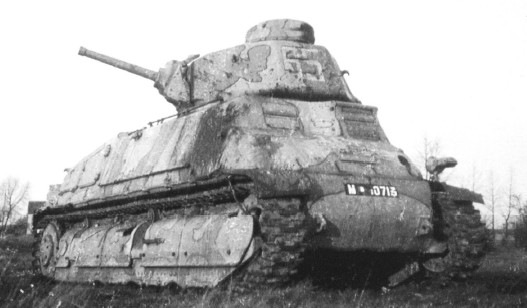
The SOMUA S35 was a French Cavalry tank of the Second World War. Built from 1936 until 1940 to equip the armoured divisions of the Cavalry, it was for its time a relatively agile medium-weight tank, superior in armour and armament to both its French and foreign competitors, such as the contemporary versions of the German Panzerkampfwagen III. It was constructed from well-sloped, mainly cast, armour sections, that however made it expensive to produce and time-consuming to maintain.
The hull was cast in four parts – a world first – and the turret was cast as well. The maximum thickness of the hull and turret armour was 47 and 40 mm (1.85/1.5 in) respectively. The turret was derived from the B1 heavy tank, but with an enlarged turret ring. The medium-barrel SA35 47 mm (1.85 in) in the turret was efficient against most German and Soviet tanks of the time and a mix of 90 AP and 28 HE shots was carried. There was also a coaxial 7.5 mm (0.295 in) Reibel machine gun with 2,250 rounds. All S35 units were scheduled to be equipped with radio, but as ER28 production never reached the required level, only one tank of five was equipped, despite the fact that many of them included an antenna. Crew was 3 – a driver, the tank commander/gunner and a radio operator. As with the B1, the commander was expected to direct the tank while also aiming, loading and firing the 47 mm SA 35 main gun.
Engineer Eugene Brillé worked on the suspension, inspired by the suspension used on the Skoda LTvz. 35, with eight road wheels on four bogies with leaf spring and a large torsion wheel. The initial tracks were 75 mm (2.95 in) wide, with 144 links, later 103 with enlarged pieces. The rear engine was side by side with two self-feeding fuel tanks. The crew was protected by a thick firewall bulkhead. The V8 SOMUA engine designed by engineer Javier-Sabin developed about 200 bhp and used a double filling tank system which at times caused some problems with inexperienced crews. Overall, the S35 was regarded as the most potent medium tank of its day. It is said that the US Ordnance studied the S35 for its construction aspects which helped later to design the Sherman.
Somua S 35 Production
The preliminary design was ready in September 1934, definitive plans in October 1934, just as construction began. The first prototype was ready in April 1935, undergoing successful trials until August of that year. The model was named after its first year of production. A preseries model was to be tested until January 1936 with the new APX1 turret, with production scheduled to start in March.
However, the S35 had several flaws, the first of which was a common issue among French tanks. The commander was still overloaded and the turret still lacked hatches, mostly due to budgetary reasons, which caused the same commander to sit completely outside of the turret in order to get a good view. Other flaws were maintenance-related. The cast-steel modules didn’t facilitate access to the suspension, which made maintenance and repair time-consuming. The cost per unit was high and only limited numbers of this excellent medium tank were produced. By the 1st of September, 1939, 246 had been delivered, and only 288 were in service in May 1940. But by June 1940 some 430 had been built. Production was then halted for the more advanced SOMUA S40. Due to French needs, a Polish order was declined. However, for political reasons a small Finnish order was accepted, with 50 Somua 35’s delivered to Finland in early 1939.
The Finnish Export Order – Somua S 35
In early 1939, for purely political reasons and in the face of some heated opposition from the French Army, the sale of 50 Somua 35’s to Finland was approved – out of approximately 150 which had been produced by that date. Worse from the French Army’s point of view was that these 50 were to be delivered immediately from stocks of the Somua S35 in hand and about to be handed over to the Army. Despite the at times vociferous opposition from within the French Army, the sale and handover was approved.
The sale had it’s origins in the large French government loan (approximately $15,000,000 US Dollars) made to Finland in 1937 for the purchase of military equipment. While the financing was available, the Finns had been somewhat selective about the equipment and weapons ordered from the French, with the result being that by late 1938, there was still considerable unspent funding. The triumvirate responsible for Finnish defence spending had decided, after the bombshell decision on the fate of Czechoslovakia in October 1938, that Finland must accelerate her defensive armaments build up at almost any cost.
After some debate, the Finnish government had almost unanimously allocated additional funds to defence purchasing for the remainder of 1938 and very substantially increased the defence budget planned for 1939. The decision was also made that everything possible must be done to purchase critically needed armaments, including using the unspent loan financing still available from the sizable French and US Loans. The Somua S35, perhaps the best tank in the world at the time, was near the top of the defense shopping list, as it were. The Finns by now had some considerable experience in dealing with French politicians and it was obvious what needed to be done to ensure Finland got the wanted Somua S35’s.
Some judicious (and not inconsiderable) funds were expended on greasing the palms of French politicians and a number of influential voices within the French Army and within weeks, the sale had been approved. The end result was that 50 Somua S35’s were offloaded in Turku in April 1939, following which they would be used to form a second Erillinen Pansaaripataljoona (Separate Tank/Panzer Battalion). In Finnish hands, the Somua S35’s fought very effectively to their strengths. The one-man turret was a major limiting factor, but in the largely defensive fighting on the Isthmus in which the Somua S35’s would fight, this was not so much of a disadvantage as it would be in more mobile or offensive fighting. Also, the high velocity SA35 47 mm gun proved to be very effective against Red Army tanks.
The Red Army made no attempt to outmaneuver the Finns, instead relying on sheer numbers and massed wave attacks of tanks and infantry to overcome the Finnish defences. Unfortunately for the Red Army, this was the war the Finns had planned to fight, with doctrine, tactics and training geared to counter the Red Army’s tactics (or lack of them) and strengths. The result was an ongoing slaughter.
A company of Somua 35’s, well dug in and covering each other, with prepared positions to fall back on, equipped with effective radios and coordinating with well-trained infantry, anti-tank guns and artillery (and with close air support available, weather permitting) time and again decimated attacking Red Army forces before falling back to the next line of pre-prepared defensive positions and repeating. The Somua’s armour seemed impervious to the guns of the lighter Soviet tanks – and the Finns would use this to advantage time and again in their limited objective counter-attacks.
The Somua S35-equipped Erillinen Pansaaripataljoona emerged from the defensive fighting on the Karelian Isthmus over the winter of 1939-1940 virtually unscathed, although some losses did occur. Further losses occurred during the Spring 1940 offensive down the Karelian Isthmus and more in the fighting on the outskirts of Leningrad, as the photo on the right of two knocked out Finnish Army Somua S35’s illustrates. Again, in these actions the Finnish Army used their limited numbers of Somua S35’s carefully and to their strengths in well-coordinated actions which kept losses minimal. The surviving Somua S35’s remained in use with the Finnish Army until 1943, when they were retired from active service and used as training tanks after being replaced with US-supplied Lend-Lease tanks. The remaining Somua S35’s were retired completely and scrapped in 1946.
SOMUAs S35 and S40 in action in France
In May 1940, the bulk of the S40 force was allocated to the 1st Amy deployed in Belgium. Because of the lack of support and a weak organization when compared to the German Panzerdivisions, these units performed with high losses, but with some successes, most of them as a result of the S35’s armor and firepower. The battle of Hannut (May 12-14), the largest tank battle of 1940, occurred between six armored divisions, a clash of nearly 1,700 tanks and armored vehicles. Despite tactical victories at strong-points, it was a strategic failure for the French defence – the Germans systematically outmaneuvering the French, gaining local firepower superiority and with excellent communication and support. The French “by the book” tactics proved hopelessly obsolete.
On another occasion, on May, 17, Colonel De Gaulle’s 4th DCR, comprising many S35’s as well as Hotchkiss, Char B1 and Renault tanks, tried to stop the German advance at Laon and Montcornet. Although they gained momentum and local successes, even taking hundreds of German prisoners, the Luftwaffe and German Flak 88 mm (3.46 in) quickly deployed and used as antitank batteries for the first time in the war, crushed any further progress. Many S35s of the remaining forces fought to prevent three German Panzerdivisions from approaching Dunkirk. They were destroyed or ultimately abandoned, running out of ammunition and fuel. Later in June, other S35’s fought in Weygand’s so-called “strongpoints”, which were outmaneuvered once again, hammered by artillery and the Luftwaffe, and eventually forced to surrender one by one.
Somua S35’s after the fall of France
The remaining S35s, perhaps a hundred in all, which escaped to Vichy France, were allocated to the Vichy regime for police duties and most were transferred to North Africa. Most of the S35s remaining in occupied France were taken over by the Germans, some sources mentioning about 250 to 290. Most of these fought eventually on the Eastern Front where they were outclassed by Soviet KV-1s and T-34s. In December 1944, a single German unit was still equipped with a handful of S35s but by this time they were hopelessly outclassed.
Char B1 bis (781 built between 1935-1940)
The Char de bataille was Col. Estienne’s concept. The French “father of tanks” wrote a memorandum (Mémoire sur les missions des chars blindés en campagne) in 1919, full of war experience, tactical reports and theoretical concepts of mechanized warfare, notably the proper use of different types in the offensive. The “char de bataille” (“battle tank”) was a heavy tank, near to the “char de rupture” or “breakthrough tank”, but the former was more a dual-purpose (infantry support and antitank) machine than the “char de rupture”. The latter concept gave birth to huge the FMC F1, with the sole purpose of terminating fortifications.
This duality was at the very core of the idea, shaping the many prototypes which followed in response. In 1921, the project was studied by a commission led by General Edmond Buat. First specification was for a low-cost self-propelled artillery, 25 mm (0.98 in) of armor and some machine-guns in turrets. Maximum metric weight was 30 tons. The project evolved and the machine-gun turret was equipped with an antitank 47 mm (1.85 in) gun. The main gun was a 75 mm (2.95 in) howitzer, in a low hull sponson.
Industrial rivalry in the past had delayed several projects, including the FCM 2C, so Estienne was poised to create a formal agreement, submitted to the industrialists involved, free to share their plans, with the promise of no less 1000 orders. The Army was then to choose between the projects and various patents to compose their model, built by all. The four companies involved in the project were Renault (SRA), Schneider (SRB), FAMH (Saint Chamond) and FCM (Forges et Chantiers de la Méditerranée) with the FCM 21.

The prototype Schneider SRB – six metres long, 228 centimetres high and 2,5 metres wide with a 47mm gun.
The four projects, one for each company, were submitted to the commission on 13 May 1924 at Atelier de Rueil. The twenty kilometer test course proved too much for them, showing the haste of their conception. The commission, over the supervision of Estienne, choose the SRB as a base. The SRB (Schneider project) weighed 18.5 tons, was 6 meters long (19.7 ft), with modified FT17 tracks, an antitank 47 mm (1.85 in) gun, Renault six-cylinder 180 hp engine, with hydraulic Naëder transmission from the Chaize company combined with a Fieux clutch and Schneider gear box, a speed of 18.5 km/h (11.5 mph) and a 370 l fuel tank giving a 370 km (230 mi) autonomy. This prototype then received many modifications, including the 75 mm (2.95 in) howitzer, new Holt-type tracks, the FAMH suspension, track tension wheel and a small gangway to access to the engine, with 40 mm (1.57 in) armor.
Design of the Char Bis B1
The design process of this modified SRB led to the 1926 “tracteur 30”. The plans were made by Schneider’s chief engineer, revised by the STCC (Section Technique des Chars de Combat). A mockup was built by Renault and three prototypes were to be built by the companies involved, with some modifications by the new 1926 “direction de l’infanterie”, changing it to a primarily infantry support tank. Modifications of the design included no AT weapon, lower speed, 22 tons max and radio for coordination.
The three prototypes of the “B” serie (n°101, 102 and 103) were ready by 1929-30. They differed by their engine, clutch, transmission and served both for technological and tactical experiments, at the champ de Châlons, forming the “Détachement d’Experimentation” unit in 1931. They were extensively used in maneuvers until 1934, each time with some modifications by the Atelier de Reuil near Paris, to meet new requirements and army specifications. In the end, the B1 received its final turret, with the low velocity 47 mm (1.85 in), and coaxial Reibel machine-gun.
Like the 1924 prototypes, it had a very large track, inspired by earlier famous British models. Armor also protected the suspension and the hull was riveted. The Renault inline 6 cylinder 16.5 litre petrol engine was chosen, which provided 9.7 bhp/ton, the power was transmitted by a double differential steering system, 5 forward, 1 reverse gear. Suspension was in the form of bogies with a mixture of vertical coil and leaf springs. Both early and final turret designs (APX1) were one-man only.
The Char B1’s original specification was for a self-propelled gun able to destroy enemy infantry and artillery. The main weapon of the tank was intended to be its 75 mm howitzer, and the entire design of the vehicle was directed to making this gun as effective as possible. When in the early 1930’s it became obvious that the Char B1 also had to defeat counterattacking enemy armour, it was too late for a complete redesign. The solution was to add the standard cast APX-1 turret which also equipped the Char D2. Like most French tanks of the period (the exception being the AMC34 and the AMC35) the Char B thus had a small one-man turret. Today this is typically seen as one of their greatest flaws
Production: The B1
Production started in 1935, with Renault building 182, AMX – a Schneider subsidiary – 47, FCM 72 and FAMH 32. At 1.5 million francs apiece it was by far the costliest tank ever built en masse. Consequently, the original order of 1000 was reduced to 400. This further increased the tension between the two doctrinal schools which then had influence, one professing the use of a few, heavily armored battle tanks while the other advocated the use of swarms of light tanks. Almost ten light Renault tanks could be built for the price of a single Char B1. This exasparated men like Colonel Charles de Gaulle, who wanted to build more of the medium Char D2 at a third of the cost of the Char B1 bis, but armed with the same 47 mm gun.
As the few, even more expensive and now largely obsolete FCM 2C’s were kept out of real operations, the B1 became the main French “char de rupture”, a breakthrough tank held in specialized units. Operational capabilities were limited by their high fuel consumption, which in turn limited their range and condemned them to be used as a strategic reserve. In fact they formed the “Divisions Cuirassées de Réserve” (DCR) with limited strategic flexibility, intended for the second phase of the assault.
The B1 had some shortcomings which had to be dealt with. An obvious lack of antitank firepower, with its low velocity L27/6 SA34 47 mm (1.85 in), which was only given APHE rounds (high explosive), capable of defeating 25 mm (0.98 in) of armor. The 75 mm (2.95 in) SA35 ABS L17.1 howitzer could fire HE and APHE rounds, only suitable against fortifications, with a poor traverse of only one degree. The aiming was given to the driver’s abilities with the Naëder hydraulic precision transmission. It was served by the radioman and the commander, who was also given the task of aiming and firing the turret 47 mm (1.85 in) gun. Communication was assumed by an ER53 radio telegraphy set, which worked with Morse code only. There was a small corridor, right on the rear, giving access to the ammunition reserve, next to the engine. The main access door was on the right side. The suspension system was rather complicated, made of three main bogies, sprung by vertical coil springs, each supporting two others, with a pair of road wheels. Production of the B1 was very slow. Only 34 machines were delivered until July 1937. By then, there was serious consideration given to an upgrade, which led to the B1 bis.
The upgraded B1 bis and B1 ter
The B1 bis was a modernization of the type, with an emphasis on anti-tank capability and protection. The armor was uprated to 60 mm (2.36 in), and a new APX4 turret with a longer barrel (L/32) SA 35 47 mm (1.85 in) gun was mounted. To cope with the added weight (now 31 tons) a new engine was fitted, a V12 Renault capable of 307 bhp (229 kW). 35 of the first series were retrofitted with the new engine. Autonomy was limited to only 180 km (110 mi). There had been some attempts of towing an extra 800 litre fuel tank, but it never realized. At cruise speed reserves were exhausted in just 6 hours. A larger left air intake was fitted. Ammunition storage was improved between the beginning and the end of the production, from 62 to 72 47 mm (1.85 in) rounds, but still, no AP shells. Production started in April 1937 and stopped in June 1940. By then, 377 had been delivered out of an order of 1144, but only 129 in September 1939. In exercises, the complex and advanced hydrostatic steering Naëder system proved difficult to use and costly, betrayed by other technical elements like a porous bronze housing and feeble seals causing significant losses of castor oil. The TSF was not practical as the tanks needed to be at rest to communicate. No tactical coordination was possible on the move. The costly turret was slower to produce than the hulls and three B1 bis were ultimately put in service without turret, as gun carriages.
The B1 ter was a late attempt to radically improve the design. The main features were new 75 mm (2.95 in) armor welded with slopes to the hull, a new 350 bhp engine to deal with this added weight (36.6 tons) and some simplification in the design for mass-production in 1940, like the omittance of the Naëder transmission. A rearranged interior allowed a fifth crew member to be carried, as a mechanic. The main howitzer received better traverse, 5 degrees higher. Only two prototypes were ready by June 1940. Production never started.
The B1 had some additional flaws as well, which never helped its performances. High consumption issue, which was aggravated by any aiming of the main howitzer, was never solved. The absence of an efficient compass orientation and no internal communication system were also resented in operations. The one-man APX-1 turret was also cramped and ergonomy was poor and the feebly armored cupola had inadequate means of vision. Plus, the barrel pointing device was quickly deregulated. Many other issues were never solved because of the delays. The most serious was of course disastrous tactical management. B1s were “wasted” at individual defensive spots, many were simply outmaneuvered. But despite all this, the B1s were still, tank to tank, formidable machines, which proved very effective in single actions.
The Finnish Export Order – Char B1
As with the Souma S35 order, in early 1939, for the same (ahem!) reasons and in the face of the same heated opposition from the French Army, the sale of 60 Char B1 bis’s to Finland was approved – out of approximately 150 which had been produced by that date. As with the S35’s, these 60 were to be delivered immediately from stocks of the Char B1’s already in service with the French Army. And as with the S35’s, despite vociferous opposition from within the Army, the sale and handover was approved at the highest political levels.
The Souma S35 was near the top of the Finns defense shopping list and the Finns actually wanted more of these than they were sold, but the numbers that even heavily-bribed French politicians were prepared to sell were limited and instead of the requested S35’s, the balance of the numbers requested was met by a French political decision to offer the Finns the Char B1 bis’s instead. The fact that the high cost of the Char B1 bis’s resulted in rather more in the way of bribes being paid may have also had a bearing on the decision but this was a situation where beggars could not be choosers. The end result was that in addition to the 50 Souma S35’s offloaded in Turku in April 1939, some 60 Char B1 bis’s were also delivered. These 60 Char B1 bis’s would form the third Erillinen Pansaaripataljoona (Separate Tank/Panzer Battalion) in service with the Finnish Army in the Winter War.
In Finnish hands, the Char 1b bis’s fought a lethal defensive fight. The tanks thick armour made it next to impervious to Soviet tank and anti-tank guns and it’s firepower (in particular the high-velocity 47mm gun) easily ripped apart the lighter Soviet tanks used in the early months of the Winter War. Again, as with the Souma S35, the one-man turret was a major limiting factor, but in the largely defensive fighting on the Isthmus, this was not so much of a disadvantage as it would be in rather more mobile or offensive fighting. The Finns had immediately on arrival fitted the French-supplied tanks with new-model Nokia voice radios and again, the vastly improved communction, when combined with the Finnish Army’s pervasive portable radio network, meant tight cooperation was possible both between individual tanks and between panssari units and the attached infantry, anti-tank batteries and artillery with which they operated.
To the great benefit of the Char B1 bis-equipped panssaripataljoona, the Red Army fought the war that the Finnish Army had developed the doctrine to fight. Doctrine, solid preparation and training, training and more training paid off over those early weeks of defensive fighting as the Char 1B battalion slowly fell back down the length of the Isthmus to the Mannerheim Line, while repeatedly causing heavy casualties to the attacking Red Army armor. Through to the end of the war, the Char B1 would be the Red Army’s most feared enemy tank, a mechanized nightmare which time and again annihilated the Russian tank units with which it was engaged. The lack of Red Army survivors to pass the experience on meant that in general, the Red Army failed to learn any lessons from these devastating encounters.
In one defensive counter attack in January 1940 for example, a single troop of six B1’s, working together with two companies of infantry, artillery and close air support and fighting from carefully prepared defensive positions initially severely mauled a major Red Army assault. As the Red Army units pulled back, the Finnish tanks attacked frontally and completed the annihilation of an entire Red Army Tank Regiment, with Finnish infantry capturing six Soviet tanks which had been abandoned by their crews. These were then driven back to the Finnish lines as the Finns withdrew. All the B1’s were hit numerous times but suffered no major damage in the action. Time and again the Finnish Army would carry out such counter-attacks on slowly advancing Red Army units, taking advantage of the Red Army’s lack of cohesion between Tanks, Infantry and Artillery to inflict massive losses (and not incidentally, capturing much Soviet equipment in the process). Combining these tanks, excellent communications and the outstanding artillery fire control and artillery concentration methods used by the Finns, the Soviet spearheads found themselves smashed to pieces again and again.
Through the entire length of the Winter War and wherever they were found, the small number of Finnish Army’s Char 1B’s ruled the battlefield, only losing the occasional tank to heavy indirect fire from Soviet artillery. The Char 1B bis-equipped Erillinen Pansaaripataljoona emerged from the defensive fighting on the Karelian Isthmus over the winter of 1939-1940 virtually unscathed.
Heavier losses occurred during the Spring 1940 offensive down the Karelian Isthmus where the heavily armoured Char 1B’s often took the lead in major attacks, as a consequence suffering rather more heavily than they had in the purely defensive fighting of earlier months. They also suffered rather more losses in the fighting on the outskirts of Leningrad. While they were used carefully and to their strengths in well-coordinated actions, losses were no longer minimal and by the end of the Winter War, only 15 of the 60 Char 1B’s acquired from the French remained in action.
The B1 bis in action with the French Army
Despite its obsolete features, low autonomy and speed, the B1 was hard to stop. Its most formidable assets were its huge armor and good firepower, then unmatched in the west. The 60 mm (2.36 in) frontal armor was sloped, which mean it was near 80 mm (3.15 in) effectively. There were no real weak spots, and this invulnerability helped the B1 to close on targets, then destroy it with the turret 47 mm (1.85 in) or the brute force of the howitzer HE shells. For this reasons, the B1 was the Wehrmacht’s most feared enemy tank, a mechanized nightmare which caused heavy casualties by itself during the few fights during which it was engaged. The Germans never again experienced such losses in tank to tank combat until the fall of 1941, when encountering the Soviet KV-1 and T-34.
The Panzer I and II were absolutely harmless to the B1, and the Panzer III with its thin armor and 37 mm (1.46 in) gun, presented no serious threat the the French B1. As for the Panzer IV, it had only 20 mm (0.79 in) protection (Ausf. A, 30 mm (1.18 in) (Ausf. B and C) and 50 mm (1.97 in) (Ausf. D). It’s standard gun was the low velocity, short barrel 75 mm (2.95 in) KwK 37 , which was only effective at short range. For this reasons, the Panzer IV barely presented a real threat except in close, real time coordination with other vehicles. The same could be said about most German antitank guns of the time. The famous standard-issue “door-knocker” Pak 37 and even the Pak 40 were harmless. Contrary to common opinion of the time, the large ventilation exhaust panel was indirectly 55 mm (2.17 in) strong and never presented a weak point.
When the war broke out in September 1939, there were perhaps 180 operational B1 and B1 bis in all. They were used for the Sarre offensive, a short-lived burst without serious opposition, with a massive force of 41 divisions and 2400 tanks. The aim was to distract and divert German forces from Poland, France’s ally. After slowly penetrating 8 km (5 mi) into enemy territory, the entire force withdrew by order of General Gamelin into the security of the Maginot line. Several officers, including Henri Giraud and Charles de Gaulle, wildly protested. In effect, the Germans would have been in great danger and the Rhine was in reach. But Gamelin then was so confident about the famous fortified line that he saw any large-scale offensive to be a useless waste of material and men.
During the “Phoney War”, all B1s were gathered in massive infantry support divisions, the “division cuirassés de réserve” or DCR, which were tactically committed in the second phase of any assault, the first being led by cavalry tanks like the SOMUA S35. No tanks were sent in Norway, but the real deal began in May 1940. Three DCR, comprising each 69 tanks, were mobilized. Part of the 37th Bataillon de Chars de Combat, it comprised only B1s, were all rearmed with long-barrel SA 35 guns in May 1940 (turret designation APX1A). After the German invasion began, four new DCR of 52 B1s were constituted, as well as five Compagnie Autonome de Chars (autonomous tanks companies), with 56 B1s in all, plus 34 more in the 28 BCC (Bataillon de chars de combat). All B1s were reequipped with phonic versions of the ER53 radios, and command tanks received ER55 long-range radios.
B1 tanks were used (and lost) during the first phase of the operations, especially the first week. Most counter-offensives against Guderian’s “run to the sea” counted at least several B1s. Without air support these moves were doomed to failure against the quick and lethal Stuka attacks. Bad tactics of course brought these precious tanks to inept, hasty defensive “plugs” in the defensive lines, most of the time, ending in pure waste. In some case, the B1’s extraordinary sturdiness allowed some success, notably the counter-attacks at laon and Moncornet led by Col. De Gaulle, and stiff resistance like at Hannut and particularly Stonne. During these events, some individual B1’s blocked by themselves the German advance, inflicting horrendous casualties.
In a particular case, a single B1, Eure, commanded by Captain Pierre Billotte, attacked frontally and destroyed single-handedly thirteen Panzer IIIs and IVs, and then withdrew, while being hit 140 times. During two days, B1 tanks from the 3rd Division Cuirassée de Réserve literally ruled the battlefield at Stonne, destruction coming only due to German overwhelming attacks against single tanks and excellent communication, air strikes and indirect fire (by German howitzers). Some B1’s also broke down or ran out of ammunition and petrol. The last surviving B1’s were mixed with other tanks in support of the so-called “hedgehogs”, which fell one after the other in June 1940. By the 26th of June 1940, the campaign was over.
Two Stories about the Char B1 bis during the Battle of Stonne (15-18 May 1940)
Eure: The 1/41e BCC outflanks Stonne by the north-west but capitaine Billotte is hampered by several cliffs and important slopes. He has to move to the right, arriving in Stonne itself (from the north-west) before the battalion commander. The B1bis “Eure” arrives nose to nose with 13 German tanks of Pz.Rgt.8 (10.PzD) in column in the main street of the town. The first tank is only at 30m. Billotte orders the driver (sergent Durupt) to target the last tank with the 75mm SA35 hull gun while he destroys the first tank with the 47mm SA35 turret gun. The first shots destroyed simultaneously the first and the last German tank of the column, the others could hardly move. In several minutes, the B1bis “Eure” advances in the street and neutralize the 11 remaining tanks while numerous shells are hitting the armor of the B1bis without penetrating it. 2 Panzer IVs and 11 Panzer IIIs are reported as being destroyed (It is however not 100% sure that among them there were not several wrecks from the previous day). Billotte crosses the whole town and destroys also two 3.7cm AT guns next to the “Pain de Sucre”. The armor of the B1bis revealed later to be scattered with 140 impacts and gouges, none of the projectiles penetrated the armor according to the war diary of the 41e BCC. One can see here a kind of small reversed “Villers Bocage”. The “Eure” was scuttled on the 13th June as the drive wheels were unable to be used.
Ricquewihr: On May 16, around 17h00, the Char B1bis “Ricquewihr” (commanded by Lieutenant Doumecq or Domercq ? Apparently the second name is the right one but the first one can be found in several books) from 49e BCC attacks towards Stonne and encounters a German infantry column, which fires at the tank with infantry weapons including anti-tank rifles, without effect. The B1bis crushes its way through the German troops and pushes into the town defended by the Schützen-Regiment 64. When the German soldiers saw the bloody tracks of the tank they fled in panic and abandoned Stonne which remained unoccupied for the night. After that action Domercq was nicknamed “the butcher of Stonne” by his comrades. Ricquewihr will be heavily involved in the combat at Tannay over May 23-24. The B1bis “Ricquewihr” will be the last surviving tank of the 3e DCr, abandoned on June 18, at Sombernon north-east of Dijon, the weapons having been previously scuttled by the crew. At the end of 1942, Domercq (former commander of the tank and living in Paris) is in a pub on the Poincaré Avenue where a German tanker shows several photos to his friends. Domercq recognize his former tank, the “Ricquewihr”. The German explains that he is now the commander of this tank, that he has fired with it and that it was a good tank. He will be taking the tank and the rest of the crew to the Russian front.
B1/B1 bis fate: German and French service
The Germans captured hundreds of tanks, including no less than 161 B1 bis tanks, later pressed into service as the Panzerkampfwagen B-2 740(f). Sixty were converted into flamethrower versions (Flammwagen auf Panzerkampfwagen B-2 (f)), and sixteen to carry the 105 mm (4.13 in) howitzer. A single unit was equipped only with B1s, the Panzer-Abteilung 213, stationed in the British Channel Islands. One of these ended at the Bovington museum, repainted in French colors. 17 units in all received modified B1s, as they saw service in the Balkans (March-April 1941) and the Eastern Front, where their armor and armament initially proved well-adapted against Russian heavy tanks. By 1944, they were all gone.
Those stationed in France took part in the defense of Normandy, and others were stationed in support of the German units defending Paris. In August 1944 some were captured by insurgents and used in action by local FFI units. In 1945, German pockets of resistance in France, especially those on the western coast, were left to the FFI and the regular French 1st army. Edmond Voillaume’s 2nd Company was equipped with 19 B1s, which decisively took part in the reduction of the Royan pocket, and La Rochelle. B1s were also part of the 13th Dragoon Regiment, which took part in operations in Alsace and Southern Germany. They were stationed after V-day in the French occupied zone, until the unit was disbanded in 1946.
Surviving Char B1’s
Today eleven vehicles survive, one Char B1 and ten Char B1 bis. The last surviving Char B1 can be seen at the “Association pour la Sauvegarde du Patrimoine Historique et Militaire” (ASPHM), near Strasbourg, in France. It was previously at the Fort de Seclin. It is in a bad condition, with parts like the main gun missing. It was salvaged from a firing range, but will be restored by the owner.
Ten Char B1 bis tanks can be seen in various places in Great Britain and in France:
- One is on display at the Bovington Tank Museum, England. It was modified for German service as the B2 variant.
- Three are in the Musée des Blindés in Saumur, France. One, Flandres, is in running condition, while another, Rhône, is on permanent display in the museum. A third, a mine roller tank, is in storage.
- One is serving as a monument in the town of Stonne, France, where during the Battle of France the B1 tanks of the 3rd Division Cuirassée de Réserve played a key role in delaying the advance of the 10th Panzer Division for two days.
- Three are owned by the ASPHM, which bought one of them at the same time as the B1, from the Fort de Seclin. This B1 bis is also in a bad condition, with parts, including the main gun, missing. Salvaged from a firing range, it is intended for restoration by the owner. The two others were acquired in 2009 and are very badly damaged. They will most likely be used as “organ donors” in order to restore the B1 and one of the B1 bis tanks. One of the two B1 bis wrecks was identified as being n° 243 Intrépide, which belonged to 8th BCC and was put out of combat on 1 June 1940, at Moreuil.
- Two are on display at the 501st-503rd Tank Regiment at Mourmelon-le-Grand, France. One of these tanks was previously on display at the ERGMEB, Gien.
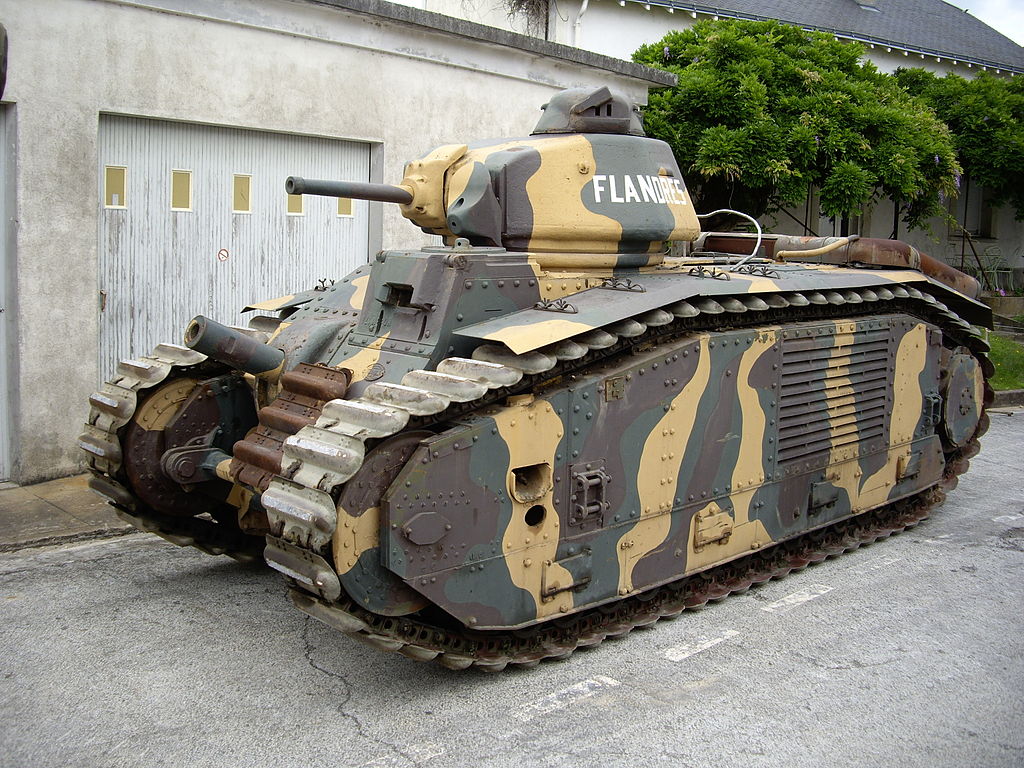
Char B1 bis Flandres at the Musée des Blindés in Saumur, France. This is the sole B1 in running condition today.
Previous Page: British Tanks of the Interwar Decades
Next Page: Czech Tanks of the Interwar Decades
 Copyright secured by Digiprove © 2014 Alternative Finland
Copyright secured by Digiprove © 2014 Alternative Finland


